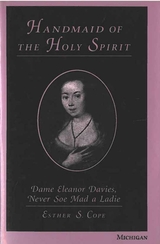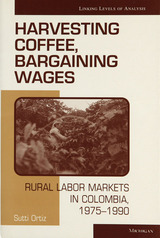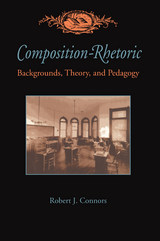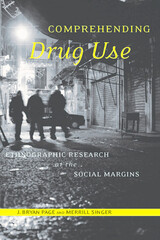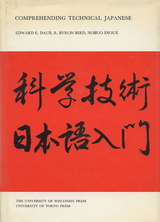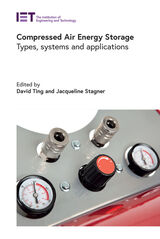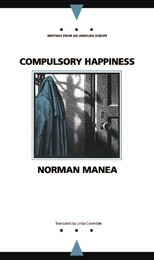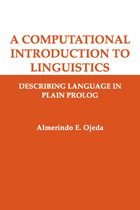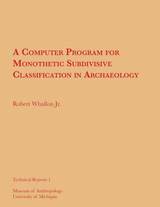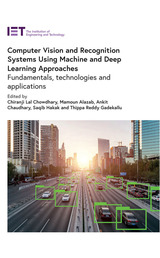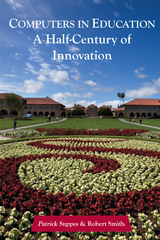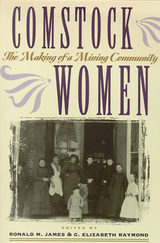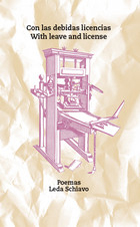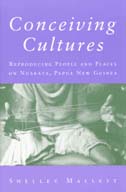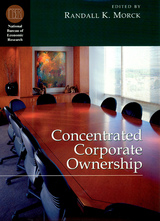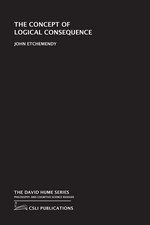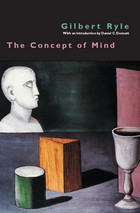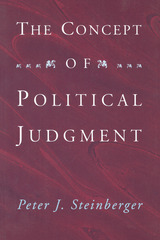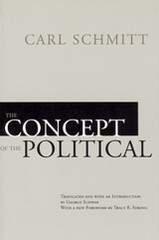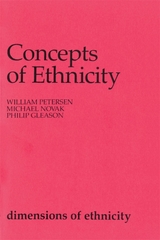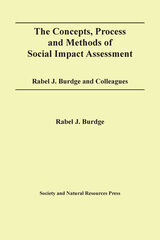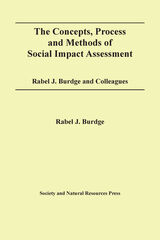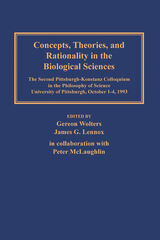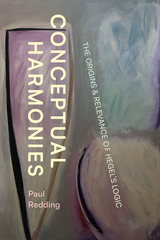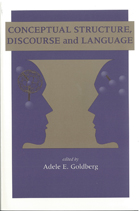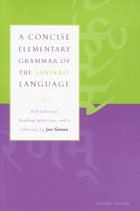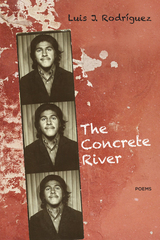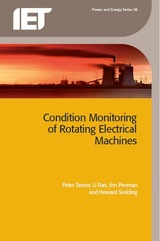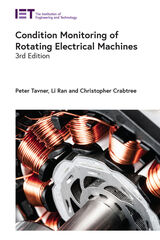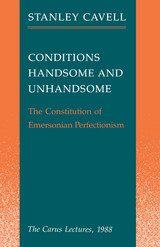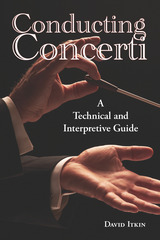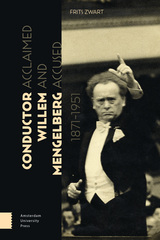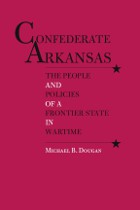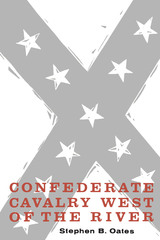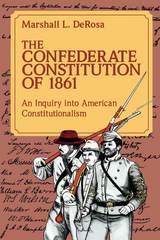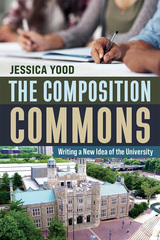 The Composition Commons: Writing a New Idea of the University
Jessica Yood
Utah State University Press, 2024 The Composition Commons delivers a timely take on invigorating higher education, illustrating how college composition courses can be dynamic sites for producing a democratic, just, and generally educated public.
Jessica Yood traces the century-long origins of a writing-centered idea of the American university and tracks the resurgence of this idea today. Drawing on archival and classroom evidence from public colleges and universities and written in a lively autoethnographic voice, Yood names “genres of the commons”: intimate, informal writing activities that create peer-to-peer knowledge networks. She shows how these unique genres create collectivity—an academic commons—and calls on scholars to invest in composition as a course cultivating reflective, emergent, shared knowledge. Yood departs from movements that divest from the first-year composition classroom and details how an increasingly diverse student population composes complex, evolving cultural literacies that forge social bonds and forward innovation and intellectual and civic engagement.
The Composition Commons reclaims the commons as critical idea and writing classroom activities as essential practices for remaking higher education in the United States.
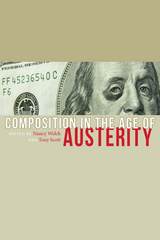 Composition in the Age of Austerity
Nancy Welch
Utah State University Press, 2016 In the face of the gradual saturation of US public education by the logics of neoliberalism, educators often find themselves at a loss to respond, let alone resist. Through state defunding and many other “reforms” fueled by austerity politics, a majority of educators are becoming casual labor in US universities while those who hang onto secure employment are pressed to act as self-supporting entrepreneurs or do more with less. Focusing on the discipline of writing studies, this collection addresses the sense of crisis that many educators experience in this age of austerity. The chapters in this book chronicle how neoliberal political economy shapes writing assessments, curricula, teacher agency, program administration, and funding distribution. Contributors also focus on how neoliberal political economy dictates the direction of scholarship, because the economic and political agenda shaping the terms of work, the methods of delivery, and the ways of valuing and assessing writing also shape the primary concerns and directions of scholarship. Composition in the Age of Austerity offers critical accounts of how the restructuring of higher education is shaping the daily realities of composition programs. The book documents the effects and implications of the current restructuring, examines how cherished rhetorical ideals actually leave the field unprepared to respond effectively to defunding and corporatizing trends, and establishes points of departure for collective response.
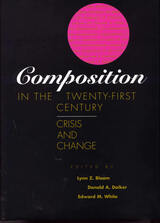 Composition in the Twenty-First Century: Crisis and Change
Edited by Lynn Z. Bloom, Donald A. Daiker, and Edward M. White
Southern Illinois University Press, 1997 The essays in this book, stemming from a national conference of the same name, focus on the single subject required of nearly all college students—composition. Despite its pervasiveness and its significance, composition has an unstable status within the curriculum. Writing programs and writing faculty are besieged by academic, political, and financial concerns that have not been well understood or addressed. At many institutions, composition functions paradoxically as both the gateway to academic success and as the gatekeeper, reducing access to academic work and opportunity for those with limited facility in English. Although writing programs are expected to provide services that range from instruction in correct grammar to assisting—or resisting—political correctness, expanding programs and shrinking faculty get caught in the crossfire. The bottom line becomes the firing line as forces outside the classroom determine funding and seek to define what composition should do. In search of that definition, the contributors ask and answer a series of specific and salient questions: What implications—intellectual, political, and institutional—will forces outside the classroom have on the quality and delivery of composition in the twenty-first century? How will faculty and administrators identify and address these issues? What policies and practices ought we propose for the century to come? This book features sixteen position papers by distinguished scholars and researchers in composition and rhetoric; most of the papers are followed by invited responses by other notable compositionists. In all, twenty-five contributors approach composition from a wide variety of contemporary perspectives: rhetorical, historical, social, cultural, political, intellectual, economic, structural, administrative, and developmental. They propose solutions applicable to pedagogy, research, graduate training of composition teachers, academic administration, and public and social policy. In a very real sense, then, this is the only book to offer a map to the future of composition.
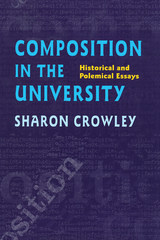 Composition In The University: Historical and Polemical Essays
Sharon Crowley
University of Pittsburgh Press, 1998
Composition in the University examines the required introductory course in composition within American colleges and universities. Crowley argues that due to its association with literary studies in English departments, composition instruction has been inappropriately influenced by humanist pedagogy and that modern humanism is not a satisfactory rationale for the study of writing. Crowley envisions possible nonhumanist rationales that could be developed for vertical curricula in writing instruction, were the universal requirement not in place.
Composition in the University examines the required introductory course in composition within American colleges and universities. According to Sharon Crowley, the required composition course has never been conceived in the way that other introductory courses have been—as an introduction to the principles and practices of a field of study. Rather it has been constructed throughout much of its history as a site from which larger educational and ideological agendas could be advanced, and such agendas have not always served the interests of students or teachers, even though they are usually touted as programs of study that students “need.”
If there is a master narrative of the history of composition, it is told in the institutional attitude that has governed administration, design, and staffing of the course from its beginnings—the attitude that the universal requirement is in place in order to construct docile academic subjects.
Crowley argues that due to its association with literary studies in English departments, composition instruction has been inappropriately influenced by humanist pedagogy and that modern humanism is not a satisfactory rationale for the study of writing. She examines historical attempts to reconfigure the required course in nonhumanist terms, such as the advent of communications studies during the 1940s. Crowley devotes two essays to this phenomenon, concentrating on the furor caused by the adoption of a communications program at the University of Iowa.
Composition in the University concludes with a pair of essays that argue against maintenance of the universal requirement. In the last of these, Crowley envisions possible nonhumanist rationales that could be developed for vertical curricula in writing instruction, were the universal requirement not in place.
Crowley presents her findings in a series of essays because she feels the history of the required composition course cannot easily be understood as a coherent narrative since understandings of the purpose of the required course have altered rapidly from decade to decade, sometimes in shockingly sudden and erratic fashion.
The essays in this book are informed by Crowley’s long career of teaching composition, administering a composition program, and training teachers of the required introductory course. The book also draw on experience she gained while working with committees formed by the Conference on College Composition and Communication toward implementation of the Wyoming Resolution, an attempt to better the working conditions of post-secondary teachers of writing.
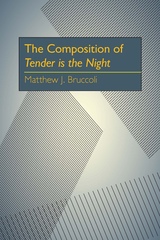 The Composition of Tender is the Night
Matthew J. Bruccoli
University of Pittsburgh Press, 1963
Working with the complete collection of Tender is the Night manuscripts in the Princeton University Library, Matthew J. Bruccoli reconstructs seventeen drafts and three versions of the novel to answer questions about F. Scott Fitzgerald’s major work that have long puzzled critics of modern literature.
In 1934, nine years after the appearance of The Great Gatsby, Fitzgerald permitted publication of Tender is the Night. Disappointed by its critical reception, Fitzgerald suggested that the structure of the novel should be drastically rearranged. In 1951, eleven years after his death, Charles Scribner’s Sons brought out an edition that incorporated Fitzgerald’s changes. Controversy arose over the merits of the two published versions and over the “nine lost years” in Fitzgerald’s life between his two great novels, years of rewriting before publication of Tender is the Night that resulted in six cartons of notes and drafts. After analyzing this wealth of material, Bruccoli reconstructs every working stage in the novel and reaches his own conclusions about which edition is the most valid.
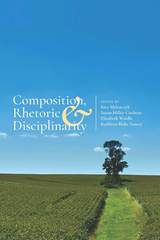 Composition, Rhetoric, and Disciplinarity
Rita Malenczyk
Utah State University Press, 2018 Edited by four nationally recognized leaders of composition scholarship, Composition, Rhetoric, and Disciplinarity asks a fundamental question: can Composition and Rhetoric, as a discipline, continue its historical commitment to pedagogy without sacrificing equal attention to other areas, such as research and theory? In response, contributors to the volume address disagreements about what it means to be called a discipline rather than a profession or a field; elucidate tensions over the defined breadth of Composition and Rhetoric; and consider the roles of research and responsibility as Composition and Rhetoric shifts from field to discipline. Outlining a field with a complex and unusual formation story, Composition, Rhetoric, and Disciplinarity employs several lenses for understanding disciplinarity—theory, history, labor, and pedagogy—and for teasing out the implications of disciplinarity for students, faculty, institutions, and Composition and Rhetoric itself. Collectively, the chapters speak to the intellectual and embodied history leading to this point; to questions about how disciplinarity is, and might be, understood, especially with regard to Composition and Rhetoric; to the curricular, conceptual, labor, and other sites of tension inherent in thinking about Composition and Rhetoric as a discipline; and to the implications of Composition and Rhetoric’s disciplinarity for the future. Contributors: Linda Adler-Kassner, Elizabeth H. Boquet, Christiane Donahue, Whitney Douglas, Doug Downs, Heidi Estrem, Kristine Hansen, Doug Hesse, Sandra Jamieson, Neal Lerner, Jennifer Helene Maher, Barry Maid, Jaime Armin Mejía, Carolyn R. Miller, Kelly Myers, Gwendolynne Reid, Liane Robertson, Rochelle Rodrigo, Dawn Shepherd, Kara Taczak
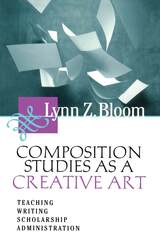 Composition Studies As A Creative Art
Lynn Z. Bloom
Utah State University Press, 1998 Bloom gathers twenty of her most recent essays (some previously unpublished) on critical issues in teaching writing. She addresses matters of philosophy and pedagogy, class and marginality and gender, and textual terror transformed to textual power. Yet the body of her work and this representative collection of it remains centered, coherent, and personal.
This work focuses on the creative dynamics that arise from the interrelation of writing, teaching writing, and ways of reading—and the scholarship and administrative issues engendered by it. To regard composition studies as a creative art is to engage in a process of intellectual or aesthetic free play, and then to translate the results of this play into serious work that yet retains the freedom and playfulness of its origins. The book is fueled by a mixture of faith in the fields that compose composition studies, hope that efforts of composition teachers can make a difference, and a sense of community in its broadest meaning.
Included are Bloom's well-known essays "Teaching College English as a Woman," "Freshman Composition as a Middle Class Enterprise," and many more recent works, equally provocative and insightful.
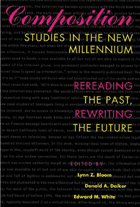 Composition Studies in the New Millennium: Rereading the Past, Rewriting the Future
Edited by Lynn Z. Bloom, Donald A. Daiker, and Edward M. White
Southern Illinois University Press, 2003 A collection of twenty-four essays assessing and challenging the current state of writing instruction, Composition Studies in the New Millennium: Rereading the Past, Rewriting the Future emerges from presentations given at the national Writing Program Administrators conference held at Miami University in Oxford, Ohio, in 2001. Like its acclaimed and widely-used predecessor, Composition in the Twenty-First Century: Crisis and Change, this timely collection by leading scholars in composition studies responds to concerns about the evolution and future of this field of study. Charting new directions, the contributors grapple with seven distinct questions: What do we mean by composition studies—past, present, and future? What do and should we teach when we teach composition? Where will composition be taught, and who will teach it? What theories and philosophies will undergird our research paradigms, and what will those paradigms be? How will new technologies change composition studies? What languages will our students write, and what will they write about? What political and social issues have shaped composition studies in the past and will shape this field in the future? In addressing these queries, the essayists approach composition studies from perspectives ranging from rhetorical to cultural, political to economic, administrative to technological; and they do so with a style and organization appropriate for composition instructors, scholars, and administrators at all levels, from teaching assistants to college presidents. The result is an invaluable vision of the future of composition studies in the new millennium.
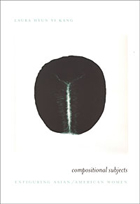 Compositional Subjects: Enfiguring Asian/American Women
Laura Hyun Yi Kang
Duke University Press, 2002 In Compositional Subjects Laura Hyun Yi Kang explores the ways that Asian/American women have been figured by mutually imbricated modes of identity formation, representation, and knowledge production. Kang’s project is simultaneously interdisciplinary scholarship at its best and a critique of the very disciplinary formations she draws upon.
The book opens by tracking the jagged emergence of “Asian American women” as a distinct social identity over the past three decades. Kang then directs critical attention to how the attempts to compose them as discrete subjects of consciousness, visibility, and action demonstrate a broader, ongoing tension between socially particularized subjects and disciplinary knowledges. In addition to the shifting meanings and alignments of “Asian,” “American,” and “women,” the book examines the discourses, political and economic conditions, and institutional formations that have produced Asian/American women as generic authors, as visibly desirable and desiring bodies, as excludable aliens and admissible citizens of the United States, and as the proper labor for transnational capitalism. In analyzing how these enfigurations are constructed and apprehended through a range of modes including autobiography, cinematography, historiography, photography, and ethnography, Kang directs comparative attention to the very terms of their emergence as Asian/American women in specific disciplines.
Finally, Kang concludes with a detailed examination of selected literary and visual works by Korean women artists located in the United States and Canada, works that creatively and critically contend with the problematics of identification and representation that are explored throughout the book. By underscoring the forceful and contentious struggles that animate all of these compositional gestures, Kang proffers Asian/American women as a vexing and productive figure for cultural, political and epistemological critique.
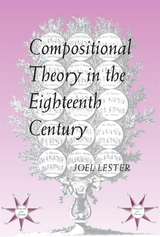 Compositional Theory in the Eighteenth Century
Joel Lester
Harvard University Press This ambitious study offers a panoramic survey of musical thought in the eighteenth century and, at the same time, a close analysis of the important theoretical topics of the period. The result is the most comprehensive account ever given of the theory behind the music of late Baroque and early Classical composers from Bach to Beethoven.
While giving preeminent theorists their due, Joel Lester also examines the works of over 100 seventeenth- and eighteenth-century writers to show how prominent theories were received and applied in actual teaching situations. Beginning with the influence of Zarlino and seventeenth-century theorists, Lester goes on to focus on central traditions emerging from definitive works in the early eighteenth century: species counterpoint in the writings of Fux; thoroughbass as presented by Niedt and Heinichen Rameau’s harmonic theories; and Mattheson’s views on melodic structure. The author traces the development and interactions of these traditions over the remainder of the century, through the writings of Albrechtsberger, C. P. E. Bach, Kirnberger, Koch, Marpurg, Martini, Nichelmann, Riepel, and many others. This historical overview is leavened throughout with accounts of individual composers grappling with theoretical issues—Haydn’s careful study of Fux’s treatise, Mozart’s instructions on harmony to his composition students, Beethoven’s own student exercises.
The links between various theoretical traditions, the pervasive influence of Rameau’s harmonic thinking, and the harmonic theories of Koch are just some of the numerous topics given their first full treatment here. Many of the theorists Lester cites are either unknown or often misunderstood today. By bringing their contributions to light and placing them within the context of theoretical tradition, Lester offers a fresh perspective, one that will inform and enhance any future study of this magnificent era in Western music.
Composition-Rhetoric: Backgrounds, Theory, and Pedagogy
Robert Connors
University of Pittsburgh Press, 1997
Connors provides a history of composition and its pedagogical approaches to form, genre, and correctness. He shows where many of the today’s practices and assumptions about writing come from, and he translates what our techniques and theories of teaching have said over time about our attitudes toward students, language and life.
Connors locates the beginning of a new rhetorical tradition in the mid-nineteenth century, and from there, he discusses the theoretical and pedagogical innovations of the last two centuries as the result of historical forces, social needs, and cultural shifts.
This important book proves that American composition-rhetoric is a genuine, rhetorical tradition with its own evolving theria and praxis. As such it is an essential reference for all teachers of English and students of American education.
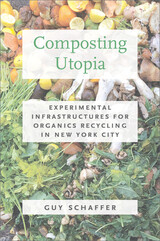 Composting Utopia: Experimental Infrastructures for Organics Recycling in New York City
Guy Schaffer
University of Massachusetts Press, 2023 New Yorkers generate millions of tons of trash annually, which, through the magic of infrastructure and one of the largest waste management systems in the world, disappears from city sidewalks each night. Under pressure from environmentalists, activists, policymakers, and industry, the New York City Department of Sanitation started exploring ways to divert organic material from the waste stream, and in 2013, launched its composting pilot program. Drawing on three years of ethnographic fieldwork with community composters and microhaulers in New York City, alongside the rollout of the city’s curbside organics collection system, Composting Utopia describes how local, grassroots organizations intervened in the city’s waste system, enacting change and presenting an alternative vision of the composting city. As Guy Shaffer argues, movement-driven infrastructure projects develop new tools for organizing the world, give communities agency over urban design, and promote just sustainability.
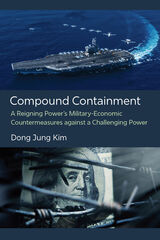 Compound Containment: A Reigning Power's Military-Economic Countermeasures against a Challenging Power
Dong Jung Kim
University of Michigan Press, 2022 When does a reigning great power of the international system supplement military containment of a challenging power by restricting its economic exchanges with that state? Scholars of great power politics have traditionally focused on examining a reigning power’s military containment of a challenging power. In direct contrast, Compound Containment demonstrates that these conventional studies are flawed without a sound understanding of the multilayered aspects of containment strategy in great power politics. Since economic capacity and military power are intimately linked to one another, countering a challenging power requires addressing both economic and military dimensions. Nonetheless, this nexus of security and economy in a reigning power’s response to a challenging power cannot be explained by traditional theories that dominate research in international security. Author Dong Jung Kim fills a gap in the scholarship on great power competition by investigating when a reigning power will make its military containment of a challenging power “compound” by simultaneously employing restrictive economic measures. Its main theoretical claims are corroborated by an analysis of key historical cases of reigning power-challenging power competition. This book also offers policy prescriptions for the United States by examining whether the United States is in a position to complement military containment of China with restrictive economic measures.
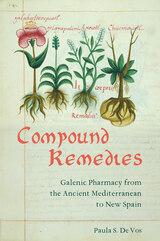 Compound Remedies: Galenic Pharmacy from the Ancient Mediterranean to New Spain
Paula S. De Vos
University of Pittsburgh Press, 2020 Winner, 2022 Edward Kremers Award
Compound Remedies examines the equipment, books, and remedies of colonial Mexico City’s Herrera pharmacy—natural substances with known healing powers that formed part of the basis for modern-day healing traditions and home remedies in Mexico. Paula S. De Vos traces the evolution of the Galenic pharmaceutical tradition from its foundations in ancient Greece to the physician-philosophers of medieval Islamic empires and the Latin West and eventually through the Spanish Empire to Mexico, offering a global history of the transmission of these materials, knowledges, and techniques. Her detailed inventory of the Herrera pharmacy reveals the many layers of this tradition and how it developed over centuries, providing new perspectives and insight into the development of Western science and medicine: its varied origins, its engagement with and inclusion of multiple knowledge traditions, the ways in which these traditions moved and circulated in relation to imperialism, and its long-term continuities and dramatic transformations. De Vos ultimately reveals the great significance of pharmacy, and of artisanal pursuits more generally, as a cornerstone of ancient, medieval, and early modern epistemologies and philosophies of nature.
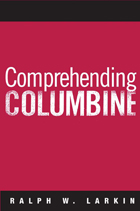 Comprehending Columbine
Ralph W Larkin
Temple University Press, 2007 On April 20, 1999, two Colorado teenagers went on a shooting rampage at Columbine High School. That day, Eric Harris and Dylan Klebold killed twelve fellow students and a teacher, as well as wounding twenty-four other people, before they killed themselves. Although there have been other books written about the tragedy, this is the first serious, impartial investigation into the cultural, environmental, and psychological causes of the massacre.Based on first-hand interviews and a thorough reading of the relevant literature, Ralph Larkin examines the complex of factors that led the two young men to plan and carry out their deed. For Harris and Klebold, Larkin concludes, the carnage was an act of revenge against the "jocks" who had harassed and humiliated them, retribution against evangelical students who acted as if they were morally superior, an acting out of the mythology of right-wing paramilitary organization members to "die in a blaze of glory," and a deep desire for notoriety.Rather than simply looking at Columbine as a crucible for all school violence, Larkin places the tragedy in its proper context, and in doing so, examines its causes and meaning.
Comprehending Drug Use: Ethnographic Research at the Social Margins
Page, J. Bryan
Rutgers University Press, 2010 Comprehending Drug Use, the first full-length critical overview of the use of ethnographic methods in drug research, synthesizes more than one hundred years of study on the human encounter with psychotropic drugs. J. Bryan Page and Merrill Singer create a comprehensive examination of the whole field of drug ethnography-methodology that involves access to the hidden world of drug users, the social spaces they frequent, and the larger structural forces that help construct their worlds. They explore the important intersections of drug ethnography with globalization, criminalization, public health (including the HIV/AIDS epidemic, hepatitis, and other diseases), and gender, and also provide a practical guide of the methods and career paths of ethnographers.
Comprehending Technical Japanese
Edward E. Daub
University of Wisconsin Press, 1975 Used for self-study or in the classroom, this text shows the reader how to read and translate technical Japanese texts by providing graded readings, explanatory notes, and translation aids.
A Comprehensive Index to Black Mask, 1920-1951
E. R. Hagemann
University of Wisconsin Press, 1982 Professor Hagemann, for many years interested in the hard-boiled, tough-guy writers, has completed this comprehensive index to Black Mask magazine. A task that took many years as a labor of love, this study is a thorough and accurate index to a magazine that furnished a publishing place for many of the writers of hard-boiled detective fiction.
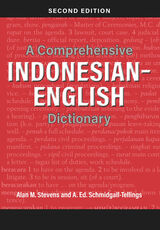 A Comprehensive Indonesian–English Dictionary: Second Edition
Alan M. Stevens
Ohio University Press, 2010 This second edition of A Comprehensive Indonesian-English Dictionary brings the highly successful first edition up to date with hundreds of new entries in business, law, and finance, as well as specialized terminology in the fields of technology, engineering, mining, and construction. Based on five years of research, including input from users, this new edition offers readers the most current information on names of political parties, acronyms for government offices, Islamic terms, colloquial pronunciations, and abbreviated forms used in blogs and e-mail. As with the original edition, the dictionary is designed to be as user-friendly as possible. Root words, meanings, proverbs, idioms, compounds that begin with the root word, and derivatives are given. Thousands of sample sentences from primary sources illustrate meaning and usage; no sentences are invented, ensuring complete authenticity and reliability. The new edition is essential for reference libraries, as well as students and scholars of Indonesian.
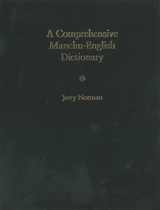 A Comprehensive Manchu-English Dictionary
Jerry Norman
Harvard University Press, 2013 Jerry Norman’s Comprehensive Manchu-English Dictionary, a substantial revision and enlargement of his Concise Manchu-English Lexicon of 1978, now long out of print, is poised to become the standard English-language resource on the Manchu language. As the dynastic language of the Qing dynasty (1644–1911), Manchu was used in official documents and was also the vehicle for an enormous translation literature, mostly from the Chinese. The new Dictionary, based exclusively on Qing sources, retains all of the information from the earlier Lexicon, but also includes hundreds of additional entries cited from original Manchu texts, enhanced cross-references, and an entirely new introduction on Manchu pronunciation and script. All content from the earlier publication has also been verified.
This final book from the preeminent Manchu linguist in the English-speaking world is a reference work that not only updates Norman’s earlier scholarship but also summarizes his decades of study of the Manchu language. The Dictionary, which represents a significant scholarly contribution to the field of Inner Asian studies and to all students and scholars of Manchu and other Tungusic and related languages around the world, will become a major tool for archival research on Chinese late imperial period history and government.
Compressed Air Energy Storage: Types, systems and applications
David S-K. Ting
The Institution of Engineering and Technology, 2021 The intermittency of renewable energy sources is making increased deployment of storage technology necessary. Technologies are needed with high round-trip efficiency and at low cost to allow renewables to undercut fossil fuels. The cost of lithium batteries has fallen, but producing them comes with a substantial carbon footprint, as well as a cost to the local environment.
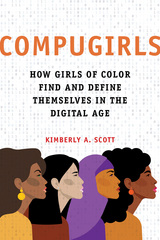 COMPUGIRLS: How Girls of Color Find and Define Themselves in the Digital Age
Kimberly A. Scott
University of Illinois Press, 2021 What does is it mean for girls of color to become techno-social change agents--individuals who fuse technological savvy with a deep understanding of society in order to analyze and confront inequality? Kimberly A. Scott explores this question and others as she details the National Science Foundation-funded enrichment project COMPUGIRLS. This groundbreaking initiative teaches tech skills to adolescent girls of color but, as importantly, offers a setting that emphasizes empowerment, community advancement, and self-discovery. Scott draws on her experience as an architect of COMPUGIRLS to detail the difficulties of translating participants' lives into a digital context while tracing how the program evolved. The dramatic stories of the participants show them blending newly developed technical and communication skills in ways designed to spark effective action and bring about important change. A compelling merger of theory and storytelling, COMPUGIRLS provides a much-needed roadmap for understanding how girls of color can find and define their selves in today's digital age.
Compulsory Happiness
Norman Manea
Northwestern University Press, 1994 In cool, precise prose, and with an unerring sense of the absurd, Norman Manea's four novellas create a picture of everyday life in a grotesque police state, expressing terror and hope, fear and solidarity, the humorous triviality of the ordinary, and the painful search for an ideal.
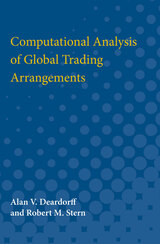 Computational Analysis of Global Trading Arrangements
Alan V. Deardorff and Robert M. Stern
University of Michigan Press, 1990 The Michigan Model of World Production and Trade, developed in the 1970s by Alan V. Deardorff and Robert M. Stern, has become a valuable tool widely used in research on the economic effects of national and multilateral trade policies. Computational Analysis of Global Trading Arrangements presents the recent developments and enhancements of the Michigan Model together with the major results that it has provided in the last seven years. The book provides a detailed exposition of the model, and chapters describe its applications to a variety of important issues of trade policy in the United States, Japan, and other major industrialized and developing countries. It includes an analysis of negotiating options in the GATT (Uruguay) Round of Multilateral Trade Negotiations. The Michigan Model discussed here provides an empirical framework within which to analyze the twenty-nine producing sectors that make up each of the world's major industrialized and developing countries. Hence, it allows the authors to demonstrate the impact upon a given country—on top of the effects of its own trade policies—of the tariffs and nontariff barriers of foreign countries. The authors of Computational Analysis of Global Trading Arrangements have compiled a volume that underscores the importance of economic interdependence in the global trading system.
 Computational Humanities
Jessica Marie Johnson
University of Minnesota Press, 2024 The first book to intervene in debates on computation in the digital humanities
Bringing together leading experts from across North America and Europe, Computational Humanities redirects debates around computation and humanities digital scholarship from dualistic arguments to nuanced discourse centered around theories of knowledge and power. This volume is organized around four questions: Why or why not pursue computational humanities? How do we engage in computational humanities? What can we study using these methods? Who are the stakeholders? Recent advances in technologies for image and sound processing have expanded computational approaches to cultural forms beyond text, and new forms of data, from listservs and code repositories to tweets and other social media content, have enlivened debates about what counts as digital humanities scholarship. Providing case studies of collaborations between humanities-centered and computation-centered researchers, this volume highlights both opportunities and frictions, showing that data and computation are as much about power, prestige, and precarity as they are about p-values. Contributors: Mark Algee-Hewitt, Stanford U; David Bamman, U of California, Berkeley; Kaspar Beelen, U of London; Peter Bell, Philipps U of Marburg; Tobias Blanke, U of Amsterdam; Julia Damerow, Arizona State U; Quinn Dombrowski, Stanford U; Crystal Nicole Eddins, U of Pittsburgh; Abraham Gibson, U of Texas at San Antonio; Tassie Gniady; Crystal Hall, Bowdoin College; Vanessa M. Holden, U of Kentucky; David Kloster, Indiana U; Manfred D. Laubichler, Arizona State U; Katherine McDonough, Lancaster U; Barbara McGillivray, King’s College London; Megan Meredith-Lobay, Simon Fraser U; Federico Nanni, Alan Turing Institute; Fabian Offert, U of California, Santa Barbara; Hannah Ringler, Illinois Institute of Technology; Roopika Risam, Dartmouth College; Joshua D. Rothman, U of Alabama; Benjamin M. Schmidt; Lisa Tagliaferri, Rutgers U; Jeffrey Tharsen, U of Chicago; Marieke van Erp, Royal Netherlands Academy of Arts and Sciences; Lee Zickel, Case Western Reserve U.
A Computational Introduction to Linguistics: Describing Language in Plain Prolog
Almerindo E. Ojeda
CSLI, 2013 In this book, Almerindo E. Ojeda offers a unique perspective on linguistics by discussing developing computer programs that will assign particular sounds to particular meanings and, conversely, particular meanings to particular sounds. Since these assignments are to operate efficiently over unbounded domains of sound and sense, they can begin to model the two fundamental modalities of human language—speaking and hearing. The computational approach adopted in this book is motivated by our struggle with one of the key problems of contemporary linguistics—figuring out how it is that language emerges from the brain.
 The Computer and the Mind: An Introduction to Cognitive Science
Philip Johnson-Laird
Harvard University Press, 1988 In a field choked with seemingly impenetrable jargon, Philip N. Johnson-Laird has done the impossible: written a book about how the mind works that requires no advance knowledge of artificial intelligence, neurophysiology, or psychology. The mind, he says, depends on the brain in the same way as the execution of a program of symbolic instructions depends on a computer, and can thus be understood by anyone willing to start with basic principles of computation and follow his step-by-step explanations.
The author begins with a brief account of the history of psychology and the birth of cognitive science after World War II. He then describes clearly and simply the nature of symbols and the theory of computation, and follows with sections devoted to current computational models of how the mind carries out all its major tasks, including visual perception, learning, memory, the planning and control of actions, deductive and inductive reasoning, and the formation of new concepts and new ideas. Other sections discuss human communication, meaning, the progress that has been made in enabling computers to understand natural language, and finally the difficult problems of the conscious and unconscious mind, free will, needs and emotions, and self-awareness. In an envoi, the author responds to the critics of cognitive science and defends the computational view of the mind as an alternative to traditional dualism: cognitive science integrates mind and matter within the same explanatory framework.
This first single-authored introduction to cognitive science will command the attention of students of cognitive science at all levels including psychologists, linguists, computer scientists, philosophers, and neuroscientists--as well as all readers curious about recent knowledge on how the mind works.
Computer Control of Real-Time Processes
S. Bennett
The Institution of Engineering and Technology, 1990 This book provides an introduction to many aspects of computer control. It covers techniques or control algorithm design and tuning of controllers; computer communications; parallel processing; and software design and implementation. The theoretical material is supported by case studies covering power systems control, robot manipulators, liquid natural as vaporisers, batch control of chemical processes; and active control of aircraft.
Computer Game Worlds
Claus Pias
Diaphanes, 2017 Computer games have become ubiquitous in today’s society. Many scholars have speculated on the reasons for their massive success. Yet we haven’t considered the most basic questions: Why do computer games exist? What specific circumstances led to the creation of this entirely new type of game? What sorts of knowledge facilitated the requisite technological and institutional transformations?
With Computer Game Worlds, Claus Pias sets out to answer these questions. Tracing computer games from their earliest forms to the unstoppable commercial and cultural phenomena they have become today, Pias then provides a careful epistemological reconstruction of the process of playing games, both at computers and by computers themselves. The book makes a valuable theoretical contribution to the ongoing discussion about computer games.
A Computer Perspective
Charles Eames
Harvard University Press, 1973 A Computer Perspective is an illustrated essay on the origins and first lines of development of the computer. The complex network of creative forces and social pressures that have produced the computer is personified here in the creators of instruments of computation, and their machines or tables; the inventors of mathematical or logical concepts and their applications; and the fabricators of practical devices to serve the immediate needs of government, commerce, engineering, and science.
The book is based on an exhibition conceived and assembled for International Business Machines Corporation. Like the exhibition, it is not a history in the narrow sense of a chronology of concepts and devices. Yet these pages actually display more true history (in relation to the computer) than many more conventional presentations of the development of science and technology.
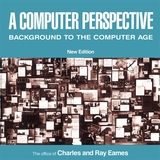 A Computer Perspective: Background to the Computer Age, New Edition
Charles Eames and Ray Eames
Harvard University Press, 1990 A Computer Perspective is an illustrated essay on the origins and first lines of development of the computer. The complex network of creative forces and social pressures that have produced the computer is personified here in the creators of instruments of computation, and their machines or tables; the inventors of mathematical or logical concepts and their applications; and the fabricators of practical devices to serve the immediate needs of government, commerce, engineering, and science.
The book is based on an exhibition conceived and assembled for International Business Machines (IBM) Corporation. Like the exhibition, it is not a history in the narrow sense of a chronology of concepts and devices. Yet these pages actually display more true history (in relation to the computer) than many more conventional presentations of the development of science and technology.
A Computer Program for Monothetic Subdivisive Classification in Archaeology
Robert Whallon Jr.
University of Michigan Press, 2019 In this report, Robert Whallon provides a brief description of monothetic subdivisive classification, why it is useful in defining objective typologies in archaeology, and how it can be applied to an archaeological data set using a computer program. Because he wrote at a time when computer programs were run on paper cards, Whallon includes operating instructions for the computer program, including an illustration showing the deck arrangment for the cards. He also includes a source listing of a Fortran IV program for the classification.
 Computer Scenographics
Darwin Reid Payne
Southern Illinois University Press, 1994
Darwin Reid Payne’s approach to theatrical design is that of a computer advocate and pioneer. With Computer Scenographics, he ushers in a new generation of scenery design by applying state-of-the-art technology to the traditional methods of scenography. Though not a how-to book, Computer Scenographics is a general introduction to, and an affirmation of, the value of computer graphics for both student and working scenographers.
Payne acknowledges that many scenographers would not want to use computers exclusively in the preparation of their designs. Today’s scenographers continue to value the manual skills of drawing and painting, learned and perfected over time, and would not consider abandoning these skills entirely. And it is unlikely that the most powerful computer or most sophisticated software could ever supplant that intimate interaction of hand and mind provided by traditional tools and materials. Nevertheless, Payne’s utilization of the Virtus Walk-Through computer program to facilitate set design expands the tools of the artist to new dimensions.
Aided by 129 illustrations, Payne addresses four major topics: (1) how computer studios are set up; (2) how computers serve as storage for visual ideas and as conceptual tools; (3) how technical information needed for producing a scenographer’s ideas onstage is created with computers; (4) and how modelmaking has been changed by computer-generated three-dimensional possibilities, especially by the introduction of "virtual reality" onto the computer platform.
Computers and Art: Second Edition
Edited by Stuart Mealing
Intellect Books, 2002 Computers and Art provides insightful perspectives on the use of the computer as a tool for artists. The approaches taken vary from its historical, philosophical and practical implications to the use of computer technology in art practice. The contributors include an art critic, an educator, a practising artist and a researcher. Mealing looks at the potential for future developments in the field, looking at both the artistic and the computational aspects of the field.
Computers in Education: A Half-Century of Innovation
Robert Smith
CSLI, 2015 Described by the New York Times as a visionary “pioneer in computerized learning,” Patrick Suppes (1922-2014) and his many collaborators at Stanford University conducted research on the development, commercialization, and use of computers in education from 1963 to 2013. Computers in Education synthesizes this wealth of scholarship into a single succinct volume that highlights the profound interconnections of technology in education. By capturing the great breadth and depth of this research, this book offers an accessible introduction to Suppes’s striking work.
 Computers, Inc.: Japan’s Challenge to IBM
Marie Anchordoguy
Harvard University Press, 1989 This account of efforts to build a domestic Japanese computer industry is enlivened with quotations from industrial leaders commenting on the stages through which Japan has emerged as a world-class competitor.
In the late 1950s, Japan was still relying on IBM and other foreign suppliers. After the decision to enter the computer field, the government used protectionism, financial aid, and cooperative R&D projects to assist firms in developing hardware and improving their technology. The establishment of a quasi-public computer rental company to carry the burden of financing rentals played a key role in helping fledgling firms compete with IBM.
Marie Anchordoguy shows how government intervention in the market avoided the risks of technological sluggishness by encouraging keen competition among domestic computer firms. She traces the growth of Japanese computer hardware to Japan’s position as an exporter of mainframes and describes some of the problems encountered in producing software. This study provides a clear example of the way in which government–industry cooperation has enhanced Japan’s position in the world market.
 Computers, Surveillance, and Privacy
David Lyon and Elia Zureik, Editors
University of Minnesota Press, 1996 Computers, Surveillance, and Privacy was first published in 1996. Minnesota Archive Editions uses digital technology to make long-unavailable books once again accessible, and are published unaltered from the original University of Minnesota Press editions. From computer networks to grocery store checkout scanners, it is easier and easier for governments, employers, advertisers, and individuals to gather detailed and sophisticated information about each of us. In this important new collection, the authors question the impact of these new technologies of surveillance on our privacy and our culture. Although surveillance-literally some people "watching over" others-is as old as social relationships themselves, with the advent of the computer age this phenomenon has acquired new and distinctive meanings. Technological advances have made it possible for surveillance to become increasingly global and integrated-both commercial and government-related personal data flows more frequently across national boundaries, and the flow between private and public sectors has increased as well. Addressing issues of the global integration of surveillance, social control, new information technologies, privacy violation and protection, and workplace surveillance, the contributors to Computers, Surveillance, and Privacy grapple with the ramifications of these concerns for society today. Timely and provocative, this collection will be of vital interest to anyone concerned with resistance to social control and incursions into privacy. Contributors: Jonathan P. Allen, Colin J. Bennett, Simon G. Davies, Oscar H. Gandy Jr., Calvin C. Gotlieb, Rob Kling, Gary T. Marx, Abbe Mowshowitz, Judith A. Perrolle, Mark Poster, Priscilla M. Regan, James B. Rule. David Lyon is professor of sociology at Queen's University, Canada. His previous books include The Electronic Eye: The Rise of Surveillance Society (Minnesota, 1994). Elia Zureik is also professor of sociology at Queen's University, Canada, and coedited (with Dianne Hartling) The Social Context of the New Information and Communication Technologies (1987).
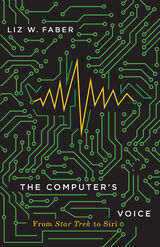 The Computer's Voice: From Star Trek to Siri
Liz W. Faber
University of Minnesota Press, 2020 A deconstruction of gender through the voices of Siri, HAL 9000, and other computers that talk
Although computer-based personal assistants like Siri are increasingly ubiquitous, few users stop to ask what it means that some assistants are gendered female, others male. Why is Star Trek’s computer coded as female, while HAL 9000 in 2001: A Space Odyssey is heard as male? By examining how gender is built into these devices, author Liz W. Faber explores contentious questions around gender: its fundamental constructedness, the rigidity of the gender binary, and culturally situated attitudes on male and female embodiment. Faber begins by considering talking spaceships like those in Star Trek, the film Dark Star, and the TV series Quark, revealing the ideologies that underlie space-age progress. She then moves on to an intrepid decade-by-decade investigation of computer voices, tracing the evolution from the masculine voices of the ’70s and ’80s to the feminine ones of the ’90s and ’00s. Faber ends her account in the present, with incisive looks at the film Her and Siri herself. Going beyond current scholarship on robots and AI to focus on voice-interactive computers, The Computer’s Voice breaks new ground in questions surrounding media, technology, and gender. It makes important contributions to conversations around the gender gap and the increasing acceptance of transgender people.
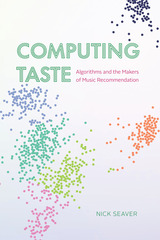 Computing Taste: Algorithms and the Makers of Music Recommendation
Nick Seaver
University of Chicago Press, 2022 Meet the people who design the algorithms that capture our musical tastes.
The people who make music recommender systems have lofty goals: they want to broaden listeners’ horizons and help obscure musicians find audiences, taking advantage of the enormous catalogs offered by companies like Spotify, Apple Music, and Pandora. But for their critics, recommender systems seem to embody all the potential harms of algorithms: they flatten culture into numbers, they normalize ever-broadening data collection, and they profile their users for commercial ends. Drawing on years of ethnographic fieldwork, anthropologist Nick Seaver describes how the makers of music recommendation navigate these tensions: how product managers understand their relationship with the users they want to help and to capture; how scientists conceive of listening itself as a kind of data processing; and how engineers imagine the geography of the world of music as a space they care for and control.
Computing Taste rehumanizes the algorithmic systems that shape our world, drawing attention to the people who build and maintain them. In this vividly theorized book, Seaver brings the thinking of programmers into conversation with the discipline of anthropology, opening up the cultural world of computation in a wide-ranging exploration that travels from cosmology to calculation, myth to machine learning, and captivation to care.
Comrade or Brother?: A History of the British Labour Movement
Mary Davis
Pluto Press, 2009 Critical and iconoclastic, Comrade or Brother? traces the history of the British Labour Movement from its beginnings at the onset of industrialisation through its development within a capitalist society, up to the end of the twentieth-century. Written by a leading activist in the labour movement, the book redresses the balance in much labour history writing. It examines the place of women and the influence of racism and sexism as well as providing a critical analysis of the rival ideologies which played a role in the uneven development of the labour movement.
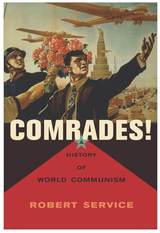 Comrades!: A History of World Communism
Robert Service
Harvard University Press, 2010 Almost two decades after the collapse of communism in Eastern Europe and the USSR, leading historian Robert Service examines the history of communism throughout the world. Comrades! moves from Marx and Lenin to Mao and Castro and beyond to trace communism from its beginnings to the present day.Offering vivid portraits of the protagonists and decisive events in communist history, Service looks not only at the high politics of communist regimes but also at the social conditions that led millions to support communism in so many countries. After outlining communism’s origins with Marx and Engels and its first success with Lenin and the Russian Revolution in 1917, Service examines the Soviet bloc, long-lasting regimes like Yugoslavia and Cuba, the Chinese revolution, the spread of communism in Asia, Africa, and Latin America, and the international links among the hundreds of parties. He covers communism’s organization and ideology as well as its general appeal. He looks at abortive communist revolutions and at the ineffectual parties in the United States and elsewhere.Service offers a human view of the story as well as a global analysis. His uncomfortable conclusion—and an important message for the twenty-first century—is that although communism in its original form is now dying or dead, the poverty and injustice that enabled its rise are still dangerously alive. Unsettling and compellingly written, Comrades! is the most comprehensive study of one of the most important movements of the modern world.
 Comrades in Health: U.S. Health Internationalists, Abroad and at Home
Edited by Anne-Emanuelle Birn and Theodore M. Brown
Rutgers University Press Since the early twentieth century, politically engaged and socially committed U.S. health professionals have worked in solidarity with progressive movements around the world. Often with roots in social medicine, political activism, and international socialism, these doctors, nurses, and other health workers became comrades who joined forces with people struggling for social justice, equity, and the right to health.
Anne-Emanuelle Birn and Theodore M. Brown bring together a group of professionals and activists whose lives have been dedicated to health internationalism. By presenting a combination of historical accounts and first-hand reflections, this collection of essays aims to draw attention to the longstanding international activities of the American health left and the lessons they brought home. The involvement of these progressive U.S. health professionals is presented against the background of foreign and domestic policy, social movements, and global politics.
Comstock Women: The Making Of A Mining Community
Ronald M. James
University of Nevada Press, 1997 When it comes to Nevada history, men get most of the ink. Comstock Women is a collection of 14 historical studies that helps to rectify that reality. The authors of these essays, who include some of Nevada’s most prominent historians, demographers, and archaeologists, explore such topics as women and politics, jobs, and ethnic groups. Their work goes far in refuting the exaggerated popular images of women in early mining towns as dance hall girls or prostitutes. Relying primarily on newspapers, court decisions, census records, as well as sparse personal diaries and records left by the woman, the essayists have resurrected the lives of the women who lived on the Comstock during the boom years.
Con las debidas licencias / With Leave and License: Poemas / Poems
Leda Schiavo
Swan Isle Press, 2000 'Con las debidas licencias' is the Spanish version of 'imprimatur' or 'nihil obstat,' the Latin used for books published under Catholic censorship. In Spanish, the title plays with the semiotic richness of the word 'license,' meaning 'liberty of action conceded' and 'abuse of freedom.' The poems of With Leave and License strike the imagination with tenderness and nostalgia, powerful in this intelligent vision of life considered as an irreversible journey.
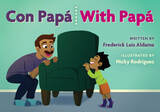 Con Papá / With Papá
Written by Frederick Luis Aldama Illustrated by Nicky Rodriguez
Ohio State University Press, 2022 ¡Con papá todo es posible! Con ilustraciones divertidas e imágenes ricas, este amable libro bilingüe para las edades de 3–8 celebra a los padres, les niñes y la identidad Latinx mientras lleva a los lectores en un viaje de crecimiento y descubrimiento de la niñez. Desde la entrega de las alas del dios serpiente a los brazos seguros de Papá hasta presenciar el tapiz mágico de las estrellas, Con Papá / With Papá nos muestra el mundo a través de los ojos de une niñe, de la mano de Papá, hasta que estén listos para emprender sus propias aventuras. With Papá, anything is possible! With playful illustrations and rich imagery, this gentle bilingual story for ages 3–8 celebrates fathers, children, and Latinx identity as it takes readers on a childhood journey of growth and discovery. From delivery from the serpent god’s wings to Papá’s safe arms to witnessing the magical tapestry of stars, Con Papá / With Papá shows us the world through a child’s eyes, hand in hand with Papá, until they are ready to set off on their own adventures.
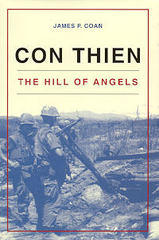 Con Thien: The Hill of Angels
James P. Coan
University of Alabama Press, 2007 Con Thien is a memoir/history of a much-beleaguered Marine outpost of the DMZ
Throughout much of 1967, a remote United States Marine firebase only two miles from the demilitarized zone (DMZ) captured the attention of the world’s media. That artillery-scarred outpost was the linchpin of the so-called McNamara Line intended to deter incursions into South Vietnam by the North Vietnamese Army. As such, the fighting along this territory was particularly intense and bloody, and the body count rose daily.
Con Thien combines James P. Coan’s personal experiences with information taken from archives, interviews with battle participants, and official documents to construct a powerful story of the daily life and combat on the red clay bulls-eye known as "The Hill of Angels." As a tank platoon leader in Alpha Company, 3d Tank Battalion, 3d Marine Division, Coan was stationed at Con Thien for eight months during his 1967-68 service in Vietnam and witnessed much of the carnage.
Con Thien was heavily bombarded by enemy artillery with impunity because it was located in politically sensitive territory and the U.S. government would not permit direct armed response from Marine tanks. Coan, like many other soldiers, began to feel as though the government was as much the enemy as the NVA, yet he continued to fight for his country with all that he had. In his riveting memoir, Coan depicts the hardships of life in the DMZ and the ineffectiveness of much of the U.S. military effort in Vietnam.
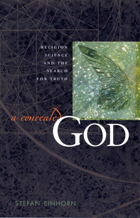 Concealed God
Stefan Einhorn
Templeton Press, 2002
Highly acclaimed in Sweden where it was first published in both hardcover and paperback editions, A Concealed God poses two intriguing questions:
•Does God truly exist?
•If so, is the concept of God logical and in agreement with the knowledge of the world that science has provided to date?
The God presented by most religions doesn't make sense in today's world; we have little room for miracles. Furthermore, there are irreconcilable aspects in the world's religions. Must we abandon our faith or belief in God? Perhaps not, says popular Swedish thinker Stefan Einhorn. We can behave as scientists do when they run experiments only to obtain contradictory results. They ask themselves whether there might not be a logical conclusion that binds all the results together and leads to the most probable explanation.
Einhorn hypothesizes that if God truly exists, then many different religions would have discovered this. He finds a common denominator in the concept of a hidden God in seven major religions: Judaism, Christianity, Islam, Hinduism, Buddhism, Taoism, and Confucianism. But even with this shared belief, can we know if God exists? Did humankind create the idea of God to answer the unexplainable? What about evil and suffering, the absence of meaning in life, loneliness and insecurity? And most importantly, how do we search for a concealed God?
Most religions share common principles for the search for "that which is concealed," including meditation, contemplation, and prayer. Whatever route is chosen, the search for God may bring us some answers. Einhorn concludes that two themes are central to the search: one is that God is both concealed and simultaneously omnipresent; the other is that only with utter humility and an awareness of our inability to fully understand may we approach the divine.
In the end, there are no definite answers. But the search sheds light on the many paths to enlightenment offered by the world's religions.
 Concealing Coloration in Animals
Judy Diamond and Alan B. Bond
Harvard University Press, 2013 The biological functions of coloration in animals are sometimes surprising. Color can attract mates, intimidate enemies, and distract predators. But color patterns can also conceal animals from detection. Concealing coloration is unusual because it is an adaptation not only to the visual features of the environment but also to the perceptual and cognitive capabilities of other organisms. Judy Diamond and Alan Bond bring to light the many factors at work in the evolution of concealing coloration.
Animals that resemble twigs, tree bark, stones, and seaweed may appear to be perfect imitations, but no concealment strategy is without flaws. Amid the clutter of the natural world, predators search for minute, telltale clues that will reveal the identity of their prey. Predators have remarkable abilities to learn to discriminate the fake from the real. But prey have their own range of defensive tactics, evolving multiple appearances or the ability to change color at will. Drawing on modern experimental evidence of the functional significance of animal color strategies, Diamond and Bond offer striking illustrations of how the evolution of features in one organism can be driven by the psychology of others.
Concealing Coloration in Animals takes readers on a scientific adventure that explores creatures inside mats of floating seaweed, mice and lizards on desert rocks and sand, and rare parrots in the rainforest of New Zealand. Color photographs extensively document the mind-boggling array of deceptive strategies animals use to blend in, mislead, or vanish from view.
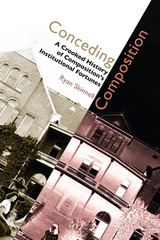 Conceding Composition: A Crooked History of Composition's Institutional Fortunes
Ryan Skinnell
Utah State University Press, 2016 First-year composition became the most common course in American higher education not because it could “fix” underprepared student writers, but because it has historically served significant institutional interests. That is, it can be “conceded” in multiple ways to help institutions solve political, promotional, and financial problems. Conceding Composition is a wide-ranging historical examination of composition’s evolving institutional value in American higher education over the course of nearly a century.
Based on extensive archival research conducted at six American universities and using the specific cases of institutional mission, regional accreditation, and federal funding, this study demonstrates that administrators and faculty have introduced, reformed, maintained, threatened, or eliminated composition as part of negotiations related to nondisciplinary institutional exigencies. Viewing composition from this perspective, author Ryan Skinnell raises new questions about why composition exists in the university, how it exists, and how teachers and scholars might productively reconceive first-year composition in light of its institutional functions.
The book considers the rhetorical, political, organizational, institutional, and promotional options conceding composition opened up for institutions of higher education and considers what the first-year course and the discipline might look like with composition’s transience reimagined not as a barrier but as a consummate institutional value.
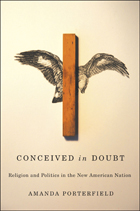 Conceived in Doubt: Religion and Politics in the New American Nation
Amanda Porterfield
University of Chicago Press, 2012 Americans have long acknowledged a deep connection between evangelical religion and democracy in the early days of the republic. This is a widely accepted narrative that is maintained as a matter of fact and tradition—and in spite of evangelicalism’s more authoritarian and reactionary aspects. In Conceived in Doubt, Amanda Porterfield challenges this standard interpretation of evangelicalism’s relation to democracy and describes the intertwined relationship between religion and partisan politics that emerged in the formative era of the early republic. In the 1790s, religious doubt became common in the young republic as the culture shifted from mere skepticism toward darker expressions of suspicion and fear. But by the end of that decade, Porterfield shows, economic instability, disruption of traditional forms of community, rampant ambition, and greed for land worked to undermine heady optimism about American political and religious independence. Evangelicals managed and manipulated doubt, reaching out to disenfranchised citizens as well as to those seeking political influence, blaming religious skeptics for immorality and social distress, and demanding affirmation of biblical authority as the foundation of the new American national identity. As the fledgling nation took shape, evangelicals organized aggressively, exploiting the fissures of partisan politics by offering a coherent hierarchy in which God was king and governance righteous. By laying out this narrative, Porterfield demolishes the idea that evangelical growth in the early republic was the cheerful product of enthusiasm for democracy, and she creates for us a very different narrative of influence and ideals in the young republic.
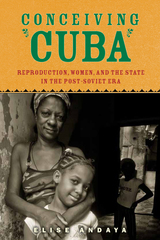 Conceiving Cuba: Reproduction, Women, and the State in the Post-Soviet Era
Andaya, Elise
Rutgers University Press, 2014 Received an Honorable Mention for the 2015 First Michelle Rosaldo Prize for a First Book in Feminist Anthropology from the Association for Feminist Anthropology
Winner of the Adele E. Clarke Book Award from ReproNetwork
After Cuba’s 1959 revolution, the Castro government sought to instill a new social order. Hoping to achieve a new and egalitarian society, the state invested in policies designed to promote the well-being of women and children. Yet once the Soviet Union fell and Cuba’s economic troubles worsened, these programs began to collapse, with serious results for Cuban families.
Conceiving Cuba offers an intimate look at how, with the island’s political and economic future in question, reproduction has become the subject of heated public debates and agonizing private decisions. Drawing from several years of first-hand observations and interviews, anthropologist Elise Andaya takes us inside Cuba’s households and medical systems. Along the way, she introduces us to the women who wrestle with the difficult question of whether they can afford a child, as well as the doctors who, with only meager resources at their disposal, struggle to balance the needs of their patients with the mandates of the state.
Andaya’s groundbreaking research considers not only how socialist policies have profoundly affected the ways Cuban families imagine the future, but also how the current crisis in reproduction has deeply influenced ordinary Cubans’ views on socialism and the future of the revolution. Casting a sympathetic eye upon a troubled state, Conceiving Cuba gives new life to the notion that the personal is always political.
Conceiving Cultures: Reproducing People and Places on Nuakata, Papua New Guinea
Shelley Mallett
University of Michigan Press, 2003 Conceiving Cultures critically reflects on the ways anthropologists come to understand and represent the people and cultures that they study. These ideas are developed through an ethnographic study that explores notions of the gendered person through knowledge and practices relating to reproductive health on the Massim island of Nuakata in Papua New Guinea. Conceiving Cultures makes explicit anthropology's implicit project to understand the self by way of the other.
Shelley Mallett is Research Fellow at the Key Centre for Women's Health in Society at Melbourne University.
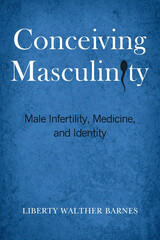 Conceiving Masculinity: Male Infertility, Medicine, and Identity
Liberty Walther Barnes
Temple University Press, 2014 In Conceiving Masculinity, Liberty Walther Barnes puts the world of male infertility under the microscope to examine how culturally pervasive notions of gender shape our understanding of disease, and how disease impacts our personal ideas about gender. Taking readers inside male infertility clinics, and interviewing doctors and couples dealing with male infertility, Barnes provides a rich account of the social aspects of the confusing and frustrating diagnosis of infertility. She explains why men resist a stigmatizing label like "infertile," and how men with poor fertility redefine for themselves what it means to be manly and masculine in a society that prizes male virility. Conceiving Masculinity also details how and why men embrace medical technologies and treatment for infertility. Broaching a socially taboo topic, Barnes emphasizes that infertility is not just a women's issue. She shows how gender and disease are socially constructed within social institutions and by individuals.
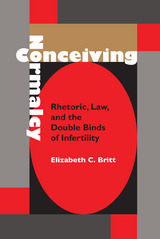 Conceiving Normalcy: Rhetoric, Law, and the Double Binds of Infertility
Elizabeth C. Britt
University of Alabama Press, 2001 This ground-breaking rhetorical analysis examines a 1987 Massachusetts law affecting infertility treatment and the cultural context that makes such a law possible Elizabeth C. Britt uses a Massachusetts statute requiring insurance coverage for infertility as a lens through which the work of rhetoric in complex cultural processes can be better understood. Countering the commonsensical notion that mandatory insurance coverage functions primarily to relieve the problem of infertility, Britt argues instead that the coverage serves to expose its contours. Britt finds that the mandate, operating as a technology of normalization, helps to identify the abnormal (the infertile) and to create procedures by which the abnormal can be subjected to reform. In its role in normalizing processes, the mandate is more successful when it sustains, rather than resolves, the distinction between the normal and the abnormal. This distinction is achieved in part by the rhetorical mechanism of the double bind. For the middle-class white women who are primarily served by the mandate, these double binds are created both by the desire for success, control, and order and by adherence to medical models that often frustrate these same desires. The resulting double binds help to create and sustain the tension between fertility and infertility, order and discontinuity, control and chaos, success and failure, tensions that are essential for the process of normalization to continue. Britt uses extensive interviews with women undergoing fertility treatments to provide the foundation for her detailed analysis. While her study focuses on the example of infertility, it is also more broadly a commentary on the power of definition to frame experience, on the burdens and responsibilities of belonging to social collectives, and on the ability of rhetorical criticism to interrogate cultural formations.
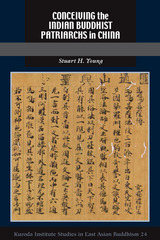 Conceiving the Indian Buddhist Patriarchs in China
Stuart H. Young
University of Hawaii Press, 2015 Aśvaghoșa, Nāgārjuna, and ryadeva are among the most celebrated Indian patriarchs in Asian Buddhist traditions and modern Buddhist studies scholarship. Scholars agree that all three lived in first- to third-century C.E. India, so most studies have focused on locating them in ancient Indian history, religion, or society. To this end, they have used all available accounts of the Indian patriarchs’ lives—in Sanskrit, Tibetan, various Central Asian languages, and Chinese, produced over more than a millennium— and viewed them as bearing exclusively on ancient India. Of these sources, medieval Chinese hagiographies are by far the earliest and most abundant. Conceiving the Indian Buddhist Patriarchs in China is the first attempt to situate the medieval Chinese hagiographies of Aśvaghoșa, Nāgārjuna, and ryadeva in the context of Chinese religion, culture, and society of the time. It examines these sources not as windows into ancient Indian history but as valuable records of medieval Chinese efforts to define models of Buddhist sanctity. It explores broader questions concerning Chinese conceptions of ancient Indian Buddhism and concerns about being Buddhist in latter-day China. By propagating the tales and texts of Aśvaghoșa, Nāgārjuna, and ryadeva, leaders of the Chinese sangha sought to demonstrate that the means and media of Indian Buddhist enlightenment were readily available in China and that local Chinese adepts could thereby rise to the ranks of the most exalted Buddhist saints across the Sino-Indian divide. Chinese authors also aimed to merge their own kingdom with the Buddhist heartland by demonstrating congruency between Indian and Chinese ideals of spiritual attainment. This volume shows, for the first time, how Chinese Buddhists adduced the patriarchs as evidence that Buddhist masters from ancient India had instantiated the same ideals, practices, and powers expected of all Chinese holy beings and that the expressly foreign religion of Buddhism was thus the best means to sainthood and salvation for latter-day China. Rich in information and details about the inner world of medieval Chinese Buddhists, Conceiving the Indian Buddhist Patriarchs in China will be welcomed by scholars and students in the fields of Buddhist studies, religious studies, and China studies.
Concentrated Corporate Ownership
Edited by Randall K. Morck
University of Chicago Press, 2000 Standard economic models assume that many small investors own firms. This is so in most large U.S. firms, but wealthy individuals or families generally hold controlling blocks in smaller U.S. firms and in all firms in most other countries. Given this, the lack of theoretical and empirical work on tightly held firms is surprising.
What corporate governance problems arise in tightly held firms? How do these differ from corporate governance problems in widely held firms? How do control blocks arise and how are they maintained? How does concentrated ownership affect economic growth? How should we regulate tightly held firms?
Drawing together leading scholars from law, economics, and finance, this volume examines the economic and legal issues of concentrated ownership and their impact on a shifting global economy.
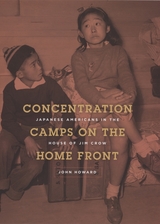 Concentration Camps on the Home Front: Japanese Americans in the House of Jim Crow
John Howard
University of Chicago Press, 2008 Without trial and without due process, the United States government locked up nearly all of those citizens and longtime residents who were of Japanese descent during World War II. Ten concentration camps were set up across the country to confine over 120,000 inmates. Almost 20,000 of them were shipped to the only two camps in the segregated South—Jerome and Rohwer in Arkansas—locations that put them right in the heart of a much older, long-festering system of racist oppression. The first history of these Arkansas camps, Concentration Camps on the Home Front is an eye-opening account of the inmates’ experiences and a searing examination of American imperialism and racist hysteria.
While the basic facts of Japanese-American incarceration are well known, John Howard’s extensive research gives voice to those whose stories have been forgotten or ignored. He highlights the roles of women, first-generation immigrants, and those who forcefully resisted their incarceration by speaking out against dangerous working conditions and white racism. In addition to this overlooked history of dissent, Howard also exposes the government’s aggressive campaign to Americanize the inmates and even convert them to Christianity. After the war ended, this movement culminated in the dispersal of the prisoners across the nation in a calculated effort to break up ethnic enclaves.
Howard’s re-creation of life in the camps is powerful, provocative, and disturbing. Concentration Camps on the Home Front rewrites a notorious chapter in American history—a shameful story that nonetheless speaks to the strength of human resilience in the face of even the most grievous injustices.
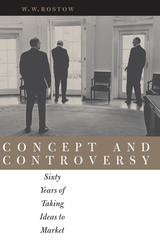 Concept and Controversy: Sixty Years of Taking Ideas to Market
By W. W. Rostow
University of Texas Press, 2003 A trusted advisor to Presidents Eisenhower, Kennedy, and Johnson and one of America's leading professors of economic history, W. W. Rostow has helped shape the intellectual debate and governmental policies on major economic, political, and military issues since World War II. In this thought-provoking memoir, he takes a retrospective look at eleven key policy problems with which he has been involved to show how ideas flow into concrete action and how actions taken or not taken in the short term actually determine the long run that we call "the future." The issues that Rostow discusses are these: - The use of air power in Europe in the 1940s
- Working toward a united Europe during the Cold War
- The death of Joseph Stalin and early attempts to end the Cold War
- Eisenhower's Open Skies policy
- The debate over foreign aid in the 1950s
- The economic revival of Korea
- Efforts to control inflation in the 1960s
- Waiting for democracy in China
- The Vietnam War and Southeast Asian policy
- U.S. urban problems in disadvantaged neighborhoods
- The challenges posed by declining population in the twenty-first century
In discussing how he and others have worked to meet these challenges, Rostow builds a compelling case for including long-term forces in the making of current policy. He concludes his memoir with provocative reflections on the twentieth and twenty-first centuries and on how individual actors shape history.
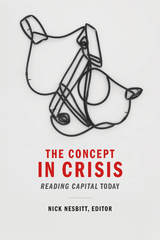 The Concept in Crisis: Reading Capital Today
Nick Nesbitt, editor
Duke University Press, 2017 The publication of Reading Capital—by Louis Althusser, Étienne Balibar, Roger Establet, Pierre Macherey, and Jacques Rancière—in 1965 marked a key intervention in Marxist philosophy and critical theory, bringing forth a stunning array of concepts that continue to inspire philosophical reflection of the highest magnitude. The Concept in Crisis reconsiders the volume’s reading of Marx and renews its call for a critique of capitalism and culture for the twenty-first century. The contributors—who include Alain Badiou, Étienne Balibar, and Fernanda Navarro—interrogate Althusser's contributions in particular within the context of what is surely the most famous collective reading of Marx ever undertaken. Among other topics, they offer a symptomatic critique of Althusser; consider his writing as a materialist production of knowledge; analyze the volume’s conceptualization of value and crisis; examine how leftist Latin American leaders like Che Guevara and Subcomandante Marcos engaged with Althusser and Reading Capital; and draw out the volume's implications and use for feminist theory and praxis. Retrieving the inspiration that drove Althusser's reinterpretation of Marx, The Concept in Crisis explains why Reading Capital's revolutionary inflection retains its critical appeal, prompting readers to reconsider Marx's relevance in an era of neoliberal capitalism.
Contributors. Emily Apter, Alain Badiou, Étienne Balibar, Bruno Bosteels, Adrian Johnston, Warren Montag, Fernanda Navarro, Nick Nesbitt, Knox Peden, Nina Power, Robert J. C. Young
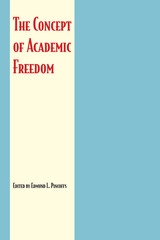 The Concept of Academic Freedom
Edited by Edmund L. Pincoffs
University of Texas Press, 1975 Most professors and administrators are aware that academic freedom is in danger of being brushed aside by a public that has little understanding of what is at stake. They may be only marginally aware that the defense of academic freedom is endangered by certain confusions concerning the nature of academic freedom, the criteria for its violation, and the structure of an adequate justification for claims to it. These confusions were enshrined in some of the central documents on the subject, including the 1940 Statement on Academic Freedom and Tenure, agreed upon by the American Association of University Professors and the Association of American Colleges and endorsed by many professional organizations. Careful analysis of them will not do away with debate; it will bring the debate into focus, so that attacks on academic freedom can be appraised as near or far away from the center of the target and can then be appropriately answered. Nearly all the contemporary writing on academic freedom consists of attack or defense. The Concept of Academic Freedom is the first book to deal exclusively with fundamental conceptual issues underlying the battle. In the discussion of these issues, certain philosophical positions crystallize: radical versus liberal conceptions of the status and function of university teachers, specific versus general theories of academic freedom, consequential versus nonconsequential theories of justification. Partisans (and enemies) of academic freedom would do well to decide on which side of these divisions they stand, or how they would mediate between sides. Otherwise many questions will remain unclear: What is under discussion—a special right peculiar to academics or a general right that is especially important to academics? Is justification of that right possible? Can the right be derived from other rights, or from the theory of justice or of democratic society? Or is the argument for academic freedom one that more properly turns on the consequences for society as a whole if that freedom is not protected? The essays in this book explore these and other problems concerning the defense of academic freedom by radicals, the justification for disruption on campus, and the control of research. Contributors to the volume include Hugo Adam Bedau, Bertram H. Davis, Milton Fisk, Graham Hughes, Alan Pasch, Hardy E. Jones, Alexander Ritchie, Amelie Oksenberg Rorty, Rolf Sartorius, T. M. Scanlon, Richard Schmitt, John R. Searle, Judith Jarvis Thomson, and William Van Alstyne. All are outstanding in their fields. Many have had practical experience in the legal profession or with the American Association of University Professors on the issue of academic freedom.
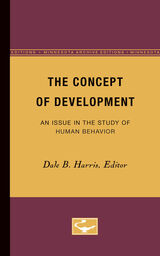 The Concept of Development: An Issue in the Study of Human Behavior
Dale Harris
University of Minnesota Press, 1967
The Concept of Development was first published in 1967.In the various disciplines which make up the behavioral sciences, the concept of development plays a useful and significant role. The need has existed, however, for more unity of thought regarding the meaning of the concept, and this volume represents a long step ahead toward that goal.The book contains a series of 17 papers by as many contributors from the fields of psychology, philosophy, the natural sciences, medical science, social science, and the humanities. The chapters are arranged in five sections: Issues in the Study of Development, Biology and Growth, The Development of Human Behavior, The Concept of Development in the Humanities and Social Sciences, and Social Applications of the Developmental Concept.The contributors are Dale B. Harris, Ernest Nagel, John E. Anderson, Viktor Hamburger, J. P. Scott, T. C. Schneirla, Howard V. Meredith, Heinz Werner, Robert R. Sears, Wallace A. Russell, Norman J. DeWitt, Herbert Heaton, Robert F. Spencer, John A. Anderson, M.D., Hyman S. Lippman, M.D., John C. Kidneigh, and Willard C. Olson.The book is especially appropriate for text use or collateral reading in courses in psychology, education, sociology, or child development.
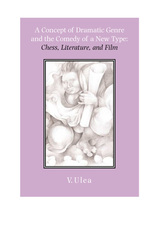 A Concept of Dramatic Genre and the Comedy of a New Type
V. Ulea
Southern Illinois University Press, 2002
Applying systems theory to the comedies of Chekhov, Balzac, Kleist, Moliere, and Shakespeare, A Concept of Dramatic Genre and the Comedy of a New Type: Chess, Literature, and Film approaches dramatic genre from the point of view of the degree of richness and strength of a character’s potential. Its main focus is to establish a methodology for analyzing the potential from multidimensional perspectives, using systems thinking. The whole concept is an alternative to the Aristotelian plot-based approach and is applied to an analysis of western and eastern European authors as well as contemporary American film.
This innovative study consists of three parts: The first part is mostly theoretical, proposing a new definition of the dramatic as a category linked to general systems phenomena and offering a new classification of dramatic genre. In the second part, Ulea offers a textual analysis of some works based on this new classification. She analyzes comedies, tragedies, and dramas on the same or similar topics in order to reveal what makes them belong to opposite types of dramatic genre.
Additionally, she considers the question of fate and chance, with regard to tragedy and comedy, from the point of view of the predispositioning theory. In the third part, Ulea explores an analysis of the comedy of a new type—CNT. Her emphasis is on the integration of the part and the whole in approaching the protagonist’s potential. She introduces the term quasi-strong potential in order to reveal the illusory strength of protagonists of the CNT and to show the technique of CNT’s analysis and synthesis.
Ulea’s research begins with the notion of the comic, traditionally considered synonymous with the laughable, and attempts to approach it as independent from the laughable and laughter. The necessity to do so is dictated by the desire to penetrate the enigmatic nature of Chekhov’s comedy. The result is A Concept of Dramatic Genre and the Comedy of a New Type: Chess, Literature, and Film, a completely new approach to potential and systems thinking—which has never been a focus of dramatic theory before. Such potential is the touchstone of the comic and comedy, their permanent basic characteristic, the heart and axis around which the comedic world spins.
 The Concept of Heart Failure: From Avicenna to Albertini
Saul Jarcho
Harvard University Press, 1980 The Concept of Heart Failure surveys the development of our ideas, both clinical and theoretical, on important aspects of cardiac and pulmonary disease, from the eleventh to the mid-eighteenth century. Before a unified and centralized concept of congestive heart failure was established, individual parts of the syndrome were regarded as discrete clinical entities. As a result, discussion of the syndrome is scattered throughout medieval and Renaissance literature.
Dr. Saul Jarcho, a noted clinician and medical historian, renders a great service in gathering together many little known sources and, with rich commentaries on each author, making them accessible to the modern reader. His translations of Latin, Arabic, and other texts are fluent and skillful. With its thorough documentation, concluding overview, and appendix on the relation between suffocative catarrh and pulmonary edema, The Concept of Heart Failure will be a rich resource for clinicians and historians alike.
 The Concept of Ius and the Nature of Law in Thomas Aquinas
Loic-Marie Le Bot, OP
Catholic University of America Press, 2025 This collection of essays constitutes the fruit of a scholarly conference held in Rome in April 2023, which was organized by the Pontifical University of Saint Thomas Aquinas, the Pontifical University of the Holy Cross, and the Angelicum Thomistic Institute.
The essays offer a scholarly reflection on various historical and doctrinal aspects of Aquinas’s concept of ius, and on the extent to which this concept helps to illuminate his account of the nature of law, that is, of the juridical phenomenon. Each essay addresses, from the viewpoint of its specific topic, the implications of the Angelic Doctor’s description of ius as the object of justice, as presented in the Secunda secundae of his Summa theologiae (starting from question 57, article 1). Following Aquinas’s own insights, the focus on the virtue of justice is thus deemed crucial for understanding the essence or the ontological fabric of law. Justice is simultaneously analyzed as always remaining inherently connected to its moral and divine-salvific aspects.
The volume is divided in three parts. The first part of the collection contains essays that are dedicated to the analysis of Aquinas’s concept of ius in a historical perspective. The second group of essays in this collection examine some further doctrinal and contextual issues pertinent to the essence of ius. Each attempt to elucidate the ontology of law should be supported by the aptitude of the resulting accounts of law’s nature to provide workable platforms for legal practices. This line of reasoning represents the rationale for the third part of this collection, which focuses on the matters of applying Aquinas’s concept of ius in systemic and practical legal settings of State law and canon law.
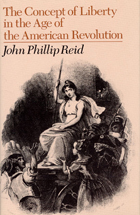 The Concept of Liberty in the Age of the American Revolution
John Phillip Reid
University of Chicago Press, 1988 "Liberty was the most cherished right possessed by English-speaking people in the eighteenth century. It was both an ideal for the guidance of governors and a standard with which to measure the constitutionality of government; both a cause of the American Revolution and a purpose for drafting the United States Constitution; both an inheritance from Great Britain and a reason republican common lawyers continued to study the law of England."
As John Philip Reid goes on to make clear, "liberty" did not mean to the eighteenth-century mind what it means today. In the twentieth century, we take for granted certain rights—such as freedom of speech and freedom of the press—with which the state is forbidden to interfere. To the revolutionary generation, liberty was preserved by curbing its excesses. The concept of liberty taught not what the individual was free to do but what the rule of law permitted. Ultimately, liberty was law—the rule of law and the legalism of custom. The British constitution was the charter of liberty because it provided for the rule of law.
Drawing on an impressive command of the original materials, Reid traces the eighteenth-century notion of liberty to its source in the English common law. He goes on to show how previously problematic arguments involving the related concepts of licentiousness, slavery, arbitrary power, and property can also be fit into the common-law tradition. Throughout, he focuses on what liberty meant to the people who commented on and attempted to influence public affairs on both sides of the Atlantic. He shows the depth of pride in liberty—English liberty—that pervaded the age, and he also shows the extent—unmatched in any other era or among any other people—to which liberty both guided and motivated political and constitutional action.
The Concept of Mind
Gilbert Ryle
University of Chicago Press, 2003 This now-classic work challenges what Ryle calls philosophy's "official theory," the Cartesians "myth" of the separation of mind and matter. Ryle's linguistic analysis remaps the conceptual geography of mind, not so much solving traditional philosophical problems as dissolving them into the mere consequences of misguided language. His plain language and esstentially simple purpose place him in the traditioin of Locke, Berkeley, Mill, and Russell.
The Concept of Political Judgment
Peter J. Steinberger
University of Chicago Press, 1993 What is good political judgment? Is it a science subject to strict standards of logic and inference, or is it more like an art, the product of intuition, feeling, or even chance? Peter J. Steinberger shows how the seemingly contradictory claims of inference and intuition are reconciled in the concept of political judgment.
Resting his argument on the larger notion of judgment itself, Steinberger develops an original model of how political judgments are made and how we justify calling some of them "good." His systematic analysis of such thinkers as Machiavelli, Kant, Gadamer, Wittgenstein, and Oakeshott introduces an original notion of judgment as "intelligent performance," incorporating both intuition and rational reconstruction.
Steinberger's conclusion—that a coherent political society must also be a judgmental one—flies in the face of much contemporary thinking.
 The Concept of Representation in the Age of the American Revolution
John Phillip Reid
University of Chicago Press, 1989 "Americans did not rebel from Great Britain because they wanted a different government. They rebelled because they believed that Parliament was violating constitutional precepts. Colonial Whigs did not fight for American rights. They fought for English rights."—from the Preface
John Phillip Reid goes on to argue that it was generally the application, not the definition, of these rights that was disputed. The sole—and critical—exception concerned the right of representation. American perceptions of the responsibility of representatives to their constituents, the necessity of equal representation, and the constitutional function of consent had diverged gradually, but significantly, from British tradition. Drawing on his mastery of eighteenth-century legal thought, Reid explores the origins and shifting meanings of representation, consent, arbitrary rule, and constitution. He demonstrates that the controversy which led to the American Revolution had more to do with jurisprudential and constitutional principles than with democracy and equality. This book will interest legal historians, Constitutional scholars, and political theorists.
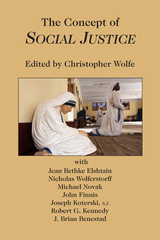 The Concept of Social Justice
Christopher Wolfe
St. Augustine's Press, 2018 “Social justice” is a term heard a great deal today, but what does it mean? It does not appear in pre-nineteenth century classic texts on justice. Is it a social agenda inspired by compassion? Is it a particular set of institutional arrangements to achieve justice? What the term means, and – in some quarters – whether it is even a term worth using, is a matter of controversy.
The inspiration for this book comes from the fact that current discussions of “social justice” often deal overwhelmingly with programs that aim to advance certain specific and controversial policies to deal with various social problems. In the process, important theoretical questions about social justice are not even confronted, much less resolved. For example, what does the word “social” add to “justice”? Isn't all justice “social”? What is the relation between “social justice” and more classical Aristotelian terms such as “distributive justice,” “commutative justice,” and “legal justice”? With respect to its current usage, is the term “social justice” applicable only to special policies or programs (e.g., government or nonprofit social welfare programs)? Does it apply only to the provision of material goods and services? Does it play a role in the ordinary everyday world of business and work?
The papers in this book aim, not at identifying some particular set of public policies that allegedly constitute the right content of “social justice,” but at reflection on the meaning of social justice. It is not an exhortation to pursue policies that are “understood,” without discussion, to be the right way to pursue social justice. It is not aimed at stimulating activism, mobilizing people to go out and achieve social justice now. Rather, it aims at building the foundation upon which people can identify general principles of justice, and make reasonable prudential judgments about how to pursue social justice. This theoretical orientation means that it is neither “right-wing” nor “left-wing.” The Concept of Social Justice provides a range of insightful essays on the term and on its various uses and abuses. The authors of these papers are committed to something like “social justice” – they don't believe that it is spurious notion that should be rejected. They may very well disagree about exactly how to pursue social justice. But their primary concern here is to ask, simply, “what is social justice?”
Jean Bethke Elshtain and Michael Novak show various ways in which the term has been misunderstood or narrowed or abused for ideological reasons. Nicholas Wolterstorff’s essay makes careful distinctions necessary to identify the implications of adding “social” to “justice” and fleshes out a valuable notion of the concept. John Finnis locates the origins of social justice in an historical misreading of Thomas Aquinas’ discussion of justice, which narrowed his “general justice” in a way that required a new notion of “social justice.” Joseph Koterksi, S.J., Robert Kennedy, and J. Brian Benestad each elaborate some of the ways in which “social justice” has been used in the Catholic social teaching since Rerum Novarum and in international theological and U.S. episcopal documents.
Readers will come away from this book with a deeper understanding of the origins of social justice, a sensitivity to the frequent abuses of the term, and a recognition of the forms in which it can be a valuable part of today’s political discourse.
The Concept of the Political
Carl Schmitt
University of Chicago Press, 1996 In this, his most influential work, legal theorist and political philosopher Carl Schmitt argues that liberalism's basis in individual rights cannot provide a reasonable justification for sacrificing oneself for the state. This edition of the 1932 work includes the translator's introduction (by George Schwab) which highlights Schmitt's intellectual journey through the turbulent period of German history leading to the Hitlerian one-party state. It also includes Leo Strauss's analysis of Schmitt's thesis and a foreword by Tracy B. Strong placing Schmitt's work into contemporary context.
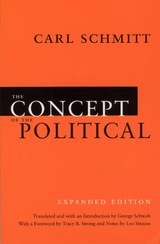 The Concept of the Political: Expanded Edition
Carl Schmitt
University of Chicago Press, 2007 In this, his most influential work, legal theorist and political philosopher Carl Schmitt argues that liberalism’s basis in individual rights cannot provide a reasonable justification for sacrificing oneself for the state—a critique as cogent today as when it first appeared. George Schwab’s introduction to his translation of the 1932 German edition highlights Schmitt’s intellectual journey through the turbulent period of German history leading to the Hitlerian one-party state. In addition to analysis by Leo Strauss and a foreword by Tracy B. Strong placing Schmitt’s work into contemporary context, this expanded edition also includes a translation of Schmitt’s 1929 lecture “The Age of Neutralizations and Depoliticizations,” which the author himself added to the 1932 edition of the book. An essential update on a modern classic, The Concept of the Political, Expanded Edition belongs on the bookshelf of anyone interested in political theory or philosophy.
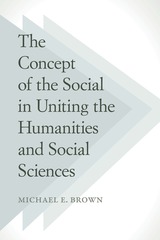 The Concept of the Social in Uniting the Humanities and Social Sciences
Michael E. Brown
Temple University Press, 2015 In this book, Michael Brown provides original and critical analysis of the state of the social sciences and the humanities. He examines the different disciplines that address human affairs--from sociology, philosophy, political science, and anthropology to the humanities in general--to understand their common ground. He probes the ways in which we investigate the meaning of individuality in a society for which individuals are not the agents of the activities in which they participate, and he develops a critical method for studying the relations among activities, objects, and situations. The Concept of the Social in Uniting the Humanities and Social Sciences restores the centrality of sociality to all disciplines that provide for and depend on the social dimension of human life. Ultimately, he establishes a theory of the unity of the human sciences that will surely make readers rethink the current state and future of theory in those fields for years to come.
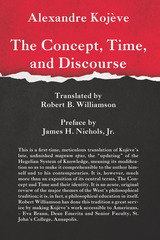 The Concept, Time, and Discourse
Alexandre Kojève
St. Augustine's Press, 2019 Alexandre Kojève (1902–1968) is most widely known in America for his provocative assertion that history is at its end, that is, its completion. In the “practical” sense, this means that the process of historical development can at last be seen (if from a distance) as the realization of the Marxist “universal and homogeneous state.” However, Kojève claimed as well that the history of philosophical thinking had also reached its goal in the transformation of philosophy, as the “love of wisdom” (or the unsatisfied quest for comprehensive knowledge), into that very Wisdom itself and had done so in the most essential respects in the philosophy of Hegel. The Concept, Time, and Discourse is the first volume of Kojève’s magnum opus, which was to have given an exposition of the (Hegelian) System of Knowledge and of which five volumes were written before his death. It contains, along with a preliminary discussion of the need for an updating of the Hegelian system, the first two of three introductions to the exposition of that system: a First Introduction of the Concept (the integrated totality of what is comprehensible, which is the final object of philosophic inquiry) and a Second Introduction concerning Time, both introductions leading to the (Hegelian) identification of the Concept with Time, an identification which alone takes adequate account of the fact that Philosophy is necessarily discursive (that it must actualize the requirements and essential structure of Discourse). The present volume offers Kojève’s fullest statement of his Ontology. It includes a critical discussion of the traditional oppositions of the “general” to the “particular” and of the “abstract” to the “concrete” and an analysis of the act of “generalizing abstraction,” which detaches Essence from the Existence of Things. Kojève then discusses the three great figures in the three-stage development of philosophy into wisdom: Parmenides, Plato, and Hegel. Parmenides’ monadic account of Being (= Eternity) rendered it ineffable, thereby reducing philosophy to (non-philosophic) silence; Plato’s dyadic account of Being (as eternal) was intended to make Being a possible subject of discourse but failed to reflect adequately the triadic (and temporally developing) structure which Plato himself discerned in Discourse. Finally, Hegel’s triadic account of Being as itself “dialectical” achieved the final identification of the Concept with Time. This is a first-time, meticulous translation of Kojève’s late, unfinished magnum opus, the “updating” of the Hegelian System of Knowledge, meaning its modification so as to make it comprehensible to the author himself and to his contemporaries. It is, however, much more than an exposition of its central terms, The Concept and Time and their identity. It is an acute, original review of the major themes of the West’s philosophical tradition; it is, in fact, a philosophical education in itself. Robert Williamson has done this tradition a great service by making Kojève’s work accessible to Americans. – Eva Brann, Dean Emerita and Senior Faculty, St. John’s College, Annapolis, Maryland We now recognize Alexandre Kojève as one of the central figures of 20th century European philosophy. A translation of his The Concept, Time, and Discourse will enable English speaking readers to have a fuller understanding of his remarkably ambitious intellectual project. – Michael S. Roth, President, Wesleyan University, Middletown, Connecticut. Robert B. Williamson is Tutor Emeritus at St. John’s College in Annapolis, Maryland, where he continues to teach. He is co-author, with Alfred Mollin, of An Introduction to Ancient Greek (University Press of America) and the author of articles on Plato’s philosophy and Einstein’s early work on relativity theory. James H. Nichols, Jr. is Professor of Government and Dr. Jules L. Whitehill Professor of Humanism and Ethics at Claremont McKenna College, where he teaches political philosophy. Among his publications are Epicurean Political Philosophy: The De rerum natura of Lucretius, translations with interpretations of Plato’s Gorgias and Phaedrus, and most recently Alexandre Kojève: Wisdom at the End of History.
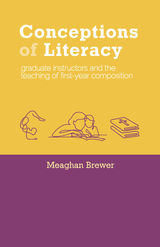 Conceptions of Literacy: Graduate Instructors and the Teaching of First-Year Composition
Meaghan Brewer
Utah State University Press, 2020 Addressing the often fraught and truncated nature of educating new writing instructors, Conceptions of Literacy proposes a theoretical framework for examining new graduate student instructors’ preexisting attitudes and beliefs about literacy. Based on an empirical study author Meaghan Brewer conducted with graduate students teaching first-year composition for the first time, Conceptions of Literacy draws on narratives, interviews, and classroom observations to describe the conceptions of literacy they have already unknowingly established and how these conceptions impact the way they teach in their own classrooms.
Brewer argues that conceptions of literacy undergird the work of writing instructors and that many of the anxieties around composition studies’ disciplinary status are related to the differences perceived between the field’s conceptions of literacy and those of the graduate instructors and adjuncts who teach the majority of composition courses. Conceptions of Literacy makes practical recommendations for how new graduate instructors can begin to perceive and interrogate their conceptions of literacy, which, while influential, are often too personal to recognize.
Concepts and the Social Order: Robert K. Merton and the Future of Sociology
Andras Szigeti
Central European University Press, 2011 Offers a comprehensive perspective on knowledge production in the field of sociology. Moreover, it is a tribute to the scope of Merton's work and the influence Merton has had on the work and life of sociologists around the world. This is reflected in each of the 12 chapters by internationally acclaimed scholars witnessing the range of fields Merton has contributed to as well as the personal impact he has had on sociologists. This approach is in itself a tribute to Merton: an analysis of knowledge production through a contextualized review of an author's life-work – a quintessentially "Mertonian" enterprise.
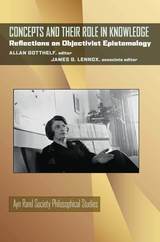 Concepts and Their Role in Knowledge: Reflections on Objectivist Epistemology
Allan Gotthelf
University of Pittsburgh Press, 2022
The philosopher and novelist Ayn Rand (1905–1982) is a cultural phenomenon. Her books have sold more than twenty-eight million copies, and countless individuals speak of her writings as having significantly influenced their lives. Despite her popularity, Rand’s philosophy of Objectivism has received little serious attention from academic philosophers.
Concepts and Their Role in Knowledge offers scholarly analysis of key elements of Ayn Rand’s radically new approach to epistemology. The four essays, by contributors intimately familiar with this area of her work, discuss Rand’s theory of concepts—including its new account of abstraction and essence—and its central role in her epistemology; how that view leads to a distinctive conception of the justification of knowledge; her realist account of perceptual awareness and its role in the acquisition of knowledge; and finally, the implications of that theory for understanding the growth of scientific knowledge. The volume concludes with critical commentary on the essays by distinguished philosophers with differing philosophical viewpoints and the author’s responses to those commentaries.
This is the second book published in Ayn Rand Society Philosophical Studies, which was developed in conjunction with the Ayn Rand Society to offer a fuller scholarly understanding of this highly original and influential thinker. The Ayn Rand Society, an affiliated group of the American Philosophical Association, Eastern Division, seeks to foster scholarly study by philosophers of the philosophical thought and writings of Ayn Rand.
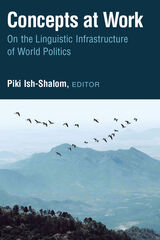 Concepts at Work: On the Linguistic Infrastructure of World Politics
Piki Ish-Shalom, Editor
University of Michigan Press, 2021 Concepts are socially and linguistically constructed and used for multiple purposes, such as justifying war in the name of democracy; or, using the idea of democracy to resist Western intervention and influence. In this fascinating and novel edited collection, Piki Ish-Shalom and the contributors interrogate the “conceptions of concepts” in international relations. Using theoretical frameworks from Gramsci and Bourdieu, among others, the authors show that not interrogating the meaning of the language we use to talk about international relations obscures the way we understand (or portray) IR. The authors examine self-determination, winning in war, avoidance of war, military design and reform agenda, vagueness in political discourse, “blue economy,” friendship, and finally, the very idea of the “international community” itself. As the author asserts, Bourdieu’s sociology of field and Gramsci’s political theory, combined, “offer us a socio-political theory of relations of power and domination concealed by doxic knowledge and taken-for-granted rules, in which essential contested concepts and political-serving conceptions can and do play an important role.”
Concepts of Ethnicity
William Petersen, Michael Novak, and Philip Gleason
Harvard University Press, 1982 The monumental Harvard Encyclopedia of American Ethnic Groups is the most authoritative single source available on the history, culture, and distinctive characteristics of ethnic groups in the United States. The Dimensions of Ethnicity series is designed to make this landmark scholarship available to everyone in a series of handy paperbound student editions. Selections in this series will include outstanding articles that illuminate the social dynamics of a pluralistic nation or masterfully summarize the experience of key groups. Written by the best-qualified scholars in each field, Dimensions of Ethnicity titles will reflect the complex interplay between assimilation and pluralism that is a central theme of the American experience.
The tightening and loosening of ethnic identity under changing definitions of “Americanism” is emphasized in this volume.
 Concepts of International Relations, for Students and Other Smarties
Iver B. Neumann
University of Michigan Press, 2019 Concepts of International Relations, for Students and Other Smarties is not a stereotypical textbook, but an instructive, entertaining, and motivating introduction to the field of International Relations (IR). Rather than relying on figures or tables, this book piques the reader’s interest with a pithy narrative that presents apposite nutshell examples, stresses historical breaks, and throws in the odd pun. Based on Iver B. Neumann’s introductory lectures to his students at the London School of Economics, this book is proven for the classroom.
In a relaxed style, Neumann introduces the long-term historical emergence of concepts such as state (European), state (global), empire, nonstate agents, foreign policy, state system, nationalism, globalization, security, international society, great powers, diplomacy, war and peace, balance of power, international law, power and sovereignty, intervention, gender, and class. He demonstrates how such phenomena have been understood in different ways over time. First, the reader learns how the use of concepts is an integral part of politics. Second, the reader sees how social change has worked in the past, and is working now. Third, the book demonstrates how historical and social context matters in ongoing international relations.
 Concepts of Person: Kinship, Caste, and Marriage in India
Ákos Östör
Harvard University Press, 1982 Concepts of Person is the first comprehensive review of new developments in symbolic, structural, and cultural anthropology applied to a specific area—in this case, India. Using rich ethnographic detail, it looks at the extent to which new models of kinship, caste, and marriage translate into regional and Indian models. The contributors, all distinguished scholars of South Asia, tackle different geographical areas and such diverse topics as hierarchy, forms of address, ritual, household, and widowhood. But central to each chapter is a focus on the idea of the person in social relations: when, where, and how is a person a person, and how is this construction related to kinship studies in general? By applying these questions to South Asian models of the person, this book promises to play a central role in our future understanding of kinship, the possibilities for cross-cultural comparison, and ways of looking at social change.
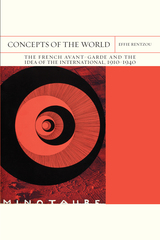 Concepts of the World: The French Avant-Garde and the Idea of the International, 1910–1940
Effie Rentzou
Northwestern University Press, 2022 How did the avant-garde imagine its interconnected world? And how does this legacy affect our understanding of the global today?
The writers and artists of the French avant-garde aspired to reach a global audience that would be wholly transformed by their work. In this study, Effie Rentzou delves deep into their depictions of the interwar world as an international and modern landscape, one marked by a varied cosmopolitanism. The avant-garde’s conceptualization of the world paralleled, rejected, or expanded prevailing notions of the global sphere.
The historical avant garde—which encompassed movements like futurism, Dada, and surrealism—was self-consciously international, operating across global networks and developed with the whole world as its horizon and its public. In the heady period between the end of the Belle Époque and the tumult of World War II, both individual artists (including Guillaume Apollinaire, Blaise Cendrars, Francis Picabia, Louis Aragon, Leonora Carrington, and Nicolas Calas) and collective endeavors (such as surrealist magazines and exhibitions) grappled with contemporary anxieties about economic growth, imperialism, and colonialism, as well as various universalist, cosmopolitan, and internationalist visions. By probing these works, Concepts of the World offers an alternative narrative of globalization, one that integrates the avant-garde’s enthusiasm for, as well as resistance to, the process. Rentzou identifies within the avant-garde a powerful political language that expressed the ambivalence of living and creating in an increasingly globalized world—a language that profoundly shaped the way the world has been conceptualized and is experienced today.
The Concepts, Process and Methods of Social Impact Assessment
Rabel J. Burdge
University Press of Colorado, 2018 This Social Impact Assessment textbook provides the reader with details on the background and development of the SIA concept to include the methods, guidelines and principles for conducting an actual Social Impact Assessment. These sections are followed by actual SIA case studies to include the use of public involvement in the SIA process. The text concludes with the application of SIA outside the United States and international principles for doing Social Impact Assessment.
Concepts, Theories, and Rationality in the Biological Sciences
Gereon Wolters, James G. Lennox
University of Pittsburgh Press, 2022 A Unified Report on the “State of the Art” in the Philosophy of Biology
In October 1993, the University of Pittsburgh hosted the Second Pittsburgh-Konstanz Colloquium in the Philosophy of Science, with a focus on the rapidly growing field of philosophy of biology. An interdisciplinary group of philosophers and scientists came together to discuss the basic theories and concepts of biology and their connections with ethics, economics, and psychology. The colloquium organizers strove to create an event that would provide attendees with a wide overview on the current state of the philosophy of biology, with as many topics and views on these topics as possible. Those presentations are gathered here in a volume that offers the reader a varied and thorough survey of the field.
 Concepts, Theories, and the Mind-Body Problem
Herbert Feigl, Michael Scriven, and Grover Maxwell, Editors
University of Minnesota Press, 1958 Concepts, Theories, and the Mind-Body Problem was first published in 1958. Minnesota Archive Editions uses digital technology to make long-unavailable books once again accessible, and are published unaltered from the original University of Minnesota Press editions. This is Volume II of the Minnesota Studies in the Philosophy of Science, a series published in cooperation with the Minnesota Center for Philosophy of Science at the University of Minnesota. The series editors are Herbert Feigl and Grover Maxwell, who are also co-editors, with Michael Scriven, of this volume. The ten papers by eleven authors which make up the content of this volume are the result of collaborative research of the Center in philosophical and methodological problems of science in general and psychology in particular. The contributors are Paul Oppenheim, Hilary Putnam, Carl G. Hempel, Michael Scriven, Arthur Pap, Wilfrid Sellars, H. Gavin Alexander, P.F. Strawson, Karl Zener, Herbert Feigl, and Paul E. Meehl. In addition, an extensive discussion of "Internationality and the Mental" by Wilfrid Sellars and Roderick Chisholm is presented in an appendix. In a review of this volume the journal Psychiatric Quarterly commented: "These essays will not prove easy for the layman to read, but he can hardly fail to find his effort rewarded if he is persistent. For the professional behavioral scientist increased awareness and caution—in his use of scientific language, and thinking about scientific theory—should result." One of the papers in this volume, "The 'Mental' and the 'Physical'" by Herbert Feigl, has been published by the University of Minnesota Press with further discussion by Dr. Feigl as a separate book, The "Mental" and the "Physical": The Essay and a Postscript.
Conceptual Harmonies: The Origins and Relevance of Hegel’s Logic
Paul Redding
University of Chicago Press, 2023 A new reading of Hegel’s Science of Logic through the history of European mathematics.
Conceptual Harmonies develops an original account of G. W. F. Hegel’s perplexing Science of Logic from a simple insight: philosophical and mathematical thought have shaped each other since classical times. Situating Science of Logic within the rise of modern mathematics, Redding stresses Hegel’s attention to Pythagorean ratios, Platonic reason, and Aristotle’s geometrically inspired logic. He then explores how later traditions shaped Hegel’s world, through both Leibniz and new forms of algebraic geometry. This enlightening reading recovers an overlooked stream in Hegel’s philosophy that remains, Redding argues, important for contemporary conceptions of logic.
Conceptual Structure, Discourse and Language
Edited by Adele Goldberg
CSLI, 1996 This collection of papers is the outcome of the first Conceptual Structure, Discourse and Language conference (CSDL) held at the University of Califronia, San Diego in October 1995. CSDL was organized with the intention of bringing together researchers from both "cognitive" and "functional" approaches to linguistics. The papers in this volume span a variety of topics, but there is a common thread running through them: the claim that semantics and discourse properties are fundamental to our understanding of language.
Conceptualising "Home": The Question of Belonging among Turkish Families in Germany
Esin Bozkurt
Campus Verlag, 2009 An extraordinarily rich account of the lives of Turkish men and women living in contemporary Germany, Conceptualising 'Home' offers striking insights into how members of a marginalized immigrant community make room for themselves and reconstruct homes away from home. Based on in-depth interviews, the volume places the life experiences of Turkish people into a broader theoretical perspective, while Esin Bozkurt's careful attention to gender and generational differences ensures an accurate, balanced representation. The result is a surprisingly useful understanding of the very idea of "home."
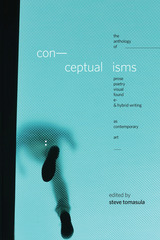 Conceptualisms: The Anthology of Prose, Poetry, Visual, Found, E- & Hybrid Writing as Contemporary Art
Edited by Steve Tomasula
University of Alabama Press, 2022 A wide-ranging anthology of experimental writing—prose, poetry, and hybrid—from its most significant practitioners and innovators
A variety of names have been used to describe fiction, poetry, and hybrid writing that explore new forms and challenges mainstream traditions. Those phrases include experimental, conceptual, avant-garde, hybrid, surfiction, fusion, radical, slip-stream, avant-pop, postmodern, self-conscious, innovative, L=A=N=G=U=A=G=E writing, alternative, and anti- or new literature. Conceptualisms: The Anthology of Prose, Poetry, Visual, Found, E- & Hybrid Writing as Contemporary Art is the first major anthology of writing that offers readers an overview of this other tradition as it lives in the early decades of the 21st century.
Featuring over 100 pieces from more than 90 authors, this anthology offers a plethora of aesthetics and approaches to a wide variety subjects. Editor Steve Tomasula has gathered poems, prose, and hybrid pieces that all challenge our understanding of what literature means. Intended as a collection of the most exciting and bold literary work being made today, Tomasula has put a spotlight on the many possibilities available to writers and readers wishing for a glimpse of literature’s future.
Readers will recognize authors who have shaped contemporary writing, as among them Lydia Davis, Charles Bernstein, Jonathan Safran Foer, Shelley Jackson, Nathaniel Mackey, David Foster Wallace, and Claudia Rankine. Even seasoned readers will find authors, and responses to the canon, not yet encountered. Conceptualisms is a book of ideas for writers, teachers and scholars, as well as readers who wonder how many ways literature can live.
The text features headnotes to chapters on themes such as sound writing, electronic literature, found text, and other forms, offering accessible introductions for readers new to this work. An online companion presents statements about the work and biographies of the authors in addition to audio, video, and electronic writing that can’t be presented in print. Visit www.conceptualisms.info to read more.
 Conceptualizing 21st-Century Archives
Anne J. Gilliland
Society of American Archivists, 2014 The digital age has spurred constant technological and sociocultural change. In Conceptualizing 21st-Century Archives, author Anne J. Gilliland explores the shifts and divergences in archival discourse that technological developments have necessitated, facilitated, or inspired. Gilliland addresses the lessons the archival and recordkeeping fields can learn from their evolution about ideas tried and abandoned; which ideas are truly new, and which continue to hold good, regardless of technological shifts; and the ways in which archivists need to expand their thinking and practices to fulfill their global and local “glocal”—roles.
By understanding how archival practices and thinking were challenged or how archivists responded at different points over the past century, the reader can begin to discern how and why ideas rise, fall, and resurge. The book traces the development of descriptive systems, the creation and management of computer-generated records, and the curation of digital materials. With each chapter, Gilliland addresses either the historical development or the current state of an area within archival science that information and communications technology have significantly affected to ultimately construct a picture of how archives arrived in the 21st century and to suggest where they might be going in the foreseeable future.
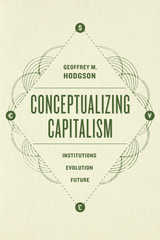 Conceptualizing Capitalism: Institutions, Evolution, Future
Geoffrey M. Hodgson
University of Chicago Press, 2015 A few centuries ago, capitalism set in motion an explosion of economic productivity. Markets and private property had existed for millennia, but what other key institutions fostered capitalism’s relatively recent emergence? Until now, the conceptual toolkit available to answer this question has been inadequate, and economists and other social scientists have been diverted from identifying these key institutions.
With Conceptualizing Capitalism, Geoffrey M. Hodgson offers readers a more precise conceptual framework. Drawing on a new theoretical approach called legal institutionalism, Hodgson establishes that the most important factor in the emergence of capitalism—but also among the most often overlooked—is the constitutive role of law and the state. While private property and markets are central to capitalism, they depend upon the development of an effective legal framework. Applying this legally grounded approach to the emergence of capitalism in eighteenth-century Europe, Hodgson identifies the key institutional developments that coincided with its rise. That analysis enables him to counter the widespread view that capitalism is a natural and inevitable outcome of human societies, showing instead that it is a relatively recent phenomenon, contingent upon a special form of state that protects private property and enforces contracts. After establishing the nature of capitalism, the book considers what this more precise conceptual framework can tell us about the possible future of capitalism in the twenty-first century, where some of the most important concerns are the effects of globalization, the continuing growth of inequality, and the challenges to America’s hegemony by China and others.
 Concern for the Other: Perspectives on the Ethics of K. E. Logstrup
Svend Andersen
University of Notre Dame Press, 2007
The Danish philosopher K. E. Løgstrup is best known in the Anglo-American world for his original work in ethics, primarily in The Ethical Demand (original Danish edition, 1956). Løgstrup continued to write extensively on issues in ethics and phenomenology throughout his life, and extracts from some of his later writings are now also available in translation in Beyond the Ethical Demand.
In Concern for the Other: The Ethics of K. E. Løgstrup, eleven scholars examine the structure, intention, and originality of Løgstrup's ethics as a whole. This collection of essays is a companion to Beyond the Ethical Demand, as well as to The Ethical Demand. The essays examine Løgstrup’s crucial concept of the “sovereign expressions of life”; his view of moral principles as a substitute for, or inferior form of, ethics; his relationships to other philosophers, including the twentieth-century British moral philosophers; and the role of his Lutheran background in his ethics. Løgstrup also firmly advanced the controversial thesis, examined by several essays in this volume, that the demand for “other-concern” central to his ethics does not depend on religious faith.
“The significance of Løgstrup’s work is well demonstrated by the substantive criticisms made of that work by the essays here collected. Hopefully this book will encourage others to engage this significant but unfortunately not well-known thinker.” —Stanley Hauerwas, Gilbert T. Rowe Professor of Theological Ethics, Duke Divinity School
“Svend Andersen and Kees van Kooten Niekerk have done a great service for everyone with the publication of this stellar book on the thought of Knud E. Løgstrup, the most prominent Danish theologian-philosopher of the last century. CONCERN FOR THE OTHER includes essays by renowned thinkers who critically engage Løgstrup’s work with both insight and depth. The book thereby provides an engagement with this important thinker’s ideas about morality, trust, and responsibility and yet also presents features of the current state of the debate within ethics. I enthusiastically commend this book to anyone interested in contemporary ethics and moral theory as well as the relation between theology and philosophy.” —William Schweiker, Edward L. Ryerson Distinguished Service Professor of Theological Ethics, The University of Chicago
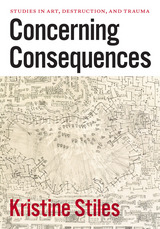 Concerning Consequences: Studies in Art, Destruction, and Trauma
Kristine Stiles
University of Chicago Press, 2016 Kristine Stiles has played a vital role in establishing trauma studies within the humanities. A formidable force in the art world, Stiles examines the significance of traumatic experiences both in the individual lives and works of artists and in contemporary international cultures since World War II. In Concerning Consequences, she considers some of the most notorious art of the second half of the twentieth century by artists who use their bodies to address destruction and violence.
The essays in this book focus primarily on performance art and photography. From war and environmental pollution to racism and sexual assault, Stiles analyzes the consequences of trauma as seen in the works of artists like Marina Abramovic, Pope.L, and Chris Burden. Assembling rich intellectual explorations on everything from Paleolithic paintings to the Bible’s patriarchal legacies to documentary images of nuclear explosions, Concerning Consequences explores how art can provide a distinctive means of understanding trauma and promote individual and collective healing.
 Concerning the Angels
Rafael Alberti
Four Way Books, 2025 In his first full-length translation, celebrated poet John Murillo (Winner of the Kingsley Tufts Award and the Four Quartets Prize) brings Rafael Alberti’s Concerning the Angels (Sobre los ángeles) to an English-reading audience. Murillo’s foreword introduces Sobre los ángeles as “a monument—albeit a severely neglected monument—of early twentieth-century literature.” Despite having “penned a masterwork of social and psychic malaise as deserving as any of its place in the global canon,” Alberti has disappeared into relative obscurity among readers of English language poetry, and Murillo’s crucial intervention allows the Spanish poet’s voice to once again echo prophetically from this book’s opening poem, “Paradise Lost”: “throughout the centuries, / through the nothingness of the world, / I, without sleep, search for you.” Insofar as the speaker addresses a figure named Shadow, he also seems to imagine us, his future readers, who need these prescient lyrics written in the time leading up to Spain’s civil war and ensuing decades of fascist rule. Bringing his signature gifts to translating from the Spanish, Murillo has given new life to what many consider Alberti’s magnum opus and delivered our marching orders for the resistance the future will require. “It is time you gave me your hand / and scratched into me the little light that catches a hole as it closes / and killed for me this evil word I plan to plunge into the thawing earth.”
 Concerto Conversations
Joseph Kerman
Harvard University Press, 1999 The concerto has attracted relatively little attention as a genre, Joseph Kerman observes, and his urbane and wide-ranging Norton Lectures fill the gap in a way that will delight all music listeners. Kerman addresses the full range of the concerto repertory, treating both the general and the particular. His perceptive commentary on individual works--with illustrative performances on the accompanying CD--is alive with enthusiasm, intimations, and insights into the spirit of concerto.
Concertos model human relationships, according to Kerman, and his description of the conversation between solo instrument and orchestra brings this observation vividly to life. What does the solo instrument do when it first enters in a concerto? How do composers balance claims of solo-orchestra contrast and solo virtuosity? When do they deploy the sumptuous musical textures that only concertos can provide? Kerman's unexpected answers offer a new understanding of the concerto and a stimulus to enhanced listening.
In language that the Boston Globe's Richard Dyer calls "always delightfully vivid," Kerman conducts readers and listeners into the conversations that concertos so eloquently enact. Amid the musical forces at play, he renews the dialogue of music lovers with the language of the concerto--the familiar, the lesser-known, the cherished, and the undervalued. The CD packaged with the book contains movements from works that Kerman treats most intensively--by Bach, Mozart, Beethoven, Liszt, Tchaikovsky, Bartók, Stravinsky, and Prokofiev.
 Concerto for the Left Hand: Disability and the Defamiliar Body
Michael Davidson
University of Michigan Press, 2010 "Professor Davidson---an accomplished literary critic---offers a focused and balanced analysis of poetry, film, and the arts honed with his excellent knowledge of the latest advances in disability studies. He is brilliant at reading texts in a sophisticated and aesthetically pleasurable way, making Concerto for the Left Hand one of the smartest books to date in disability studies."
---Lennard Davis, University of Illinois, Chicago "Moving elegantly among social theorists and cultural texts, Davidson exemplifies and propels an ethical-aesthetic model for criticism. Davidson asks continuously and with a committed intensity 'where a disability ends and the social order begins' . . . this book brings the study of poetry and poetics into the twenty-first century."
---Rachel Blau DuPlessis, Temple University Concerto for the Left Hand is at the cutting edge of the expanding field of disability studies, offering a wide range of essays that investigate the impact of disability across various art forms---including literature, performance, photography, and film. Rather than simply focusing on the ways in which disabled persons are portrayed, Michael Davidson explores how the experience of disability shapes the work of artists and why disability serves as a vital lens through which to interpret modern culture. Covering an eclectic range of topics---from the phantom missing limb in film noir to the poetry of American Sign Language---this collection delivers a unique and engaging assessment of the interplay between disability and aesthetics. Written in a fluid, accessible style, Concerto for the Left Hand will appeal to both specialists and general audiences. With its interdisciplinary approach, this book should appeal not only to scholars of disability studies but to all those working in minority art, deaf studies, visual culture, and modernism. Michael Davidson is Professor of American Literature at the University of California, San Diego. His other books include Guys Like Us: Citing Masculinity in Cold War Poetics and Ghostlier Demarcations: Modern Poetry and the Material World.
A Concise Coptic-English Lexicon, Second Edition
Richard Smith
SBL Press, 1999 This short Coptic lexicon addresses the needs of beginning Coptic students for a resource focused on vocabulary in the Nag Hammadi texts. The second edition includes additional word entries, updated definitions, and cross references.
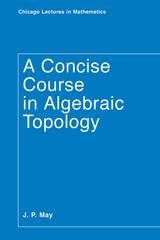 A Concise Course in Algebraic Topology
J. P. May
University of Chicago Press, 1999 Algebraic topology is a basic part of modern mathematics, and some knowledge of this area is indispensable for any advanced work relating to geometry, including topology itself, differential geometry, algebraic geometry, and Lie groups. This book provides a detailed treatment of algebraic topology both for teachers of the subject and for advanced graduate students in mathematics either specializing in this area or continuing on to other fields.
J. Peter May's approach reflects the enormous internal developments within algebraic topology over the past several decades, most of which are largely unknown to mathematicians in other fields. But he also retains the classical presentations of various topics where appropriate. Most chapters end with problems that further explore and refine the concepts presented. The final four chapters provide sketches of substantial areas of algebraic topology that are normally omitted from introductory texts, and the book concludes with a list of suggested readings for those interested in delving further into the field.
 Concise Dictionary of Minnesota Ojibwe
John Nichols
University of Minnesota Press, 1994 The most up-to-date resource for those interested in the linguistic and cultural heritage of the Anishinaabe, A Concise Dictionary of Minnesota Ojibwe contains more than 7,000 of the most frequently used Ojibwe words. Presented in Ojibwe-English and English-Ojibwe sections, this dictionary spells words to reflect their actual pronunciation with a direct match between the letters used and the speech sounds of Ojibwe. It contains many ancient words and meanings as well as language added in the twentieth century. Most entries give several sample inflected forms such as the plural, diminutive, and locative forms of nouns and first person and participle forms of verbs. The basic patterns of Ojibwe word structure and the organization of the dictionary entries are clearly explained in the introduction. The most widely used modern standard writing system for Ojibwe is used throughout, and some of the key objects of Ojibwe life are authentically illustrated by coauthor and artist Earl Nyholm.Acknowledged as one of the three largest Native American languages, Ojibwe is spoken in many local varieties in the Upper Midwest and across Central and Eastern Canada. Minnesota Ojibwe is spoken in Central and Northern Minnesota, and is very similar to the Ojibwe spoken in the Ontario-Minnesota border region, Wisconsin, and Michigan's Upper Peninsula. A Concise Dictionary of Minnesota Ojibwe is an essential reference for all students of Ojibwe culture, history, language, and literature.
 Concise Dictionary of Spoken Chinese
Yuen Ren Chao and Lien-sheng Yang
Harvard University Press This is a dictionary of single characters which almost does the job of a dictionary of compounds. It gives the student of the Chinese language translations which translate and do not merely explain, and it offers the linguistic scholar a faithful record of current spoken Mandarin.
A comprehensive introduction on pronunciation, the system of radicals, and grammatical categories precedes the main body of the dictionary, which is arranged by radicals. An index, arranged by sounds, is included. Significant points of dialectal pronunciation, especially in Cantonese and the Wu dialects, are indicated for comparison. Neutral tones in compounds and sentences are marked throughout. The main features of dialectal pronunciation are given for each word where they differ from Mandarin.
Selection of characters is based upon authoritative frequency lists and long teaching experience. They appear in regular form, but differences between written and printed forms, together with important popular cursive variations, are also indicated. Warnings and cross-references are given to characters which are easy to confuse or hard to locate. Both National romanization and the Wade-Giles forms are given side by side. This is the first dictionary to give a full extended treatment of all the grammatical particles. The grammatical function of each word is clearly defined, and the stylistic class of each entry is either marked or implied in the translation which corresponds in style to the word translated. Important derivative words (for example, words with diminutive suffixes) and contextual words (including common synonyms and antonyms) are supplied and compared.
 A Concise Field Guide to Post-Communist Regimes: Actors, Institutions, and Dynamics
Bálint Madlovics
Central European University Press, 2022 While the literature of hybrid regimes has given up the presumption that post-communist countries must democratize, its language and concepts still mostly relate to Western democracies. Magyar and Madlovics strongly argue for a vocabulary and grammar tailored to the specifics of the region. In 120 theses they unfold a conceptual framework with (1) a typology of post-communist regimes and (2) a detailed presentation of ideal-type actors and the political, economic, and social phenomena in these regimes. The book is a more digestible companion to the 800-page The Anatomy of Post-Communist Regimes (CEU Press, 2020), which was a detailed theoretical study with plenty of empirical illustrations. Each of the 120 theses contains a statement and its concise discussion supported by illustrative tables, figures, and QR-codes that connect the interested reader to the more detailed analysis in the Anatomy. In a condensed variety, this book has kept the holistic approach of the Anatomy and treats the spheres of political, market, and communal action as parts of a single, coherent whole. The endeavor to synthesize a vast range of ideas does not, however, result in a too complicated text. On the contrary, freed from the implicit presumptions of democracy theory, the new terminology yields a readily usable toolkit of unambiguous means of expression to speak about post-communism.
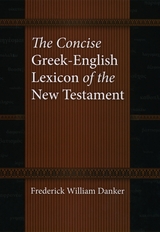 The Concise Greek-English Lexicon of the New Testament
Frederick William Danker
University of Chicago Press, 2009 Frederick William Danker, a world-renowned scholar of New Testament Greek, is widely acclaimed for his 2000 revision of Walter Bauer’s A Greek-English Lexicon of the New Testament and Other Early Christian Literature. With more than a quarter of a million copies in print, it is considered the finest dictionary of its kind. Danker’s Concise Greek-English Lexicon of the New Testament will prove to be similarly invaluable to ministers, seminarians, translators, and students of biblical Greek. Unlike other lexica of the Greek New Testament, which give only brief glosses for headwords, The Concise Greek-English Lexicon offers extended definitions or explanations in idiomatic English for all Greek terms. Each entry includes basic etymological information, short renderings, information on usage, and plentiful biblical references. Greek terms that could have different English definitions, depending on context, are thoughtfully keyed to the appropriate passages. An overarching aim of The Concise Greek-English Lexicon is to assist the reader in recognizing the broad linguistic and cultural context for New Testament usage of words. The Concise Greek-English Lexicon retains all the acclaimed features of A Greek-English Lexicon in a succinct and affordable handbook, perfect for specialists and nonspecialists alike.
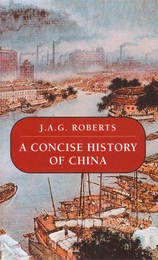 A Concise History of China
J. A. G. Roberts
Harvard University Press, 1999 The centuries-long complexity of China's political experience, the richness of its culture, and the drama of its economic unfolding are the hallmarks of this short but sweeping history. China's own history is entwined with its response to the West in a rich tapestry depicting its peoples, rulers, and society. More than a nuanced history of a vast continent, this study is sensitive to the multifaceted and changing interpretations of China that have been offered over the years.
In this overarching book, J. A. G. Roberts refers to recent archeological finds--the caches of bronze vessels found at Sanxingdui--and to new documentary reevaluations--the reassessment of Manchu documentation. The first half of the book provides an up-to-date interpretation of China's early and imperial history, while the second half concentrates on the modern period and provides an interpretive account of major developments--the impact of Western imperialism, the rise of Chinese Communism, and the record of the People's Republic of China since 1949.
Concise and direct, this book is a compelling narrative and handy companion for those interested in China.
 A Concise History of Sunnis and Shi'is
John McHugo
Georgetown University Press, 2019 The 1,400-year-old schism between Sunnis and Shi’is is currently reflected in the destructive struggle for hegemony between Saudi Arabia and Iran—with no apparent end in sight. But how did this conflict begin, and why is it now the focus of so much attention? Charting the history of Islam from the death of the Prophet Muhammad to the present day, John McHugo describes the conflicts that raged over the succession to the Prophet, how Sunnism and Shi’ism evolved as different sects during the Abbasid caliphate, and how the rivalry between the Sunni Ottomans and Shi’i Safavids ensured that the split would continue into the modern age. In recent decades, this centuries-old divide has acquired a new toxicity that has resulted in violence across the Arab world and other Muslim countries. Definitive, insightful, and accessible, A Concise History of Sunnis and Shi'is is an essential guide to understanding the genesis, development, and manipulation of the schism that for far too many people has come to define Islam and the Muslim world.
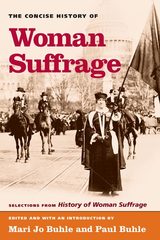 The Concise History of Woman Suffrage: Selections from History of Woman Suffrage, by Elizabeth Cady Stanton, Susan B. Anthony, Matilda Joslyn Gage, and the National American Woman Suffrage Association
Edited and with an Introduction by Mari Jo Buhle and Paul Buhle
University of Illinois Press, 2005 The massive size of the original six-volume History of Woman Suffrage has likely limited its impact on the lives of the women who benefitted from the efforts of the pioneering suffragists. By collecting miscellanies like state suffrage reports and speeches of every sort without interpretation or restraint, the set was often neglected as impenetrable.
In their Concise History of Woman Suffrage, Mari Jo Buhle and Paul Buhle have revitalized this classic text by carefully selecting from among its best material. The eighty-two chosen documents, now including interpretative introductory material by the editors, give researchers easy access to material that the original work's arrangement often caused readers to ignore or to overlook.
The volume contains the work of many reform agitators, among them Angelina Grimké, Lucy Stone, Carrie Chapman Catt, Charlotte Perkins Gilman, Anna Howard Shaw, Jane Addams, Sojourner Truth, and Victoria Woodhull, as well as Elizabeth Cady Stanton, Susan B. Anthony, Matilda Joslyn Gage, and Ida Husted Harper.
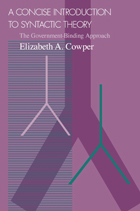 A Concise Introduction to Syntactic Theory: The Government-Binding Approach
Elizabeth A. Cowper
University of Chicago Press, 1992 This textbook is intended to give students a quick start in using theory to address syntactic questions. At each stage, Cowper is careful to introduce a theoretical apparatus that is no more complex than is required to deal with the phenomenon under consideration. Comprehensive and up-to-date, this accessible volume will also provide an excellent refresher for linguists returning to the study of Government-Binding theory.
"Cowper exhibits the analytical devices of current principles-and-parameters approaches, takes readers carefully through the central elements of grammatical theory (including very recent work), and ushers them selectively into the technical literature. . . . A serious introduction for those who want to know the nuts and bolts of syntactic theory and to see why linguists are so excited these days."—David Lightfoot, University of Maryland
"An excellent short introduction to the Government and Binding model of syntactic theory. . . . Cowper's work succeeds in teaching syntactic argumentation and in showing the conceptual reasons behind specific proposals in modern syntactic theory."—Jaklin Kornfilt, Syracuse University
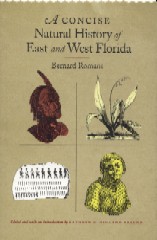 A Concise Natural History of East and West Florida
Bernard Romans, edited and with an introduction by Kathryn E. Holland Braund
University of Alabama Press, 2013 Braund presents the only annotated edition of Bernard Romans's rare and valuable 18th-century account of his observations in the southeastern United States.
Bernard Romans's A Concise Natural History of East and West Florida, William Bartram's Travels, and James Adair's History of the American Indian are the three most significant accounts of the southeastern United States published during the late 18th century. This new edition of Romans's Concise Natural History, edited by historian Kathryn Braund, provides the first fully annotated edition of this early and rare description of both the European settled areas and the adjoining Indian lands in what are now the states of Florida, Georgia, Alabama, Mississippi, and Louisiana.
Romans's purpose in producing his Concise Natural History was twofold: to aid navigators and shippers by detailing the sailing passages of the region and to promote trade and settlement in the region. To those ends, he provided detailed scientific observations on the natural history of the area, a summary of the region's political history, and an assessment of the potential for economic growth in the Floridas based on the area's natural resources.
A trained surveyor and cartographer and a self-taught naturalist, Romans supplied detailed descriptions of the region's topography and environment, including information about the climate and weather patterns, plants, animals, and diseases. He provided information about the state of scientific inquiry in the South and touched on many of the most important intellectual arguments of the day, such as the origin of the races, the practice of slavery, and the benefits and drawbacks of monopoly on trade.
In addition, Concise Natural History can be placed firmly in the genre of colonial promotional literature. Romans's book was an enthusiastic guide aimed at those seeking to establish modest holdings in the region:
"What a field is open here! . . . No country ever had such inexhaustible resources; no empire had ever half so many advantages combining in its behalf!" Romans explained how settlers should travel to the area, what they would need in terms of provisions and tools, and what it would cost to have their land surveyed. In addition to providing an abundance of practical advice, Romans also offered information about the history of earlier settlements, including the earliest and most complete account of New Smyrna near St. Augustine.
Romans also presented unique information about the various Indian tribes he encountered. In fact, historians agree that among the most useful portions of the book are Romans's descriptions of the largest Indian tribes in the 18th-century Southeast: the Creeks, Choctaws, and Chickasaws. Romans's account of the diet of the Creeks and Choctaws is one of the most complete available. And his description of the location of Choctaw village sites is one of the best sources for this information.
Concluding
Henry Green
University of Chicago Press, 1985 Concluding is probably the most lyrical novel by a writer whom Rebecca West has called "the most original" of his time. "Within the compass of a summer's day for all time yet intensely and closely centered upon a particular time and place, we are made aware of man's predicament in a world of transcendent sadness and beauty."—Horizon
"[A] novel of projections, protractions, long shots, and shadows flying ahead, a slow fall. . . . The sinister world of Concluding is . . . beautiful, side-lit and colored like an undersea kingdom."—from the Foreword by Eudora Welty
 Concord River: Selections from the Journals of William Brewster
William Brewster
Harvard University Press William Brewster, one of the greatest American ornithologists, was fortunate in being able to spend his life in the study of birds. On his large estate in Cambridge, he maintained a bird sanctuary and museum. When still a young man, he bought a large tract of land in Concord, Massachusetts, to which he added from time to time until the place finally included some four hundred acres. To it he gave the name “October Farm.” There he spent days and weeks observing the birds and animals about him with trained eye and sympathetic delight. Almost every day he jotted down his observations in a series of diaries which he bequeathed to Harvard University, along with his bird collections, on his death in 1919. From these journals his old friend Rev. Smith O. Dexter made a number of selections, part of which we published last autumn with the title October Farm. The great success of that volume has encouraged us to issue this autumn the remainder of Mr. Dexter’s selections; for this volume we have chosen the title Concord River. Another friend of Brewster’s, the well-known artist Frank W. Benson, has contributed twelve bird studies as illustrations. Three of these are in color, eight are black and white water colors, and one is an etching. Since very few of Mr. Benson’s bird sketches have ever been reproduced in books, these illustrations form a noteworthy addition to Brewster’s own material. The volume will appeal at once to everyone interested in birds, in the lovely old town of Concord, or in choice English prose. It will, like October Farm, be considered a classic, worthy to stand beside Thoreau, Muir, and Hudson.
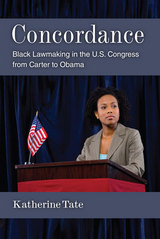 Concordance: Black Lawmaking in the U.S. Congress from Carter to Obama
Katherine Tate
University of Michigan Press, 2014 During the height of the civil rights movement, Blacks were among the most liberal Americans. Since the 1970s, however, increasing representation in national, state, and local government has brought about a more centrist outlook among Black political leaders. Focusing on the Congressional Black Caucus (CBC), Katherine Tate studies the ways in which the nation’s most prominent group of Black legislators has developed politically. Organized in 1971, the CBC set out to increase the influence of Black legislators. Indeed, over the past four decades, they have made progress toward the goal of becoming recognized players within Congress. And yet, Tate argues, their incorporation is transforming their policy preferences. Since the Clinton Administration, CBC members—the majority of whom are Democrats—have been less willing to oppose openly congressional party leaders and both Republican and Democratic presidents. Tate documents this transformation with a statistical analysis of Black roll-call votes, using the important Poole-Rosenthal scores from 1977 to 2010. While growing partisanship has affected Congress as a whole, not just minority caucuses, Tate warns that incorporation may mute the independent voice of Black political leaders.
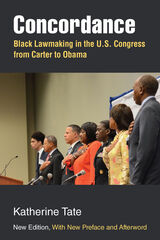 Concordance: Black Lawmaking in the U.S. Congress from Carter to Obama
Katherine Tate
University of Michigan Press, 2020 During the height of the civil rights movement, Blacks were among the most liberal Americans. Since the 1970s, however, increasing representation in national, state, and local government has brought about a more centrist outlook among Black political leaders. Focusing on the Congressional Black Caucus (CBC), Katherine Tate studies the ways in which the nation’s most prominent group of Black legislators has developed politically. Organized in 1971, the CBC set out to increase the influence of Black legislators. Indeed, over the past four decades, they have made progress toward the goal of becoming recognized players within Congress. And yet, Tate argues, their incorporation is transforming their policy preferences. Since the Clinton Administration, CBC members—the majority of whom are Democrats—have been less willing to oppose openly congressional party leaders and both Republican and Democratic presidents. Tate documents this transformation with a statistical analysis of Black roll-call votes, using the important Poole-Rosenthal scores from 1977 to 2010. While growing partisanship has affected Congress as a whole, not just minority caucuses, Tate warns that incorporation may mute the independent voice of Black political leaders.
 A Concordance to Finnegans Wake
Clive Hart
University of Minnesota Press, 1963 A Concordance to Finnegans Wake was first published in 1963. Minnesota Archive Editions uses digital technology to make long-unavailable books once again accessible, and are published unaltered from the original University of Minnesota Press editions. This concordance, the first full-scale work dealing with the language of James Joyce's last period, provides a finding-list and analytical index for his last work, Finnegans Wake. There are three parts: the first consisting of a complete alphabetical index to the vocabulary of Finnegans Wake,the second comprising a list of syllabifications (showing the inner parts of compound words), and the third providing a list of some 10,000 English words suggested by Joycean distortions. The primary word-index, similar in most respects to those which have already been published for Joyce's Ulysses and Stephen Hero, list in alphabetical order all of the 63,924 different words which make up the vocabulary of Finnegans Wake and provides page-line references for every occurrence of all but a small handful of the most common English words. Except for punctuation marks, every typographical unit in the book is accounted for, and each is listed just as it appears in the text. The second on syllabification lists in alphabetical order the inner parts of over 10,000 complex words in Finnegans Wake which are built up out of simpler elements and which would be impossible to find from the primary index alone. In the last section, called "Overtones," the aim is to list the English words suggested by Joyce's puns and distortions. Much information gleaned from the Joycean research of the past decade is gathered together here.
A Concordance to Livy: Vol I: A–D; Vol. II: E–I; Vol III: K–P; Vol. IV: Q–Z
David W. Packard
Harvard University Press This concordance to the complete extant works of Livy was compiled at the Harvard Computing Center and contains approximately 500,000 entries. The Oxford Text was used for Books I–XXXV, the Teubner for XXXVI–XLV. All words, including el, have been catalogued, and each word is accompanied by about twenty words of its context. Words are alphabetized in the form in which they occur in the text without being organized under normalized dictionary headings; repeated instances of the same word are arranged according to the words that follow in the context, thereby producing an index of phrases as well as words. The concordance was set in type by computerized photocomposition.
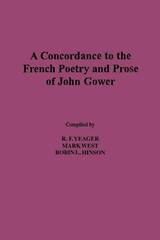 Concordance to the French Poetry and Prose of John Gower
R. F. Yeager
Michigan State University Press, 1997 That the poet John Gower was a major literary figure in England at the close of the fourteenth century is no longer in question. Scholarly attention paid to him and to his work over the past twenty- five years has redeemed him from an undeserved obscurity imposed by the preceding two hundred. The facts of his life and career are now documented, and recent critical assessment has placed his achievement most accurately alongside Chaucer's, Langland's, and the Gawain- poet's.
Unique among his contemporaries, all of whom undoubtedly read and used French in some measure, Gower alone has left us a significant body of verse and prose in Anglo-Norman; chiefly, the twelve-stanza poem Mirour de l-Omme, the Cinkante Balades, and the Traitié pour les amantz marietz. We are offered in this concordance of his Anglo- Norman work a unique opportunity to view a poetic language as it was written and read in England until Gower's death in 1408 and beyond.
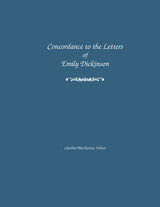 Concordance to the Letters of Emily Dickinson
Cynthia MacKenzie
University Press of Colorado, 2000 This valuable resource for Dickinson scholars is based on the Thomas H. Johnson three-volume edition of the letters (published in 1958 and 1965) as well as the 1998 one-volume paperback edition. The primary importance of the concordance pertains to the poetic quality of the letters themselves. As editor of both the poems and the letters, T.H. Johnson recognizes this link when he writes: "the letters both in style and rhythm begin to take on qualities that are so nearly the quality of her poems as on occasion to leave the reader in doubt where the letter leaves off and the poem begins." The similarities between the letters and the poems makes the typical concordance search for the poet's thematically significant words and biographical references particularly relevant. Tracing Dickinson's thoughts through her correspondence complements the ideas within her poetry and thus provides a more comprehensive insight into the poet's personal and artistic development. The concordance will facilitate an understanding of words or concepts that may be obscure in the poetry by itself. Research into Dickinson's problematic style, characterized by gaps, disjunctions, and ellipses, will be greatly enhanced. By listing Dickinson's words together with their contexts and frequencies, the concordance provides the scholar with the ability to answer confidently questions of a statistical or stylistic nature. Finally, one of the most important functions of this concordance is to provide scholar, student, and general reader alike with endless opportunities to make exciting and unexpected discoveries by way of browsing.
Concordia Discors: Eros and Dialogue in Classical Athenian Literature
Andrew Scholtz
Harvard University Press, 2007 Writing to a friend, Horace describes the man as fascinated by "the discordant harmony of the cosmos, its purpose and power." Andrew Scholtz takes this notion of "discordant harmony" and argues for it as an aesthetic principle where classical Athenian literature addresses politics in the idiom of sexual desire. His approach is an untried one for this kind of topic. Drawing on theorists of the sociality of language, Scholtz shows how eros, consuming, destabilizing desire, became a vehicle for exploring and exploiting dissonance within the songs Athenians sang about themselves. Thus he shows how societal tension and instability could register as an ideologically charged polyphony in works like the Periclean Funeral Oration, Aristophanes' Knights, and Xenophon's Symposium.
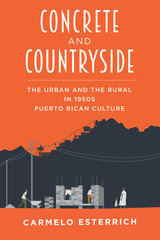 Concrete and Countryside: The Urban and the Rural in 1950s Puerto Rican Culture
Carmelo Esterrich
University of Pittsburgh Press, 2018 From the late 1940s to the early 1960s, Puerto Rico was swept by a wave of modernization, transforming the island from a predominantly rural society to an unquestionably urban one. A curious paradox ensued, however. While the island underwent rapid urbanization, and the rhetoric of economic development reigned over official discourses, the newly installed insular government, along with some academic circles and radio and television media, constructed, promoted, and sponsored a narrative of Puerto Rican culture based on rural subjects, practices, and spaces.
By examining a wide range of cultural texts, but focusing on the film production of the Division of Community Education, the popular dance music of Cortijo y su combo, and the literary texts of Jose Luis Gonzalez and Rene Marques, Concrete and Countryside offers an in-depth analysis of how Puerto Ricans responded to this transformative period. It also shows how the arts used a battery of images of the urban and the rural to understand, negotiate, and critique the innumerable changes taking place on the island.
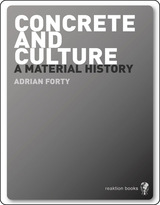 Concrete and Culture: A Material History
Adrian Forty
Reaktion Books, 2012 Concrete has been used in arches, vaults, and domes dating as far back as the Roman Empire. Today, it is everywhere—in our roads, bridges, sidewalks, walls, and architecture. For each person on the planet, nearly three tons of concrete are produced every year. Used almost universally in modern construction, concrete has become a polarizing material that provokes intense loathing in some and fervent passion in others.
Focusing on concrete’s effects on culture rather than its technical properties, Concrete and Culture examines the ways concrete has changed our understanding of nature, of time, and even of material. Adrian Forty concentrates not only on architects’ responses to concrete, but also takes into account the role concrete has played in politics, literature, cinema, labor-relations, and arguments about sustainability. Covering Europe, North and South America, and the Far East, Forty examines the degree that concrete has been responsible for modernist uniformity and the debates engendered by it. The first book to reflect on the global consequences of concrete, Concrete and Culture offers a new way to look at our environment over the past century.
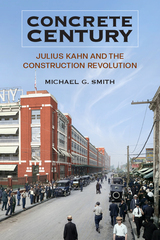 Concrete Century: Julius Kahn and the Construction Revolution
Michael G. Smith
University of Michigan Press, 2024 At the turn of the 20th century, industrial manufacturing was expanding dramatically while factory buildings remained fire-prone relics of an earlier age. That is, until a 28-year-old civil engineer finally achieved what engineers around the world had unsuccessfully attempted. Working in his brother’s basement in Detroit, Julius Kahn invented the first practical and scientific method of reinforcing concrete with steel bars, which finally made it possible to construct strong, fireproof buildings. After Kahn founded a company in 1903 to manufacture and sell his reinforcement bars, his system of construction became the most widely used throughout the world.
Drawing upon Kahn’s personal correspondence, architectural drawings, company records, and contemporary news and journal articles, Michael G. Smith reveals how this man—whose family had immigrated to the US to escape antisemitism in Germany—played an important role in the rise of concrete. Concrete not only turned the tide against widespread destruction of buildings by fire, it also paved the way for our modern economy. Concrete Century will delight readers intrigued by architecture and construction technology alike with the true origin story of modern concrete buildings.
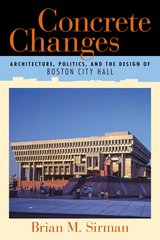 Concrete Changes: Architecture, Politics, and the Design of Boston City Hall
Brian M. Sirman
University of Massachusetts Press, 2018 From the 1950s to the end of the twentieth century, Boston transformed from a city in freefall into a thriving metropolis, as modern glass skyscrapers sprouted up in the midst of iconic brick rowhouses. After decades of corruption and graft, a new generation of politicians swept into office, seeking to revitalize Boston through large-scale urban renewal projects. The most important of these was a new city hall, which they hoped would project a bold vision of civic participation. The massive Brutalist building that was unveiled in 1962 stands apart—emblematic of the city's rebirth through avant-garde design.
And yet Boston City Hall frequently ranks among the country's ugliest buildings. Concrete Changes seeks to answer a common question for contemporary viewers: How did this happen? In a lively narrative filled with big personalities and newspaper accounts, Brian M. Sirman argues that this structure is more than a symbol of Boston's modernization; it acted as a catalyst for political, social, and economic change.
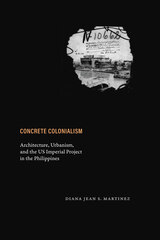 Concrete Colonialism: Architecture, Urbanism, and the US Imperial Project in the Philippines
Diana Jean S. Martinez
Duke University Press, 2025 During US colonial rule in the Philippines, reinforced concrete was used to the near exclusion of all other building materials. In Concrete Colonialism, Diana Jean S. Martinez examines the motivations for and lasting effects of this forgotten colonial policy. Arguing that the pervasive use of reinforced concrete technologies revolutionized techniques of imperial conquest, Martinez shows how concrete reshaped colonialism as a project that sought durable change through the reformation of environments, colonial society, and racialized biologies. Martinez locates the origins of this material revolution in the development of Chicago, highlighting how building this urban center atop exceptionally challenging geology made it possible to transform diverse global ecologies. She details how the material’s stability, plasticity, strength, and other qualities served the shifting imperatives of the US colonial regime, playing a central role in defending territory, controlling disease, and constructing monuments to nation and empire. By describing a world irreversibly remade, Martinez urges readers to consider how colonialism persists—in concrete forms—despite claims of its conclusion.
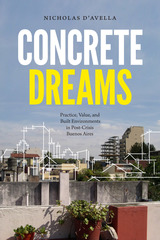 Concrete Dreams: Practice, Value, and Built Environments in Post-Crisis Buenos Aires
Nicholas D'Avella
Duke University Press, 2019 In Concrete Dreams Nicholas D’Avella examines the changing social and economic lives of buildings in the context of a construction boom following Argentina's political and economic crisis of 2001. D’Avella tells the stories of small-scale investors who turned to real estate as an alternative to a financial system they no longer trusted, of architects who struggled to maintain artistic values and political commitments in the face of the ongoing commodification of their work, and of residents-turned-activists who worked to protect their neighborhoods and city from being overtaken by new development. Such forms of everyday engagement with buildings, he argues, produce divergent forms of value that persist in tension with hegemonic forms of value. In the dreams attached to built environments and the material forms in which those dreams are articulated—from charts and graphs to architectural drawings, urban planning codes, and tango lyrics—D’Avella finds a blueprint for building livable futures in which people can survive alongside and even push back against the hegemony of capitalism.
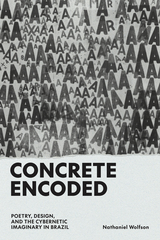 Concrete Encoded: Poetry, Design, and the Cybernetic Imaginary in Brazil
Nathaniel Wolfson
University of Texas Press, 2025 A study of concrete art and poetry, its implications, and influence in Brazil. Concrete art and poetry burst onto Brazil’s cultural stage in the 1950s, while the country was embarking on a dizzying period of modernization. Bringing together key poets and visual artists alongside less recognized figures, Nathaniel Wolfson shows that concretism was hardly socially inert, as pundits have suggested. Rather, it presciently grappled with an emerging information age that would soon reorganize human relations globally. Concrete Encoded describes a nascent cybernetic imaginary. Concretism has long been considered Brazil’s most global aesthetic movement. Wolfson traces new circles of international theorists and practitioners involved in critical technological thought. Wolfson argues that concrete poetry is the quintessential literary genre of the early information age. He shows that Brazilian poets, artists, and designers contested the military dictatorship’s technological authoritarianism and information-gathering operations. Vigorous experimentalists, their attention to form and semantics unveiled both the creative and nefarious possibilities of algorithmic writing. A highly original work, Concrete Encoded reckons with aesthetic responses from Brazil to an advancing capitalist and digital era.
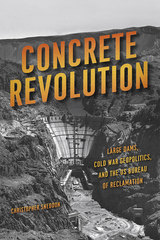 Concrete Revolution: Large Dams, Cold War Geopolitics, and the US Bureau of Reclamation
Christopher Sneddon
University of Chicago Press, 2015 Water may seem innocuous, but as a universal necessity, it inevitably intersects with politics when it comes to acquisition, control, and associated technologies. While we know a great deal about the socioecological costs and benefits of modern dams, we know far less about their political origins and ramifications. In Concrete Revolution, Christopher Sneddon offers a corrective: a compelling historical account of the US Bureau of Reclamation’s contributions to dam technology, Cold War politics, and the social and environmental adversity perpetuated by the US government in its pursuit of economic growth and geopolitical power.
Founded in 1902, the Bureau became enmeshed in the US State Department’s push for geopolitical power following World War II, a response to the Soviet Union’s increasing global sway. By offering technical and water resource management advice to the world’s underdeveloped regions, the Bureau found that it could not only provide them with economic assistance and the United States with investment opportunities, but also forge alliances and shore up a country’s global standing in the face of burgeoning communist influence. Drawing on a number of international case studies—from the Bureau’s early forays into overseas development and the launch of its Foreign Activities Office in 1950 to the Blue Nile investigation in Ethiopia—Concrete Revolution offers insights into this historic damming boom, with vital implications for the present. If, Sneddon argues, we can understand dams as both technical and political objects rather than instruments of impartial science, we can better participate in current debates about large dams and river basin planning.
The Concrete River: Poems
Luis J. Rodríguez
Northwestern University Press, 1995 1991 PEN Oakland/Josephine Miles Award for Literary Excellence
The Concrete River is a collection of poems by poet laureate of Los Angeles Luis Rodríguez. They illuminate the gritty idiosyncrasies of immigrant life in urban barrios spanning Los Angeles to Chicago to Harlem. Rodríguez lends powerful voices to those struggling to keep the gas on, to find work, and to keep love. Populated by a vibrant cast of characters, ranging from the drugged, to the eccentric, to the heartbroken, Rodríguez’s poems protest capitalism, violence, and exploitation while reveling in the potential of compassion.
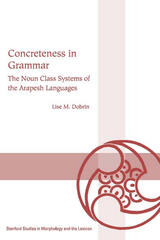 Concreteness in Grammar
Lise Dobrin
CSLI, 2013 Based on an exhaustive search of published sources and the author’s firsthand fieldwork, Concreteness in Grammar explores the role of phonological form in the noun class systems of the Arapesh languages spoken in Papua New Guinea. Linguists have long known that formal critical play a role alongside semantics in the classification of lexical terms. In Arapesh, virtually every possible final ending of a noun is represented in the paradigm of noun class and agreement markers, reflecting an interpenetraion of sound structure and grammar that many theories would disallow as wildly unconstrained. In this book, Lise Dobrin describes these formal patterns in order to reveal their naturalness and elegance, establishing their place in a typology of noun class systems and drawing out their significance for theories of grammatical architecture. A rigorous study of an endangered language, Concreteness in Grammar revisits the definition of a morpheme and looks at unusual language patterns to reveal the naturalness of grammar.
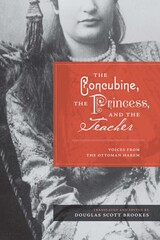 The Concubine, the Princess, and the Teacher: Voices from the Ottoman Harem
Translated and edited by Douglas Scott Brookes
University of Texas Press, 2008 In the Western imagination, the Middle Eastern harem was a place of sex, debauchery, slavery, miscegenation, power, riches, and sheer abandon. But for the women and children who actually inhabited this realm of the imperial palace, the reality was vastly different. In this collection of translated memoirs, three women who lived in the Ottoman imperial harem in Istanbul between 1876 and 1924 offer a fascinating glimpse "behind the veil" into the lives of Muslim palace women of the late nineteenth and early twentieth centuries. The memoirists are Filizten, concubine to Sultan Murad V; Princess Ayse, daughter of Sultan Abdulhamid II; and Safiye, a schoolteacher who instructed the grandchildren and harem ladies of Sultan Mehmed V. Their recollections of the Ottoman harem reveal the rigid protocol and hierarchy that governed the lives of the imperial family and concubines, as well as the hundreds of slave women and black eunuchs in service to them. The memoirists show that, far from being a place of debauchery, the harem was a family home in which polite and refined behavior prevailed. Douglas Brookes explains the social structure of the nineteenth-century Ottoman palace harem in his introduction. These three memoirs, written across a half century and by women of differing social classes, offer a fuller and richer portrait of the Ottoman imperial harem than has ever before been available in English.
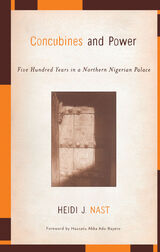 Concubines And Power: Five Hundred Years In A Northern Nigerian Palace
Heidi J. Nast
University of Minnesota Press, 2004 African Studies Association Women’s Caucus’s Aidoo-Snyder Book Prize winner A Choice Outstanding Academic Title The monumental palace of Kano, Nigeria, was built circa 1500 and is today inhabited by more than one thousand persons. Historically, its secluded interior housed hundreds of concubines whose role in the politics, economics, and culture of Kano city-state has been largely overlooked. In this pioneering work, Heidi J. Nast demonstrates how human-geographical methods can tell us much about a site like the palace, a place bereft of archaeological work or relevant primary sources. Drawing on extensive ethnographic work and mapping data, Concubines and Power presents new evidence that palace concubines controlled the production of indigo-dyed cloth centuries before men did. The women were also key players in the assessment and collection of the state's earliest grain taxes, forming a complex and powerful administrative hierarchy that used the taxes for palace community needs. In addition, royal concubines served as representatives of their places of origin, their freeborn children providing the king with additional human capital to cement territorial alliances through marriage. Social forces undoubtedly shaped and changed concubinage for hundreds of years, but Nast shows how the women’s reach extended far beyond the palace walls to the formation of the state itself.
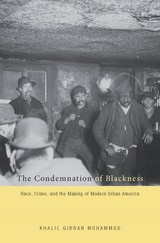 The Condemnation of Blackness: Race, Crime, and the Making of Modern Urban America
Khalil Gibran Muhammad
Harvard University Press, 2010 Winner of the John Hope Franklin Prize
A Moyers & Company Best Book of the Year
“[A] brilliant work that tells us how directly the past has formed us.”
—Darryl Pinckney, New York Review of Books
Lynch mobs, chain gangs, and popular views of black southern criminals that defined the Jim Crow South are well known. We know less about the role of the urban North in shaping views of race and crime in American society.
Following the 1890 census, the first to measure the generation of African Americans born after slavery, crime statistics, new migration and immigration trends, and symbolic references to America as the promised land of opportunity were woven into a cautionary tale about the exceptional threat black people posed to modern urban society. Excessive arrest rates and overrepresentation in northern prisons were seen by many whites—liberals and conservatives, northerners and southerners—as indisputable proof of blacks’ inferiority. In the heyday of “separate but equal,” what else but pathology could explain black failure in the “land of opportunity”?
The idea of black criminality was crucial to the making of modern urban America, as were African Americans’ own ideas about race and crime. Chronicling the emergence of deeply embedded notions of black people as a dangerous race of criminals by explicit contrast to working-class whites and European immigrants, Khalil Gibran Muhammad reveals the influence such ideas have had on urban development and social policies.
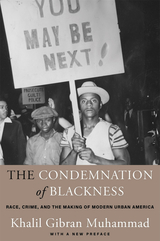 The Condemnation of Blackness: Race, Crime, and the Making of Modern Urban America, With a New Preface
Khalil Gibran Muhammad
Harvard University Press, 2019 Winner of the John Hope Franklin Prize
A Moyers & Company Best Book of the Year
“A brilliant work that tells us how directly the past has formed us.”
—Darryl Pinckney, New York Review of Books
How did we come to think of race as synonymous with crime? A brilliant and deeply disturbing biography of the idea of black criminality in the making of modern urban America, The Condemnation of Blackness reveals the influence this pernicious myth, rooted in crime statistics, has had on our society and our sense of self. Black crime statistics have shaped debates about everything from public education to policing to presidential elections, fueling racism and justifying inequality. How was this statistical link between blackness and criminality initially forged? Why was the same link not made for whites? In the age of Black Lives Matter and Donald Trump, under the shadow of Ferguson and Baltimore, no questions could be more urgent.
“The role of social-science research in creating the myth of black criminality is the focus of this seminal work…[It] shows how progressive reformers, academics, and policy-makers subscribed to a ‘statistical discourse’ about black crime…one that shifted blame onto black people for their disproportionate incarceration and continues to sustain gross racial disparities in American law enforcement and criminal justice.”
—Elizabeth Hinton, The Nation
“Muhammad identifies two different responses to crime among African-Americans in the post–Civil War years, both of which are still with us: in the South, there was vigilantism; in the North, there was an increased police presence. This was not the case when it came to white European-immigrant groups that were also being demonized for supposedly containing large criminal elements.”
—New Yorker
A Condensed Collection of Thermodynamic Formulas
Percy Williams Bridgman
Harvard University Press The thermodynamic formulas most often used in theoretical and practical work state various relations between first and second derivatives of various thermodynamic functions. There are a very large number indeed of such relations, and the discovery of the one needed in any particular problem usually takes considerable time, especially if one is not working continually in the field. In this collection of formulas, means have been found for condensing into very small space all the possible relations of this character. A number of problems are worked in detail, illustrating various uses of the formulas, and methods are described of extending the formulas to systems exposed to more general external forces than the conventional hydrostatic pressure.
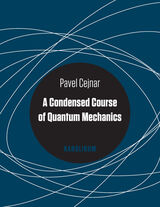 A Condensed Course of Quantum Mechanics
Pavel Cejnar
Karolinum Press, 2014 This book represents a concise summary of nonrelativistic quantum mechanics for physics students at the university level. The text covers essential topics, from general mathematical formalism to specific applications. The formulation of quantum theory is explained and supported with illustrations of the general concepts of elementary quantum systems. In addition to traditional topics of nonrelativistic quantum mechanics—including single-particle dynamics, symmetries, semiclassical and perturbative approximations, density-matrix formalism, scattering theory, and the theory of angular momentum—the book also covers modern issues, among them quantum entanglement, decoherence, measurement, nonlocality, and quantum information. Historical context and chronology of basic achievements is also outlined in explanatory notes. Ideal as a supplement to classroom lectures, the book can also serve as a compact and comprehensible refresher of elementary quantum theory for more advanced students.
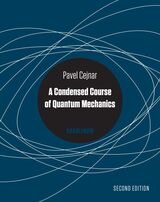 A Condensed Course of Quantum Mechanics, Second Edition
Pavel Cejnar
Karolinum Press, 2025 A new edition of a foundational overview of quantum mechanics.
This book presents a concise summary of nonrelativistic quantum mechanics for physics students at the university level. The text covers essential topics, from general mathematical formalism to specific applications. The formulation of quantum theory is explained and supported with illustrations of the general concepts of elementary quantum systems. In addition to traditional topics of nonrelativistic quantum mechanics—including single-particle dynamics, symmetries, semiclassical and perturbative approximations, density-matrix formalism, scattering theory, and the theory of angular momentum—the book also covers modern issues, among them quantum entanglement, decoherence, measurement, nonlocality, and quantum information. The historical context and chronology of basic achievements are also outlined in explanatory notes.
Ideal as a supplement to classroom lectures, A Condensed Course of Quantum Mechanics will also serve as a compact and comprehensible refresher of elementary quantum theory for more advanced students.
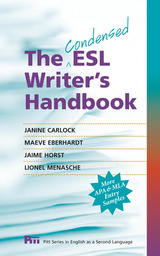 The Condensed ESL Writer's Handbook
Janine Carlock, Maeve Eberhardt, Jaime Horst, Lionel Menasche
University of Michigan Press, 2013
The CondensedESL Writer’s Handbook is a reference work for ESL students who are taking college-level courses. Because its purpose is to provide help with the broad variety of writing questions students may have when working on school assignments, the text focuses on English for Academic Purposes. Unlike other handbooks on the market, this book’s sole purpose is to address the issues of primary importance to language learners.
The Condensed Handbook complements a student writer’s dictionary, thesaurus, and grammar reference book. It would be suitable as a text for an advanced ESL writing course.
The Condensed Handbook is concise and easily navigated; is accessible, with clear and direct explanatory language; and limits its focus to the grammatical and style aspects of writing and reference material.
Included as special features in the Condensed Handbook are:
• The explanatory language is appropriate for ESL students, in contrast to the more complex and idiomatic language of other English handbooks.
• The level of detail is more manageable for ESL students, compared to what is in other English handbooks.
• Many of the examples of paragraphs and exercise sentences were written by ESL students; this encourages users of this Handbook to realize that they too can also become effective writers.
• Additional samples of MLA and APA reference entries.
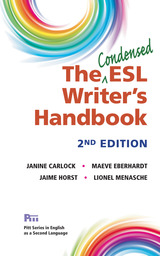 The Condensed ESL Writer's Handbook, 2nd Ed.
Janine Carlock, Maeve Eberhardt, Jaime Horst, and Lionel Menasche
University of Michigan Press, 2018 The Condensed ESL Writer’s Handbook is a spiral-bound reference work for ESL students who are taking college-level courses. Because its purpose is to provide help with the broad variety of writing questions students may have when working on school assignments, the text focuses on English for Academic Purposes. The Condensed version is concise and easily navigated; is accessible with clear and direct explanatory language; and limits its focus to the grammatical and style aspects of writing and reference material. The 2nd Edition of The Condensed ESL Writer’s Handbook has been revised to better align with the exercises in Workbook for The ESL Writer’s Handbook, 2nd Ed.(978-0-472-03726-1). It also features an expanded Section 1 (to include more on pre-writing, drafting, revising, and editing), updated exercise items, and completely revised APA and MLA style guides (featuring MLA, 8th Edition). Overall, this handbook has these special features: - The topic selection is based on ESL writers’ needs as observed by the authors over many years.
- The coverage of topics is more complete than the limited amount usually provided for ESL writers in first language or L1 handbooks.
- The explanatory language is appropriate for ESL students, in contrast to the more complex and idiomatic language of other English handbooks.
- Many of the text examples and exercise sentences were written by ESL students to help users realize that they too can become effective writers.
 Condition Assessment of High Voltage Insulation in Power System Equipment
R.E. James
The Institution of Engineering and Technology, 2008 The book introduces the reader to the major components of a high voltage system and the different insulating materials applied in particular equipments. During a review of these materials, measurable properties suitable for condition assessment are identified. Analyses are included of some of the insulation fault scenarios that may occur in power equipment. The basic facilities for carrying out tests on the internal and external insulation structures at high and low voltages are described. Tests and measurements according to specifications, on-site requirements and research investigations are considered. Advances in the application of digital techniques for detection and analyses of partial discharges are discussed and methods in use, or under development, for service condition monitoring are described. These include the utilization of new sensors, the solution of online problems associated with noise rejection and the adaptation of artificial intelligence techniques for incipient fault diagnosis.
Condition Monitoring of Rotating Electrical Machines
Peter Tavner
The Institution of Engineering and Technology, 2008 Condition monitoring of engineering plant has increased in importance as engineering processes are automated and manpower is reduced. However, electrical machinery receives attention only at infrequent intervals when plant is shut down and the application of protective relays to machines has also reduced operator surveillance.
Condition Monitoring of Rotating Electrical Machines
Peter Tavner
The Institution of Engineering and Technology, 2020 Condition monitoring of engineering plants has increased in importance as engineering processes have become increasingly automated. However, electrical machinery usually receives attention only at infrequent intervals when the plant or the electricity generator is shut down. The economics of industry have been changing, placing ever more emphasis on the importance of reliable operation of the plants. Electronics and software in instrumentation, computers, and digital signal processors have improved our ability to analyse machinery online. Condition monitoring is now being applied to a range of systems from fault-tolerant drives of a few hundred watts to machinery of a few hundred MW in major plants.
 The Condition of Digitality: A Post-Modern Marxism for the Practice of Digital Life
Robert Hassan
University of Westminster Press, 2020 David Harvey’s The Condition of Postmodernity rationalised capitalism’s transformation during an extraordinary year: 1989. It gave theoretical expression to a material and cultural reality that was just then getting properly started – globalisation and postmodernity – whilst highlighting the geo-spatial limits to accumulation imposed by our planet. However this landmark publication, author Robert Hassan argues, did not address the arrival of digital technology, the quantum leap represented by the move from an analogue world to a digital economy and the rapid creation of a global networked society. Considering first the contexts of 1989 and Harvey’s work, then the idea of humans as analogue beings he argues this arising new human condition of digitality leads to alienation not only from technology but also the environment. This condition he suggests, is not an ideology of time and space but a reality stressing that Harvey’s time-space compression takes on new features including those of ‘outward’ and ‘inward’ globalisation and the commodification of all spheres of existence. Lastly the author considers culture’s role drawing on Rahel Jaeggi’s theories to make the case for a post-modern Marxism attuned to the most significant issue of our age. Stimulating and theoretically wide-ranging The Condition of Digitality recognises post-modernity’s radical new form as a reality and the urgent need to assert more democratic control over digitality.
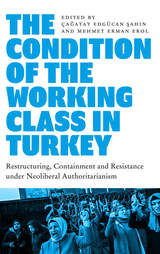 The Condition of the Working Class in Turkey: Labour under Neoliberal Authoritarianism
Çagatay Edgücan Sahin
Pluto Press, 2021 Decades of neoliberal authoritarianism have propelled Turkey into crisis. Regime change, economic disaster and Erdogan’s ambition to impose ‘one-man rule’ have shaken the foundations of Turkish political life, but what does this mean for workers?
Moving beyond the headlines and personalities, this book uncovers the real condition of the working class in modern Turkey. Combining field research and in-depth interviews, it offers cutting-edge analyses of workplace struggles, trade unionism, the AKP’s relationship with neoliberalism, migration, gender, agrarian change and precarity, as well as the Covid-19 pandemic and its impact on workers.
Bringing together Turkish activists and scholars, this book is an inside look at the dynamics and contradictions of working-class resistance against Turkey’s neoliberal authoritarian regime; from worker self-management to organized labor and rural struggles.
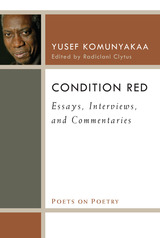 Condition Red: Essays, Interviews, and Commentaries
Yusef Komunyakaa; Edited by Radiclani Clytus
University of Michigan Press, 2017 Condition Red collects writing by one of America’s most gifted and revered poets, Yusef Komunyakaa. While themes from his earlier prose collection, Blue Notes, run through Condition Red, this volume expresses a greater sense of urgency about the human condition and the role of the artist. Condition Red includes his powerful letter to Poetry magazine, asserting that “we writers (artists) cannot forget that we are responsible for what we conjure and embrace through language, whether in essays, novels, plays, poems, or songs.” Also included are essays and interviews on: coming home to Bogalusa, Louisiana; the influence of religion on black poetry; language and eroticism; the visual artist Floyd Tunson; and the poets Robert Hayden, Walt Whitman, Clarence Major, and Etheridge Knight. The book features an extended introduction by editor Radiclani Clytus, who concludes that “Condition Red issues readers much more than a critical warning; it reminds us that our innate cultural capacity for language is, and always has been, the sum total of that which defines us.”
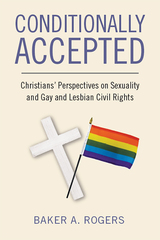 Conditionally Accepted: Christians' Perspectives on Sexuality and Gay and Lesbian Civil Rights
Baker A. Rogers
Rutgers University Press, 2020 This book explores Mississippi Christians’ beliefs about homosexuality and gay and lesbian civil rights and whether having a gay or lesbian friend or family member influences those beliefs. Beliefs about homosexuality and gay and lesbian rights vary widely based on religious affiliation. Despite having gay or lesbian friends or family members, evangelical Protestants believe homosexuality is sinful and oppose gay and lesbian rights. Mainline Protestants are largely supportive of gay and lesbian rights and become more supportive after getting to know gay and lesbian people. Catholics describe a greater degree of uncertainty and a conditional acceptance of gay and lesbian rights; clear differences between conservative and liberal Catholics are evident. Overall, conservative Christians, both evangelical Protestants and conservative Catholics, hold a religious identity that overshadows their relationships with gay and lesbian friends or family. Conservative religion acts as a deterrent to the positive benefits of relationships with gay and lesbian people.
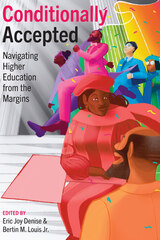 Conditionally Accepted: Navigating Higher Education from the Margins
Edited by Eric Joy Denise and Bertin M. Louis, Jr.
University of Texas Press, 2024 A collection of essays that provides advice and strategies for BIPOC scholars on how to survive, thrive, and resist in academic institutions. Conditionally Accepted builds upon an eponymous blog on InsideHigherEd.com, which is now a decade-old national platform for BIPOC academics in the United States. Bringing together perspectives from academics of color on navigating intersecting forms of injustice in the academy, each chapter offers situated knowledge about experiencing—and resisting—marginalization in academia. Contextualized within existing scholarship, these personal narratives speak to institutional betrayals while highlighting agency and sharing stories of surviving on treacherous terrain. Covering topics from professional development to the emptiness of diversity, equity, and inclusion efforts, and redefining what it means to be an academic in our contemporary moment, this edited collection directly confronts issues of systemic exclusion, discrimination, harassment, microaggressions, tokenism, and surveillance. Letting marginalized scholars know they are not alone, Conditionally Accepted offers concrete wisdom for readers seeking to navigate and transform oppressive academic institutions.
Conditions Handsome and Unhandsome: The Constitution of Emersonian Perfectionism: The Carus Lectures, 1988
Stanley Cavell
University of Chicago Press, 1991 In these three lectures, Cavell situates Emerson at an intersection of three crossroads: a place where both philosophy and literature pass; where the two traditions of English and German philosophy shun one another; where the cultures of America and Europe unsettle one another.
"Cavell's 'readings' of Wittgenstein and Heidegger and Emerson and other thinkers surely deepen our understanding of them, but they do much more: they offer a vision of what life can be and what culture can mean. . . . These profound lectures are a wonderful place to make [Cavell's] acquaintance."—Hilary Putnam
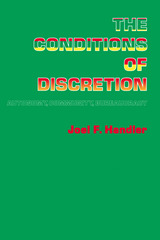 The Conditions of Discretion
Joel Handler
Russell Sage Foundation, 1986 This timely book is concerned with interactions between ordinary people and large public bureaucracies—interactions that typically are characterized by mutual frustration and antagonism. In fact, as Joel Handler points out, the procedural guidelines intended to ensure fairness and due process fail to take account of an initial imbalance of power and tend to create adversarial rather than cooperative relationships. When the special education needs of a handicapped child must be determined, parents and school administrators often face an especially painful confrontation. The Conditions of Discretion focuses on one successful approach to educational decision making (developed by the school district of Madison, Wisconsin) in order to illustrate how such interactions can be restructured and enhanced. Madison's creative plan regards parents as part of the solution, not the problem, and uses "lay advocates" to turn conflict into an opportunity for communication. Arrangements such as these, in Handler's analysis, exemplify the theoretical conditions under which discretionary decisions can be made fairly and with the informed participation of all concerned. The Conditions of Discretion offers not only a detailed case study, sympathetically described, but also persuasive assessments of major themes in contemporary legal and social policy—informed consent, bureaucratic change, social movement activity, the relationship of the individual to the state. From these strands, Handler weaves a significant new theory of cooperative decision making that integrates the public and the private, recognizes the importance of values, and preserves autonomy within community. "A masterful blend of social criticism, social sciences, and humane, constructive thought about the future of the welfare state." —Duncan Kennedy, Harvard Law School
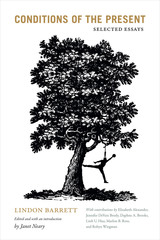 Conditions of the Present: Selected Essays
Lindon Barrett
Duke University Press, 2018 Conditions of the Present collects essays by the late Lindon Barrett, whose scholarship centers African American literature as a site from which to theorize race and liberation in the United States. Barrett confronts critical blind spots within both academic and popular discourse, offering readings of cultural and literary texts that transcend institutional divides and the gulf between academia and the street. Whether analyzing autobiographies by Lucy Delaney or Langston Hughes, hip-hop eulogies, or the formation of U.S. nationalist discourse, Barrett interrogates the mechanisms that shape social and subjective structures and that grant certain people power while withholding it from others. Deploying Marxist, psychoanalytic, feminist, and queer theories, Barrett explicates the interrelationship of desire and subjection to expose the violence and coercion embedded in narratives of "progress." Ultimately, this collection emphasizes Lindon Barrett's vital and enduring contribution to African American studies.
Contributors. Elizabeth Alexander, Jennifer DeVere Brody, Daphne A. Brooks, Linh U. Hua, Janet Neary, Marlon B. Ross, Robyn Wiegman
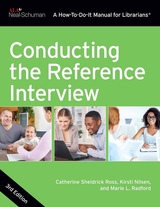 Conducting the Reference Interview
Catherine Sheldrick Ross
American Library Association, 2019 Based on the latest research in communication theory but tailored specifically for real-world application, this updated manual speaks equally to the needs of students preparing to enter the profession and those who are already fielding reference inquiries. The authors, working in consultation with a stellar advisory board of scholars and practitioners, present a convenient and comprehensive resource that will teach you how to understand the needs of public, academic, and special library users across any virtual setting—including email, text messaging, and social media—as well as in traditional and face-to-face models of communication. Packed with exercises and examples to help you practice effective reference transactions and avoid common pitfalls, this book - tackles the fundamentals of the reference interview, from why it’s important in the first place to methods for setting the stage for a successful interview and techniques for finding out what the library user really wants to know;
- covers the ins and outs of the readers’ advisory interview;
- examines a wide range of contexts, such as children, young adults, parents, seniors, adults from diverse communities, and those with disabilities;
- presents case studies of innovative reference and user encounters at a variety of libraries;
- offers updated coverage of virtual reference, including new research, virtual reality transcripts, and a look at crowd-sourcing reference via social media;
- features new content on common microaggressions, with guidance on how to use awareness of emotion as a factor in reference interactions to ensure better outcomes;
- discusses topics such as respecting/protecting privacy, overcoming assumptions, implicit judgment, the importance of context, determining the real information need, and many other lessons learned from challenging reference encounters; and
- thoroughly addresses policy and training procedures, as well as the unique challenges faced by paraprofessionals and non-degreed staff.
Find your bearings in the continually evolving hybrid reference environment through proven strategies, advice, exercises, and research from three experts in the field.
Conduction and Induction Heating
E.J. Davies
The Institution of Engineering and Technology, 1990 This book aims at a theoretical and practical treatment of both conduction and induction heating. They share a common theory, one being the 'mirror image' of the other, and so one gets two for the price of one.
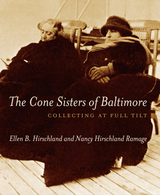 The Cone Sisters of Baltimore: Collecting at Full Tilt
Ellen B. Hirschland
Northwestern University Press, 2008 Over a period of fifty years, sisters Claribel and Etta Cone amassed one of the most acclaimed collections of late-nineteenth and twentieth-century art in America. Dr. Claribel and Miss Etta were two halves of an idiosyncratic team—Claribel bold and assertive and Etta reflective and sensitive—who used the fortunes of their German Jewish immigrant family to seek out works that inspired and pleased them, regardless of public opinion and with only self-taught expertise.
This richly illustrated biography documents their lives from a unique perspective: that of their great-niece, who wrote this book with her daughter. Ellen B. Hirschland and Nancy Hirschland Ramage delve into Claribel’s and Etta’s world, following the sisters through letters and personal stories as they travel to meet some of the artists whose works would turn their adjoining apartments into a gallery. They bought art by Manet, Gauguin, and Cézanne, as well as of Picasso and Matisse, whom they came to know well. The sisters’ experiences in Paris from 1901 through the 1920s provide an exceptional view of the bright artistic ferment in the city at that time. They were two Victorian women from Baltimore buying avant-garde masterpieces, attending salons with friends Gertrude and Leo Stein, and building a collection that would initially enrage the conservative people around them. Only with time would their keen eyes and unwavering taste prove them right.
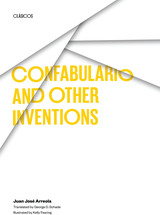 Confabulario and Other Inventions
By Juan José Arreola
University of Texas Press, 1964 This biting commentary on the follies of humankind by a noted Mexican author cuts deeply yet leaves readers laughing—at themselves as well as at others. With his surgical intelligence, Juan José Arreola exposes the shams and hypocrisies, the false values and vices, the hidden diseases of society. Confabulario total, 1941–1961, of which this book is a translation, combines three earlier books—Varia invención (1949), Confabulario (1952), Punta de plata (1958)—and numerous later pieces. Although some of the pieces have a noticeably Mexican orientation, most of them transcend strictly regional themes to interpret the social scene in aspects common to all civilized cultures. Arreola’s view is not limited; much of his sophistication comes from his broad, deep, and varied knowledge of present and past, and from his almost casual use both of this knowledge and of his insight into its meaning for humanity. His familiarity with many little-known arts and sciences, numerous literatures, history, anthropology, and psychology, and his telling allusions to this rich lode of fact, increase the reader’s delight in his learned but witty, scalding but poetic, satire.
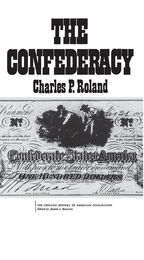 The Confederacy
Charles P. Roland
University of Chicago Press, 1962 The Confederacy was never single-minded. From the fateful year of 1861 until Appomattox, the South was a complex of heroism and cowardice, grief and frivolity, nationalism and state rights. But at the same time the Southern nation underwent a complete career from birth through maturity to death.
In The Confederacy Charles P. Roland is faithful to both the larger career and the internal complexity. Paying careful attention to President Davis' struggle against dividing forces within, the author skillfully narrates the attempt of the Confederacy to wage total war against superior forces. All the poignant events and conditions are here: the formation of the government, the upper South's final commitment to the cause, the doomed attempts to combat the Northern blockade at home and Northern diplomacy overseas, an agrarian economy's heroic defiance of an industrial enemy, the desperate measures by which the Davis government tried to sustain the Confederacy, and, at last, the dissolution and flight of the administration in 1865.
With accuracy, sensitivity, and balance, Mr. Roland develops the epic themes of his story against a background of vivid historical detail and re-creates the Confederacy with a tragic splendor—the prime quality of its surviving image among Southerners.
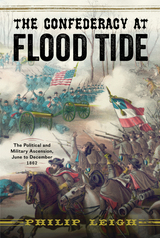 The Confederacy at Flood Tide: The Political and Military Ascension, June to December 1862
Philip Leigh
Westholme Publishing, 2016 The Fleeting Moment When the Confederate States of America Had the Best Opportunity to Achieve Independence and Why Their Efforts Failed
The first six months of 1862 provided a string of Federal victories in the West at Mill Springs, Fort Donelson, Pea Ridge, Island Number 10, and Shiloh. In May, New Orleans fell, and Union General George McClellan’s army was so close to the Confederate capital of Richmond, Virginia, that the troops could set their watches by the city’s church bells. But then the unexpected happened. In June, Robert E. Lee’s Army of Northern Virginia pushed McClellan’s much larger army back to the James River. In Europe, Confederate diplomats sought international recognition for the Confederate States of America, which was made even more attractive now that a shortage of cotton made the powerful textile interests anxious to end the war. Further tipping the balance, in July, the Confederacy secretly ordered two of the latest ironclad ships from England’s famous Laird Shipyard—the same yard that built the commerce raider Alabama. These steam-powered ironclads would be far superior to anything in the Federal navy.
While the “high tide” of the Confederacy is often identifed as Pickett’s Charge during the Battle of Gettysburg in July 1863, the most opportune time for the Confederacy vanished seven months earlier, coinciding with President Abraham Lincoln’s Emancipation Proclamation on January 1, 1863 and the failure of the secessionist states to be recognized as a sovereign nation. As Philip Leigh explains in his engrossing new book, The Confederacy at Flood Tide: The Political and Military Ascension, June to December 1862, on every battlefront and in the governmental halls of Europe, the Confederate effort reached its furthest extent during the second half of 1862. But with the president’s proclamation, battlefield reverses, Europe's decision to reject Confederate diplomatic overtures, and Britian's decision to halt the sale of the ironclads, the opportunity for Confederate success ended. The Confederacy would recede, and the great battles of 1863 and 1864 only marked the Southerners’ tenacity and stubborn belief in a lost cause.
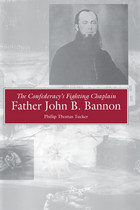 The Confederacy's Fighting Chaplain: Father John B. Bannon
Phillip Thomas Tucker
University of Alabama Press, 1992 1993 Douglas Southall Freeman History Award, sponsored by Military Order of the Stars and Bars
The Confederacy’s Fighting Chaplain is the remarkable story of the Irishman who brought the Bible and his own resourcefulness and daring to both the battlefield and the diplomatic field—a story that has been largely ignored for more than 130 years. The biography of John B. Bannon also chronicles the forgotten Southerners—the Irish immigrants of the Confederacy—whose colorful and crucial role in the Civil War has been seriously neglected. John B. Bannon was born in Ireland in 1829 and raised in peat-bog country. Educated at the Royal College of St. Patrick at Maynooth, he was ordained a priest in May 1853. Ireland was still suffering from the effects of the Potato Famine, which caused thousands of Irish to emigrate to the United States. In response to the need for Roman Catholic priests to minister to America’s immigrant population, Father Bannon was sent to the Archidiocese of St. Louis, Missouri, shortly after his ordination. Many of the Irish parishioners of St. Louis lived in a crowded corner of the city without money, assistance or land. Father Bannon soon became a leading civic and religious figure in St. Louis. An impressive character, he was described as a “handsome man, over six feet in height, with splendid form and intellectual face, courteous manners, and of great personal magnetism, conversing entertainingly and with originality and great wit, in a manner all his own.” By 1860, Missouri contained the second largest Irish population and the largest German population in the Southern and border states, and when the war reached Missouri, Father Bannon volunteered to serve on the battlefield by tending to the wounded and dying. During the war he served as chaplain-soldier in perhaps the finest combat unit on either side—the First Missouri Confederate Brigade. He impressed his fellow Confederates by attending the wounded at the front lines during battle, while most chaplains stayed to the rear. This tall, athletic man was a striking figure with his slouch had and butternut-colored uniform with a red cloth cross on the left shoulder. Various accounts praised the chaplain: A veteran wrote that the chaplain “was everywhere in the midst of battle when the fire was heaviest and the bullets thickest.” General Sterling Price wrote: “The greatest soldier I ever saw was Father Bannon. In the midst of the fray he would step in and take up a fallen soldier.” After the fall of Vicksburg, where Bannon had worked under dangerous fire, he journeyed to Richmond and received recognition and special diplomatic duties from President Jefferson Davis. Bannon conceived a brilliant strategy to gain recognition for the Confederacy from Pope Pius IX and thus open the door for recognition from Britain and France. On a mission for Davis he acted as a secret agent in Ireland during an all-important clandestine effort to stop the flood of Irish immigrants pouring into the Union armies at a critical time—before the decisive campaigns of 1864. After the war he joined the Jesuit order in Ireland, where he served until his death in 1913. The story of Father Bannon is indeed the story of the Missouri Irish Confederates, whose role in the conflict likewise has been neglected. Without doubt, Father Bannon stands out as an important religious-diplomatic personality of the Confederacy. Few men played such a distinguished and diverse role during the Civil War.
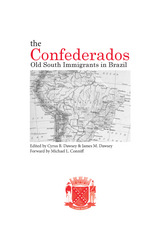 The Confederados: Old South Immigrants in Brazil
Cyrus B. Dawsey
University of Alabama Press, 1998 The story of exiles from the Confederate South who fled to Brazil after the US Civil War. The collection includes a previously unpublished narrative by an original settler In the wake of the American Civil War, thousands of disillusioned Southerners sought refuge far from Reconstruction’s reach—many found it in Brazil. The Confederados is a compelling exploration of this little-known migration, tracing the journey of Confederate exiles who forged new lives in the sugarcane fields of São Paulo. Through vivid personal narratives, scholarly essays, and rare archival insights, this volume uncovers the cultural, agricultural, and religious legacy these settlers left behind. From the harrowing voyage of Sarah Bellona Smith Ferguson to the enduring traditions of the Campo chapel, the book reveals how these Americans shaped—and were shaped by—their Brazilian surroundings. It examines their impact on education, Protestantism, and farming, and how their descendants maintain a distinct identity more than a century later. Richly illustrated and deeply researched, The Confederados is essential reading for anyone interested in Southern history, diaspora studies, or the global echoes of the Civil War. This is not just a story of exile—it’s a testament to resilience, adaptation, and the enduring ties between two nations.
Confederate Arkansas: The People and Policies of a Frontier State in Wartime
Michael B. Dougan
University of Alabama Press, 1990 This book fills a long standing gap in state histories dealing with the period of the Civil War in the western frontier that was Arkansas. Based on newspaper articles, legal documents, letters, diaries, reminiscences, songs, and official military reports, Dougan’s account provides a full picture of the political situation just prior to the war, and set the stage for the state’s entry into the war despite the fate that only a third of the population supported secession.
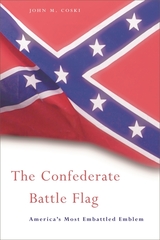 The Confederate Battle Flag: America’s Most Embattled Emblem
John M. Coski
Harvard University Press, 2006 In recent years, the Confederate flag has become as much a news item as a Civil War relic. Intense public debates have erupted over Confederate flags flying atop state capitols, being incorporated into state flags, waving from dormitory windows, or adorning the T-shirts and jeans of public school children. To some, this piece of cloth is a symbol of white supremacy and enduring racial injustice; to others, it represents a rich Southern heritage and an essential link to a glorious past. Polarizing Americans, these "flag wars" reveal the profound--and still unhealed--schisms that have plagued the country since the Civil War.
The Confederate Battle Flag is the first comprehensive history of this contested symbol. Transcending conventional partisanship, John Coski reveals the flag's origins as one of many banners unfurled on the battlefields of the Civil War. He shows how it emerged as the preeminent representation of the Confederacy and was transformed into a cultural icon from Reconstruction on, becoming an aggressively racist symbol only after World War II and during the Civil Rights movement. We gain unique insight into the fine line between the flag's use as a historical emblem and as an invocation of the Confederate nation and all it stood for. Pursuing the flag's conflicting meanings, Coski suggests how this provocative artifact, which has been viewed with pride, fear, anger, nostalgia, and disgust, might ultimately provide Americans with the common ground of a shared and complex history.
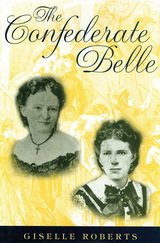 The Confederate Belle
Giselle Roberts
University of Missouri Press, 2003
While historians have examined the struggles and challenges that confronted the Southern plantation mistress during the American Civil War, until now no one has considered the ways in which the conflict shaped the lives of elite young women, otherwise known as belles. In The Confederate Belle, Giselle Roberts uses diaries, letters, and memoirs to uncover the unique wartime experiences of young ladies in Mississippi and Louisiana. In the plantation culture of the antebellum South, belles enhanced their family’s status through their appearance and accomplishments and, later, by marrying well.
During the American Civil War, a new patriotic womanhood superseded the antebellum feminine ideal. It demanded that Confederate women sacrifice everything for their beloved cause, including their men, homes, fine dresses, and social occasions, to ensure the establishment of a new nation and the preservation of elite ideas about race, class, and gender. As menfolk answered the call to arms, southern matrons had to redefine their roles as mistresses and wives. Southern belles faced a different, yet equally daunting, task. After being prepared for a delightful “bellehood,” young ladies were forced to reassess their traditional rite of passage into womanhood, to compromise their understanding of femininity at a pivotal time in their lives. They found themselves caught between antebellum traditions of honor and of gentility, a binary patriotic feminine ideal and wartime reality.
Rather than simply sacrificing their socialization for patriotic womanhood, belles drew upon southern honor to strengthen their understanding of themselves as young Confederate women. They used honor to shape and legitimize their obligations to the wartime household. They used honor to fashion their role as patriotic women. They even used honor to frame their relationship to the cause. By drawing upon this powerful concept, young ladies ensured the basic preservation of an ideology of privilege. Their unique Confederate bellehoods would ultimately shape the ways in which they viewed themselves and the changed social landscape during the conflict—and after it.
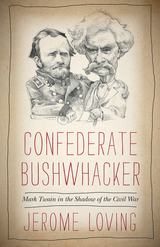 Confederate Bushwhacker: Mark Twain in the Shadow of the Civil War
Jerome Loving
University Press of New England, 2013 Confederate Bushwhacker is a microbiography set in the most important and pivotal year in the life of its subject. In 1885, Mark Twain was at the peak of his career as an author and a businessman, as his own publishing firm brought out not only the U.S. edition of Adventures of Huckleberry Finn but also the triumphantly successful Personal Memoirs of U. S. Grant. Twenty years after the end of the Civil War, Twain finally tells the story of his past as a deserter from the losing side, while simultaneously befriending and publishing the general from the winning side. Coincidentally, the year also marks the beginning of Twain’s descent into misfortune, his transformation from a humorist into a pessimist and determinist. Interwoven throughout this portrait are the headlines and crises of 1885—black lynchings, Indian uprisings, anti-Chinese violence, labor unrest, and the death of Grant. The year was at once Twain’s annus mirabilis and the year of his undoing. The meticulous treatment of this single year by the esteemed biographer Jerome Loving enables him to look backward and forward to capture both Twain and the country at large in a time of crisis and transformation.
Confederate Cavalry West of the River
By Stephen B. Oates
University of Texas Press, 1961 Another Confederate cavalry raid impends. You hear the snort of an impatient horse, the leathery squeaking of saddles, the low-voiced commands of officers, the muffled cluck of guns cocked in preparation—then the sudden rush of motion, the din of another attack. This classic story seeks to illuminate a little-known theater of the Civil War—the cavalry battles of the Trans-Mississippi West, a region that included Missouri, Arkansas, Texas, the Indian Territory, and part of Louisiana. Stephen B. Oates traces the successes and defeats of the cavalry; its brief reinvigoration under John S. "Rip" Ford, who fought and won the last battle of the war at Palmetto Ranch; and finally, the disintegration of this once-proud fighting force.
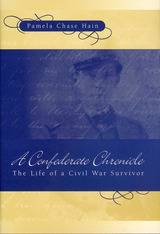 A Confederate Chronicle: The Life of a Civil War Survivor
Pamela Chase Hain
University of Missouri Press, 2005
A Confederate Chronicle presents the remarkable life of Thomas L. Wragg, who served in both the Confederate army and navy and endured incarceration as a prisoner of war. After the war, he undertook a series of jobs, eventually becoming a physician. In 1889, he died tragically at the hands of a man who mistakenly thought he was defending his family’s honor. Pamela Chase Hain uses Wragg’s letters home to his family, friends, and fiancée, as well as his naval notebook and newspaper articles, to give readers direct insight into his life and the lives of those around him.
The son of a respected Savannah physician, Wragg was born into a life of wealth and privilege. A nonconscripted soldier, he left home at eighteen to join the front lines in Virginia. From there, he sent letters home describing the maneuverings of General Joseph E. Johnston’s army in and around Harpers Ferry and Winchester, culminating with the Battle of Bull Run.
In the fall of 1862, Wragg joined the Confederate Navy and trained on the ironclad CSS Georgia before transferring to the CSS Atlanta. Hain uses the notebook that he kept during his training in ordnance and gunnery to provide a rare glimpse into the naval and artillery practices at the time. This notebook also provides evidence of a fledgling Confederate naval “school” prior to the one established on the James River on the CSS Patrick Henry.
The crew of the unfortunate Atlanta was captured on the ship’s maiden voyage, and evidence in the Wragg family papers suggests the capture was not the result of bad luck, as has been claimed. Wragg and the other officers were sent to Fort Warren Prison in Boston Harbor for fifteen months. Wragg’s POW letters reveal the isolation and sense of abandonment the prisoners felt as they waited in hopes of an exchange. The correspondence between Wragg and his fiancée, Josie, after the war illustrates not only the mores of nineteenth-century courtship but also the difficulty of adjustment that many Confederate war veterans faced.
Sadly, Wragg’s life was cut short after he became a successful doctor in Quincy, Florida. Cover-up and intrigue by influential citizens prevented Wragg’s wife from bringing the murderer to justice. A Confederate Chronicle offers an unprecedented look at how the Civil War affected the gentry class of the South. It gives readers a personal view into one man’s struggle with the chaos of life during and after the war, as well as into the struggles of the general society.
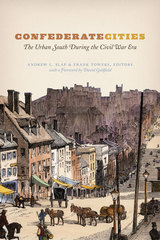 Confederate Cities: The Urban South during the Civil War Era
Edited by Andrew L. Slap and Frank Towers
University of Chicago Press, 2015 When we talk about the Civil War, we often describe it in terms of battles that took place in small towns or in the countryside: Antietam, Gettysburg, Bull Run, and, most tellingly, the Battle of the Wilderness. One reason this picture has persisted is that few urban historians have studied the war, even though cities hosted, enabled, and shaped Southern society as much as they did in the North.
Confederate Cities, edited by Andrew L. Slap and Frank Towers, shifts the focus from the agrarian economy that undergirded the South to the cities that served as its political and administrative hubs. The contributors use the lens of the city to examine now-familiar Civil War–era themes, including the scope of the war, secession, gender, emancipation, and war’s destruction. This more integrative approach dramatically revises our understanding of slavery’s relationship to capitalist economics and cultural modernity. By enabling a more holistic reading of the South, the book speaks to contemporary Civil War scholars and students alike—not least in providing fresh perspectives on a well-studied war.
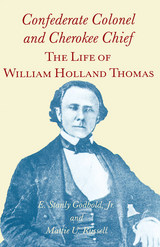 Confederate Colonel and Cherokee Chief: The Life of William Holland Thomas
E. Stanly Godbold, Jr.
University of Tennessee Press, 2002 William Holland Thomas (1805-1893) was a unique transcultural figure. A white man from western North Carolina, he was adopted by a small Cherokee Indian band and later became its chief. Equally at home in a drawing room or at a Green Corn Dance, Thomas served as agent for the Oconaluftee Indians in Washington, protecting them from removal to the West in 1838 along the infamous Trail of Tears. Thomas was also a frontier merchant, a builder of railroads and turnpikes, a wealthy owner of land and slaves, a state senator, and a Confederate colonel in the Civil War, in which he commanded a legion of Cherokees and white Appalachians.
In this first published biography of Thomas, the authors depict nineteenth-century America at a turning point and document a human tragedy. An influential businessman and politician who enjoyed a storybook courtship and marriage, Thomas came to ruin when—as a member of the North Carolina secession convention—he committed his loyalty toward his people, family, and region to the hopeless cause of the Confederacy. This investigation of Thomas’s life also reveals much about the culture and plight of the Cherokees, their experience with removal, their legal battle to “legitimize” themselves as citizens of North Carolina, and their role in the Civil War.
Confederate Colonel and Cherokee Chief will be of interest to students of the Civil War and of Native American, North Carolina, Appalachian, and Southern history.
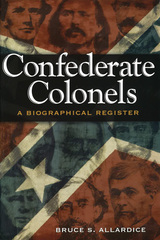 Confederate Colonels: A Biographical Register
Bruce S. Allardice
University of Missouri Press, 2008 Among field officers in the Confederate Army, colonels had the greatest life-or-death power over the average soldier. Usually regimental commanders who were charged with instructing their men in drill, many also led brigades or divisions, and the influence of an outstanding colonel could be recognized throughout the army. While several books have dealt with the Confederacy’s generals, this is the first comprehensive study of its colonels. Bruce S. Allardice has undertaken exhaustive research to uncover a wealth of facts not previously available and to fill in many gaps in previous scholarship on the 1,583 men who achieved the rank of full colonel by the end of their careers—including both staff and line officers and members of all armies. A biographical article on each man includes such data as date and place of birth, education, prewar occupation and military experience, service record, instances of being wounded or captured, postwar life and death, and available writings on the officer or manuscript collections of his papers. Throughout, Allardice follows Confederate law and surviving government records in determining an officer’s true rank, and he uses the regimental designations from the compiled service records in the National Archives as the most familiar to researchers. Appendixes list state army colonels, colonels who became generals, and colonels whose rank cannot be proved. In his introduction, Allardice gives readers a clear understanding of the characteristics of a colonel in the Confederacy. He explains how one became a colonel—the mustering process, election of officers, reorganizing of regiments—and exposes the inadequacies of the officer-nominating process, questions of seniority, and problems of “rank inflation.” He highlights such notable figures as John S. Mosby, the “Grey Ghost,” and George Smith Patton, great-grandfather of WWII general George S. Patton, and also provides statistics on such matters as states of origin, age, and casualties. This single-volume compendium sheds new light on these interesting and important military figures and features more standard information than can be found in similar references. Confederate Colonels belongs at the side of every Civil War historian or buff, whether as a research tool or as a touchstone for other readings.
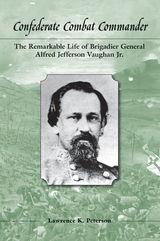 Confederate Combat Commander: The Remarkable Life of Brigadier General Alfred Jefferson Vaughan, Jr.
Lawrence K. Peterson
University of Tennessee Press, 2013 Known as one of the most aggressive Confederate officers in the Western Theater, Brigadier General Alfred Jefferson Vaughan Jr. is legendary for having had eight horses shot out from under him in battle—more than any other infantry commander, Union or Confederate. Yet despite the exceptional bravery demonstrated by his dubious feat, Vaughan remains a largely overlooked Civil War leader.
In Confederate Combat Commander, Lawrence K. Peterson explores the life of this unheralded yet important rebel officer before, during, and after his military service. A graduate of Virginia Military Institute, Vaughan initially commanded the Thirteenth Tennessee Infantry Regiment, and later Vaughan’s Brigade. He served in the hard-fought battles of the western area of operations in such key confrontations as Shiloh, Perryville, Stones River, Chickamauga, Chattanooga, and the Atlanta Campaign.
Tracing Vaughan’s progress through the war and describing his promotion to general after his commanding officer was mortally wounded, Peterson describes the rise and development of an exemplary military career, and a devoted fighting leader. Although Vaughan was beloved by his troops and roundly praised at the time—in fact, negative criticism of his orders, battlefield decisions, or personality cannot be found in official records, newspaper articles, or the diaries of his men—Vaughan nevertheless served in the much-maligned Army of Tennessee. This book thus assesses what responsibility—if any—Vaughan bore for Confederate failures in the West.
While biographies of top-ranking Civil War generals are common, the stories of lower-level senior officers such as Vaughan are seldom told. This volume provides rare insight into the regimental and brigade-level activities of Civil War commanders and their units, drawing on a rich array of privately held family histories, including two written by the general himself.
Lawrence K. Peterson, a retired airline pilot, worked as a National Park Service ranger and USAF officer. He is the great-great grandson of Brigadier General Alfred Jefferson Vaughan Jr.
The Confederate Constitution of 1861: An Inquiry into American Constitutionalism
Marshall L. DeRosa
University of Missouri Press, 1991 In The Confederate Constitution of 1861, Marshall DeRosa argues that the Confederate Constitution was not, as is widely believed, a document designed to perpetuate a Southern "slaveocracy," but rather an attempt by the Southern political leadership to restore the Anti-Federalist standards of limited national government. In this first systematic analysis of the Confederate Constitution, DeRosa sheds new light on the constitutional principles of the CSA within the framework of American politics and constitutionalism. He shows just how little the Confederate Constitution departed from the U.S. Constitution on which it was modeled and examines closely the innovations the delegates brought to the document.
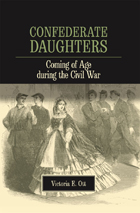 Confederate Daughters: Coming of Age during the Civil War
Victoria E. Ott
Southern Illinois University Press, 2008 Confederate Daughters: Coming of Age during the Civil War explores gender, age, and Confederate identity by examining the lives of teenage daughters of Southern slaveholding, secessionist families. These young women clung tenaciously to the gender ideals that upheld marriage and motherhood as the fulfillment of female duty and to the racial order of the slaveholding South, an institution that defined their status and afforded them material privileges. Author Victoria E. Ott discusses how the loyalty of young Southern women to the fledgling nation, born out of a conservative movement to preserve the status quo, brought them into new areas of work, new types of civic activism, and new rituals of courtship during the Civil War. Social norms for daughters of the elite, their preparation for their roles as Southern women, and their material and emotional connections to the slaveholding class changed drastically during the Civil War. When differences between the North and South proved irreconcilable, Southern daughters demonstrated extraordinary agency in seeking to protect their futures as wives, mothers, and slaveholders. From a position of young womanhood and privilege, they threw their support behind the movement to create a Confederate identity, which was in turn shaped by their participation in the secession movement and the war effort. Their political engagement is evident from their knowledge of military battles, and was expressed through their clothing, social activities, relationships with peers, and interactions with Union soldiers. Confederate Daughters also reveals how these young women, in an effort to sustain their families throughout the war, adjusted to new domestic duties, confronting the loss of slaves and other financial hardships by seeking paid work outside their homes. Drawing on their personal and published recollections of the war, slavery, and the Old South, Ott argues that young women created a unique female identity different from that of older Southern women, the Confederate bellehood. This transformative female identity was an important aspect of the Lost Cause mythology—the version of the conflict that focused on Southern nationalism—and bridged the cultural gap between the antebellum and postbellum periods. Augmented by twelve illustrations, this book offers a generational understanding of the transitional nature of wartime and its effects on women’s self-perceptions. Confederate Daughters identifies the experiences of these teenage daughters as making a significant contribution to the new woman in the New South.
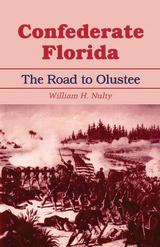 Confederate Florida: The Road to Olustee
William H. Nulty
University of Alabama Press, 1990 A new look at the engagement at Olustee, Florida
At the end of 1863 the Federal forces in the Department of the South were tied up in siege operations against Charleston and Savannah, operations that showed little progress or promise. The commander of the Department, Major General Quincy A. Gillmore, led an expedition into Florida to recruit blacks, cut off commissary supplies headed for other parts of the Confederacy, and disrupt the railroad system within Florida. Expedition forces landed at Jacksonville on February 7, 1864. The engagement at Olustee, not far from Gainesville, took place on February 20, 1864. it was the largest Civil War battle in Florida and one of the bloodiest Union defeats of the entire war. Nonetheless, because the engagement forced the Confederacy to divert 15,000 men from the thinly manned defense of Charleston and Savannah, it delayed critical reinforcement of the Army of Tennessee, which was fighting desperately to prevent the Union invasion of northwestern Georgia. Makin use of detailed maps and diagrams, Nulty presents a vivid account of this fascination Civil War effort.
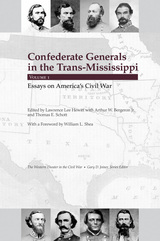 Confederate Generals in the Trans-Mississippi, Vol 1: Essays on America's Civil War
Lawrence L. Hewitt
University of Tennessee Press, 2013 Until relatively recently, conventional wisdom held that the Trans-Mississippi Theater was a backwater of the American Civil War. Scholarship in recent decades has corrected this oversight, and a growing number of historians agree that the events west of the Mississippi River proved integral to the outcome of the war. Nevertheless, generals in the Trans-Mississippi have received little attention compared to their eastern counterparts, and many remain mere footnotes to Civil War history. This welcome volume features cutting-edge analyses of eight Southern generals in this most neglected theater—Thomas Hindman, Theophilus Holmes, Edmund Kirby Smith, Mosby Monroe Parsons, John Marmaduke, Thomas James Churchill, Thomas Green, and Joseph Orville Shelby—providing an enlightening new perspective on the Confederate high command.
Although the Trans-Mississippi has long been considered a dumping ground for failed generals from other regions, the essays presented here demolish that myth, showing instead that, with a few notable exceptions, Confederate commanders west of the Mississippi were homegrown, not imported, and compared well with their more celebrated peers elsewhere. With its virtually nonexistent infrastructure, wildly unpredictable weather, and few opportunities for scavenging, the Trans-Mississippi proved a challenge for commanders on both sides of the conflict. As the contributors to this volume demonstrate, only the most creative minds could operate successfully in such an unforgiving environment.
While some of these generals have been the subjects of larger studies, others, including Generals Holmes, Parsons, and Churchill, receive their first serious scholarly attention in these pages. Clearly demonstrating the independence of the Trans-Mississippi and the nuances of the military struggle there, while placing both the generals and the theater in the wider scope of the war, these eight essays offer valuable new insight into Confederate military leadership and the ever-vexing questions of how and why the South lost this most defining of American conflicts.
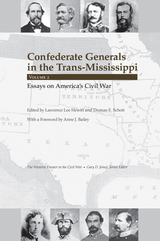 Confederate Generals in the Trans-Mississippi, vol. 2
Lawrence Lee Hewitt
University of Tennessee Press, 2015 In contrast to Robert E. Lee’s Army of Northern Virginia, the armies and events of the Civil War’s Trans-Mississippi Theater have received scant historical attention, to the detriment of our understanding not only of individuals and events west of the Mississippi River, but also to the east of it. In Confederate Generals in the Trans-Mississippi, Volume 2, noted Civil War historians offer fresh scholarship on eight generals who made names for themselves in the region, providing intriguing insight into important wartime issues in the Trans-Mississippi and beyond.
Contrary to popular belief, the Trans-Mississippi did not serve as a dumping ground for generals who had failed in Virginia. Instead, the majority of generals who served in the region were homegrown and faced challenges unknown to their counterparts in the East—expansive territory, few men, and limited transportation for the meager supplies available. Superior Union numbers in the West, however, did not guarantee Union victory. As these essays show, southern generals often beat themselves because of personal failings or an inability to work together. Sterling Price and Ben McCulloch refused to cooperate, Henry Sibley combined alcoholism with cowardice, and the able French-born Prince de Polignac faced language barriers. The war ended before Joseph Brent, a visionary regarding tank warfare, could make his name as a brigadier, and “Prince John” Magruder’s achievements in Texas remain overshadowed by his earlier career in Virginia. The Cajun Alfred Mouton, a superior leader, died on a battlefield in his native Louisiana, while Mosby Parsons survived the war only to be murdered by Mexican cavalry. While some of these generals breathed life into the Confederacy, others hastened its downfall.
By chronicling the lives and careers of these eight generals, this welcome volume integrates the Trans-Mississippi more fully with the Western Theater and illuminates critical issues vital to understanding the South’s ultimate defeat.
Lawrence Lee Hewitt is professor of history emeritus at Southeastern Louisiana University. He is the author of Port Hudson: Confederate Bastion on the Mississippi and coeditor of six anthologies dealing with America’s Civil War.
Thomas E. Schott worked as a historian for the Department of Defense. He is the author of Alexander H. Stephens of Georgia: A Biography, winner of the Jefferson Davis Award, and coeditor with Lawrence Hewitt of Lee and His Generals: Essays in Honor of T. Harry Williams.
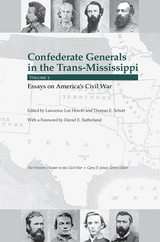 Confederate Generals in the Trans-Mississippi, Vol 3: Essays on America's Civil War
Thomas E. Schott
University of Tennessee Press, 2019 Far removed from the main centers of commerce and population, and thus remote from the priorities of Confederate political leaders in the East, the Trans-Mississippi Theater experienced a different sort of war during America’s great fratricidal conflict of 1861–1865. Not only was its distance from Richmond a distinguishing factor, but it was also a theater where the Union army and navy gained a foothold far sooner than elsewhere in the South, first in Missouri and then in Louisiana and the Mississippi River Valley. Confederate generals were tasked with ousting, not merely halting, an enemy closing from two directions; guerrilla warfare was more often the norm than the exception; and the shortage of men and materiel was a constant problem.
The third volume of Confederate Generals in the Trans-Mississippi offers eight new essays on generals engaged in the effort to secure a region whose unique challenges would have daunted the best of commanders. Included here are Joseph G. Dawson III on Earl Van Dorn’s efforts to bring order to the chaos of the Trans-Mississippi District and how his experiences affected his battlefield performance in 1862; Jeffery M. Prushankin on the administrative nightmares facing Edmund Kirby Smith when he assumed responsibility for the region in 1863; and Richard Holloway on the formidable army commander Richard Taylor and the all-but-forgotten effort to move Confederate troops east of the Mississippi in 1864. Essays on Hamilton Prioleau Bee, James Fleming Fagan, William Robertson Boggs, Tom Green, and Austin Wharton round out the collection.
Like its predecessors, this new volume brings splendid research and a wealth of new insight and analysis to bear on an aspect of the Civil War whose historical significance has too long been overshadowed by the events farther east.
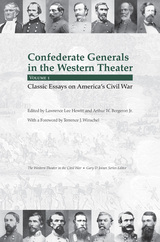 Confederate Generals in the Western Theater, Vol. 1: Classic Essays on America’s Civil War
Lawrence L. Hewitt
University of Tennessee Press, 2010 This collection, the first of several projected volumes, brings together some of the best previously published essays on Confederate commanders in the Western Theater. Including articles by such distinguished historians as Grady McWhiney, Charles P. Roland, T. Harry Williams, Frank E. Vandiver, Archer Jones, and Edwin C. Bearss, many of these pieces have only appeared in academic journals, and most have long been out of print. In resurrecting them, this volume introduces a new generation of readers to some of the mid–twentieth century’s most significant Civil War scholarship.
As part of a new series, The Western Theater in the Civil War, this volume reflects the premise that truly understanding the outcome of the war can only be gained through greater knowledge of the western campaigns and the generals who waged them. The essays gathered here—such as Roland’s reassessment of Albert Sidney Johnston, Williams’s examination of P. G. T. Beauregard’s role at Shiloh, Bearss’s look at Bedford Forrest’s great tactical victory at Brice’s Cross Roads, and Vandiver’s analysis of John Bell Hood’s use of logistics—are admirable contributions to this goal. Significantly, in addition to highlighting the Western Theater’s best-known generals, this volume also includes essays on two of its less familiar ones, Patton Anderson and Daniel C. Govan, thus rescuing these fascinating figures from undeserved oblivion.
Future volumes of Confederate Generals in the Western Theater will showcase the latest scholarship with new essays written expressly for the series. By gathering classic earlier work between one set of covers, this opening foray sets a high standard indeed.
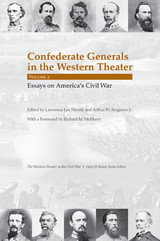 Confederate Generals in the Western Theater, Vol. 2: Essays on America's Civil War
Lawrence L. Hewitt
University of Tennessee Press, 2010
Many students of the Civil War have concluded that the overstudied conflict in the Eastern Theater resulted only in an unwinnable stalemate. For that reason they are now looking to the West for more precise explanations of the Confederates’ failure to win independence. To editors Lawrence Hewitt and Arthur Bergeron, the answers lie with the generals who waged a calamitous war that stretched across nine states and left a long trail of bloody battlefields, surrendered fortresses, burned cities, wrecked infrastructure, and, ultimately, a lost cause.
For this book, which follows an earlier volume of previously published essays, Hewitt and Bergeron have enlisted ten gifted historians—among them James M. Prichard, Terrence J. Winschel, Craig Symonds, and Stephen Davis—to produce original essays, based on the latest scholarship, that examine the careers and missteps of several of the Western Theater’s key Rebel commanders. Among the important topics covered are George B. Crittenden’s declining fortunes in the Confederate ranks, Earl Van Dorn’s limited prewar military experience and its effect on his performance in the Baton Rouge Campaign of 1862, Joseph Johnston’s role in the fall of Vicksburg, and how James Longstreet and Braxton Bragg’s failure to secure Chattanooga paved the way for the Federals’ push into Georgia.
Confederate Generals in the Western Theater will ultimately comprise several volumes that promise a host of provocative new insights into not only the South’s ill-fated campaigns in the West but also the eventual outcome of the larger conflict.
Lawrence Lee Hewitt is professor of history emeritus at Southeastern Louisiana University. A recipient of SLU’s President’s Award for Excellence in Research and the Charles L. Dufour Award for outstanding achievements in preserving the heritage of the American Civil War, he is a former managing editor of North & South. His publications include Port Hudson: Confederate Bastion on the Mississippi.
Arthur W. Bergeron Jr. is a reference historian with the United States Army Military History Institute and a past president of the Louisiana Historical Association. Among his earlier books are Confederate Mobile and A Thrilling Narrative: The Memoir of a Southern Unionist.
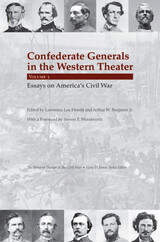 Confederate Generals in the Western Theater, Vol. 3: Essays on America’s Civil War
Lawrence L. Hewitt and Arthur W. Bergeron Jr.
University of Tennessee Press, 2011
@font-face { font-family: "Times New Roman";}p.MsoNormal, li.MsoNormal, div.MsoNormal { margin: 0in 0in 0.0001pt; line-height: 200%; font-size: 12pt; font-family: Times; }table.MsoNormalTable { font-size: 10pt; font-family: "Times New Roman"; }div.Section1 { page: Section1; }
The American Civil War was won and lost on its western battlefields, but accounts of triumphant Union generals such as Grant and Sherman leave half of the story untold. In the third volume of Confederate Generals in the Western Theater, editors Lawrence Hewitt and Arthur Bergeron bring together ten more never-before-published essays filled with new, penetrating insights into the key question of why the Rebel high command in the West could not match the performance of Robert E. Lee in the East.
Showcasing the work of such gifted historians as Wiley Sword, Timothy B. Smith, Rory T. Cornish, and M. Jane Johansson, this book is a compelling addition to an ongoing, collective portrait of generals who occasionally displayed brilliance but were more often handicapped by both geography and their own shortcomings. While the vast, varied terrain of the Western Theater slowed communications and troop transfers and led to the creation of too many military departments that hampered cooperation among commands, even more damaging were the personal qualities of many of the generals. All too frequently, incompetence, egotism, and insubordination were the rule rather than the exception. Some of these men were undone by alcoholism and womanizing, others by politics and nepotism. A few outlived their usefulness; others were killed before they could demonstrate their potential. Together, they destroyed what chance the Confederacy had of winning its independence.
Whether adding fresh fuel to the debate over the respective roles of Albert Sidney Johnston and P. G. T. Beauregard at Shiloh or bringing to light such lesser known figures as Joseph Finegan and Hiram Bronson Granbury, this volume, like the ones preceding it, is an exemplary contribution to Civil War scholarship.
Lawrence Lee Hewitt is professor of history emeritus at Southeastern Louisiana University. A recipient of SLU’s President’s Award for Excellence in Research and the Charles L. Dufour Award for “outstanding achievements in preserving the heritage of the American Civil War,” he is a former managing editor of North & South. His publications include Port Hudson: Confederate Bastion on the Mississippi.
The late Arthur W. Bergeron Jr. was a reference historian with the United States Army Military History Institute and a past president of the Louisiana Historical Association. Among his earlier books were Confederate Mobile and A Thrilling Narrative: The Memoir of a Southern Unionist.
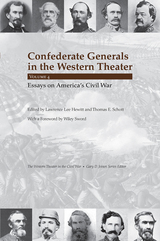 Confederate Generals in the Western Theater, vol. 4: Essays on America's Civil War
Lawrence Lee Hewitt
University of Tennessee Press, 2018 Like its predecessors, the fourth and final volume of Confederate Generals in the Western Theater is an invaluable contribution to the historiography of a poorly understood theater of war, presenting new interpretations of major figures while bringing to light both the triumphs and failures of lesser-known generals. Its cutting-edge scholarship offers further grounding for the editors’ contention that the South’s bid for independence was lost on its western battlefields and that the responsibility for those defeats lay more with the Confederate generals than with their opponents.
Among the ten chapters, this collection includes C. David Dalton on the death of Felix Zollicoffer at the Battle of Mill Springs in Kentucky; Roger Durham on Robert E. Lee’s leadership early in the war of the Department of South Carolina, Georgia, and East Florida; Brian S. Wills on Abraham Buford’s behind-the-scenes contributions to Nathan Bedford Forrest’s famous exploits; the late Nathaniel Cheairs Hughes Jr. on the achievements and failings of Gideon J. Pillow; James M. Prichard on John Hunt Morgan and his “last Kentucky raid”; and Keith S. Bohannon on Edward C. Walthall, a Virginia lawyer who overcame his lack of prior military experience to become one of the ablest generals in any of the war’s theaters. Some essays offer full biographies of their subjects; others focus on a single campaign. Along with the previous volumes, this exemplary collection encourages an important rethinking of the course of the Civil War and its ultimate outcome.
Lawrence Lee Hewitt is professor of history emeritus at Southeastern Louisiana University. He is the author of Port Hudson, Confederate Bastion on the Mississippi, among other publications, and his honors include the 2013 Nevins-Freeman Award for the “advancement of American Civil War scholarship and support for the Round Table movement.”
Thomas E. Schott worked as a historian for the Department of Defense. He is the author of Alexander H. Stephens of Georgia: A Biography, which won the Jefferson Davis Award. He is coeditor and contributor with Lawrence Hewitt of Lee and His Generals: Essays in Honor of T. Harry Williams, as well as several volumes of Confederate Generals in the Western Theater and Confederate Generals in the Trans-Mississippi.
 Confederate Generals in the Western Theater, vol. 4: Essays on America's Civil War
Lawrence Lee Hewitt
University of Tennessee Press Like its predecessors, the fourth and final volume of Confederate Generals in the Western Theater is an invaluable contribution to the historiography of a poorly understood theater of war, presenting new interpretations of major figures while bringing to light both the triumphs and failures of lesser-known generals. Its cutting-edge scholarship offers further grounding for the editors’ contention that the South’s bid for independence was lost on its western battlefields and that the responsibility for those defeats lay more with the Confederate generals than with their opponents.
Among the ten chapters, this collection includes C. David Dalton on the death of Felix Zollicoffer at the Battle of Mill Springs in Kentucky; Roger Durham on Robert E. Lee’s leadership early in the war of the Department of South Carolina, Georgia, and East Florida; Brian S. Wills on Abraham Buford’s behind-the-scenes contributions to Nathan Bedford Forrest’s famous exploits; the late Nathaniel Cheairs Hughes Jr. on the achievements and failings of Gideon J. Pillow; James M. Prichard on John Hunt Morgan and his “last Kentucky raid”; and Keith S. Bohannon on Edward C. Walthall, a Virginia lawyer who overcame his lack of prior military experience to become one of the ablest generals in any of the war’s theaters. Some essays offer full biographies of their subjects; others focus on a single campaign. Along with the previous volumes, this exemplary collection encourages an important rethinking of the course of the Civil War and its ultimate outcome.
Lawrence Lee Hewitt is professor of history emeritus at Southeastern Louisiana University. He is the author of Port Hudson, Confederate Bastion on the Mississippi, among other publications, and his honors include the 2013 Nevins-Freeman Award for the “advancement of American Civil War scholarship and support for the Round Table movement.”
Thomas E. Schott worked as a historian for the Department of Defense. He is the author of Alexander H. Stephens of Georgia: A Biography, which won the Jefferson Davis Award. He is coeditor and contributor with Lawrence Hewitt of Lee and His Generals: Essays in Honor of T. Harry Williams, as well as several volumes of Confederate Generals in the Western Theater and Confederate Generals in the Trans-Mississippi.
|
|


